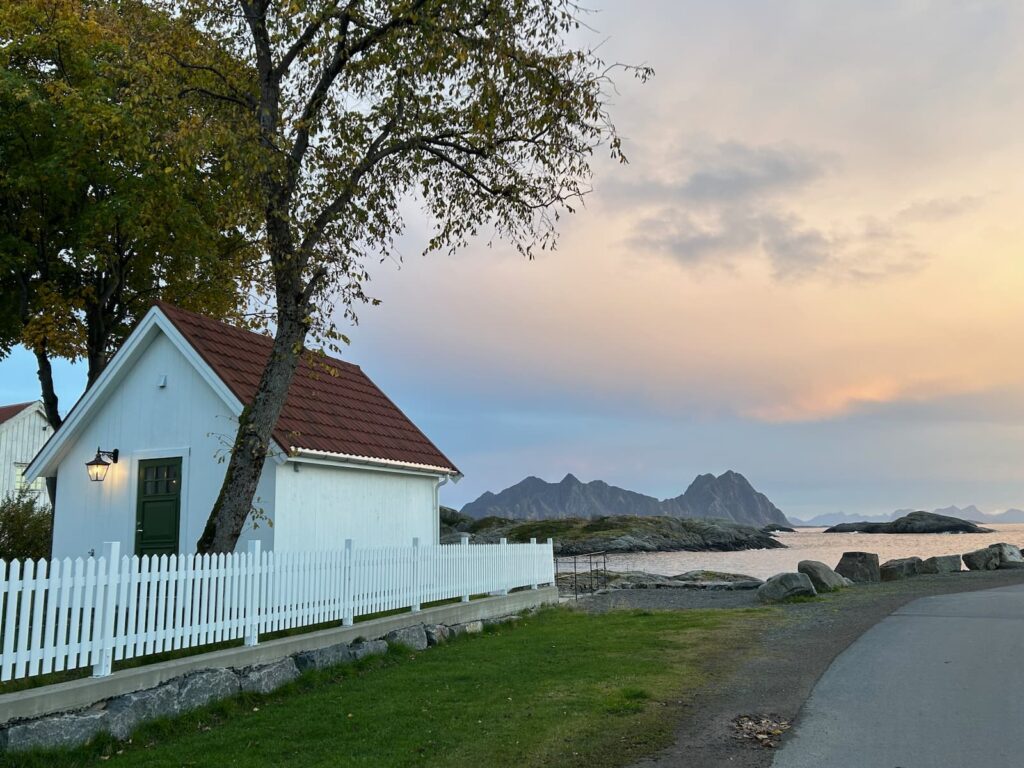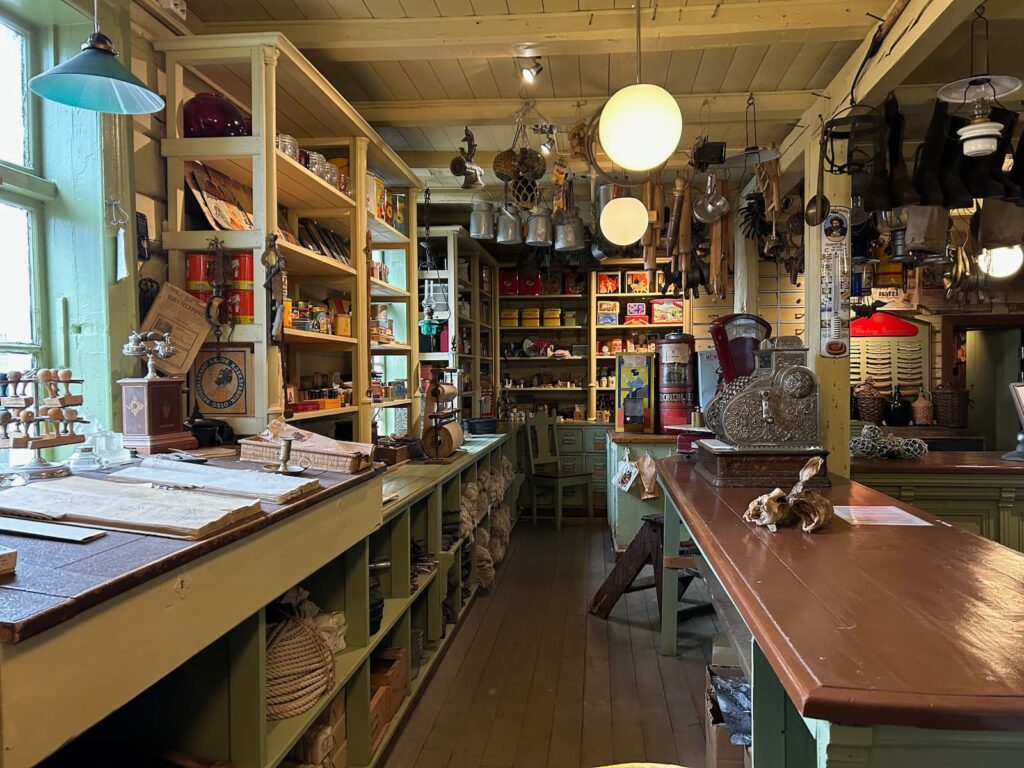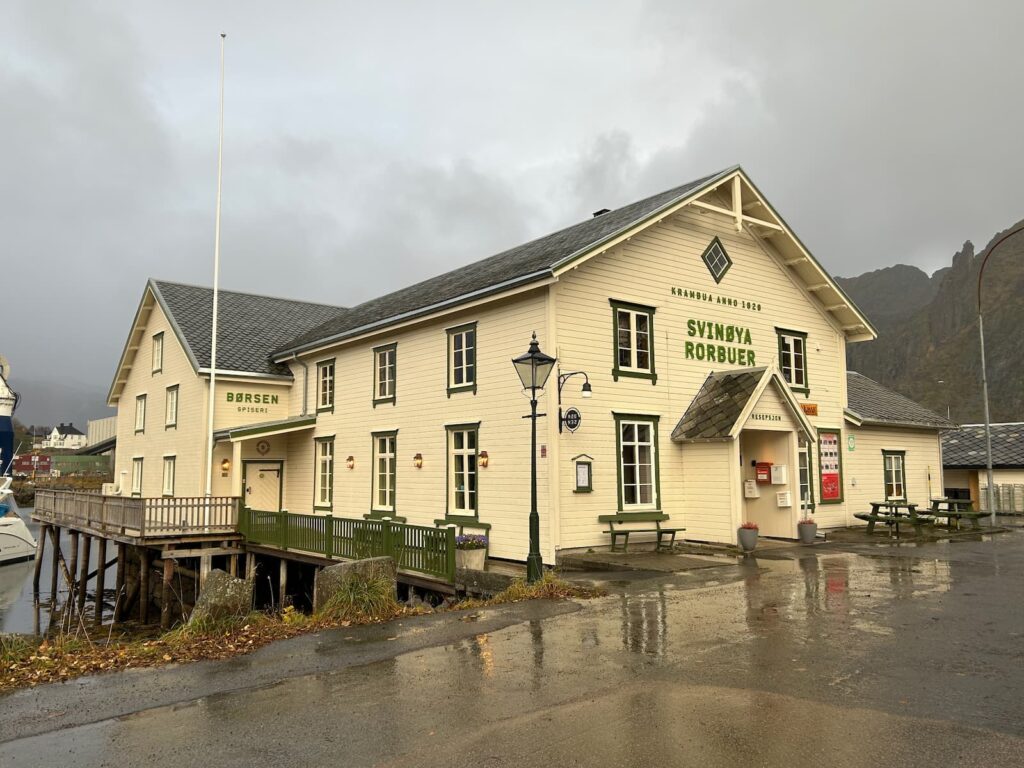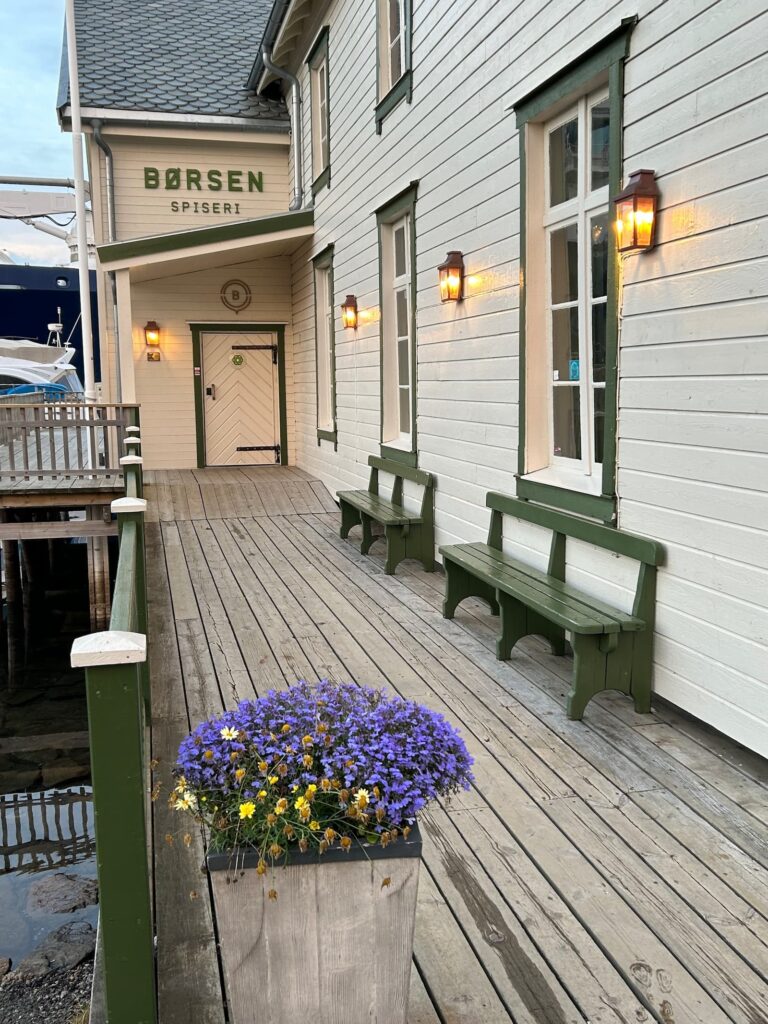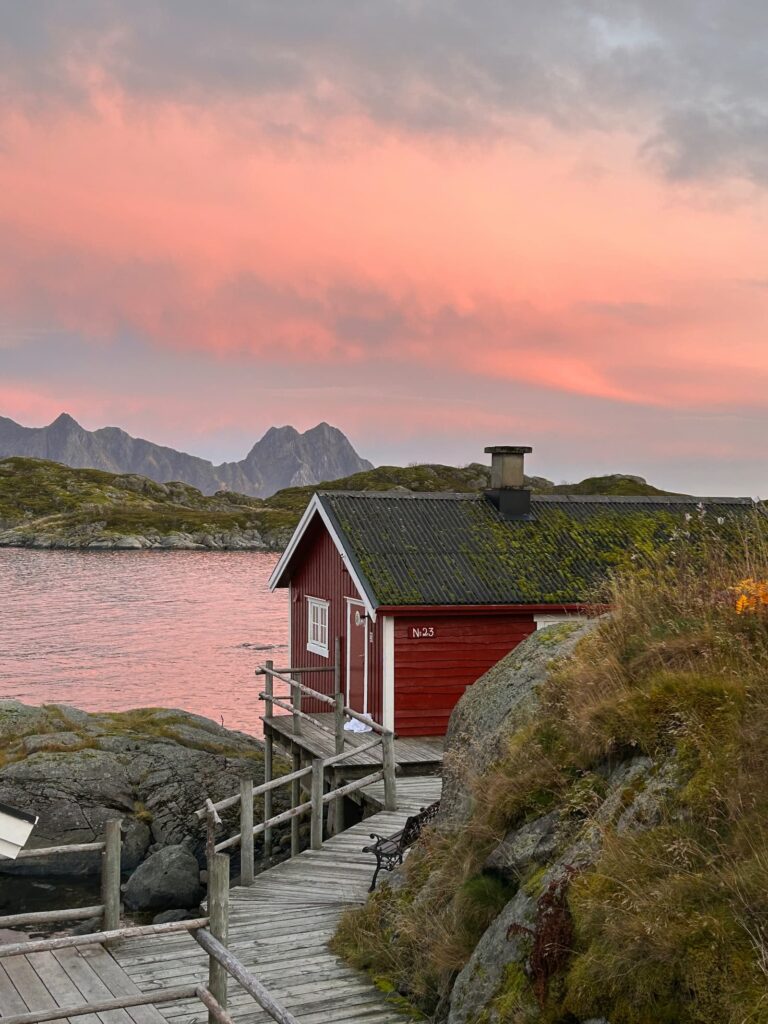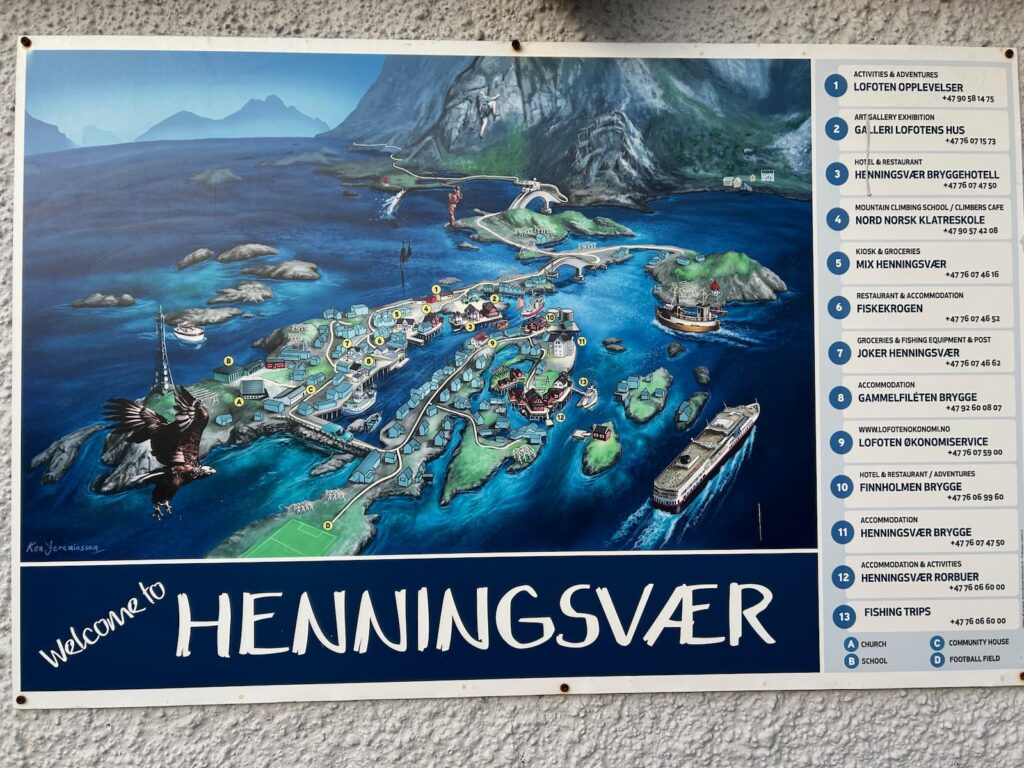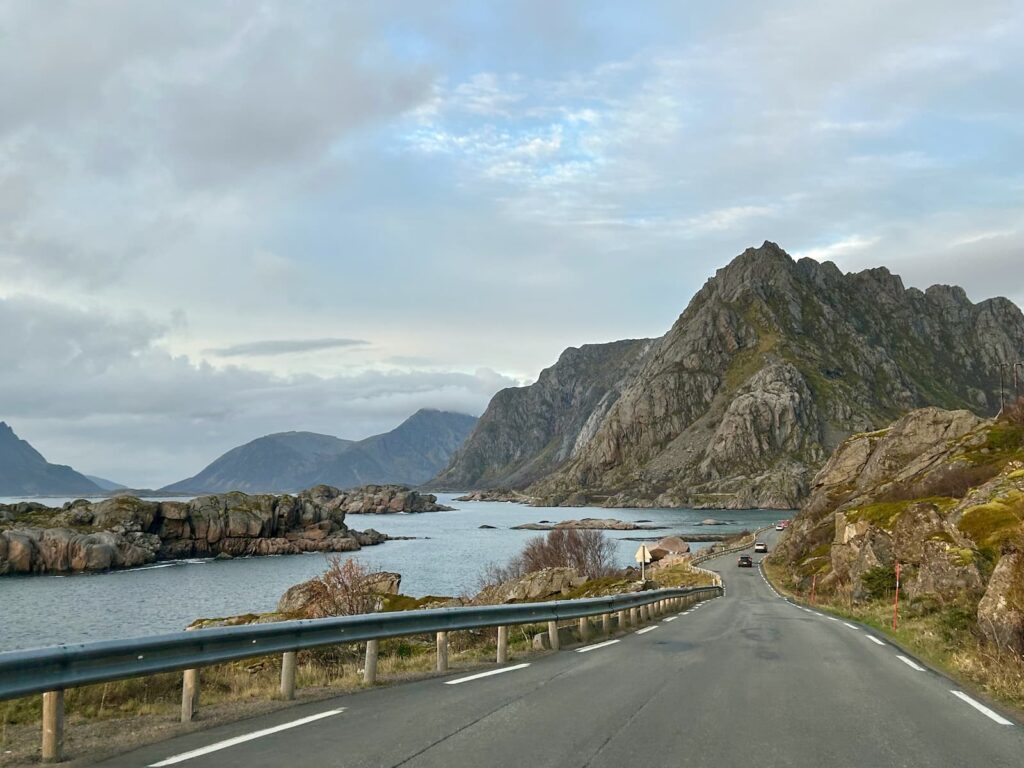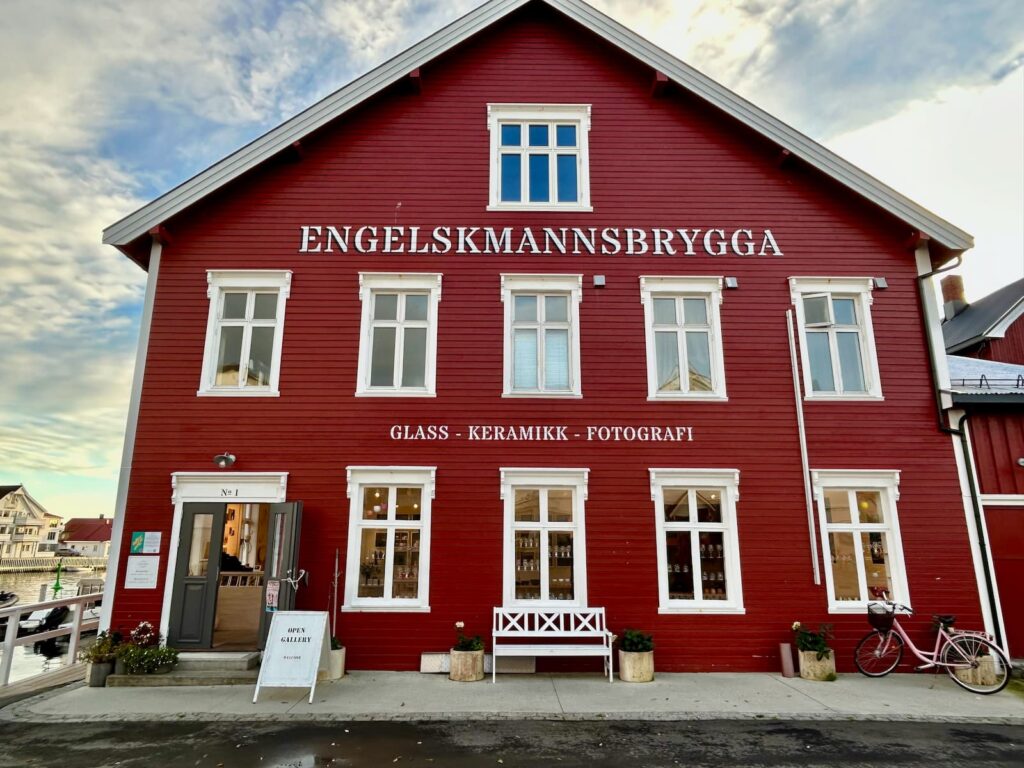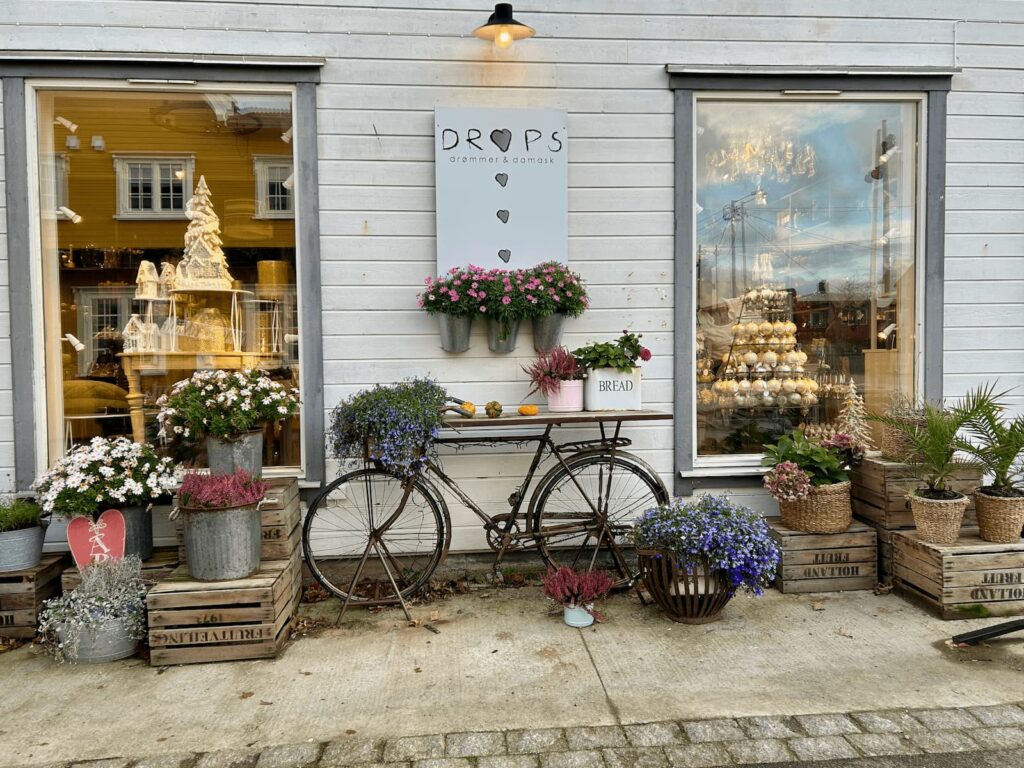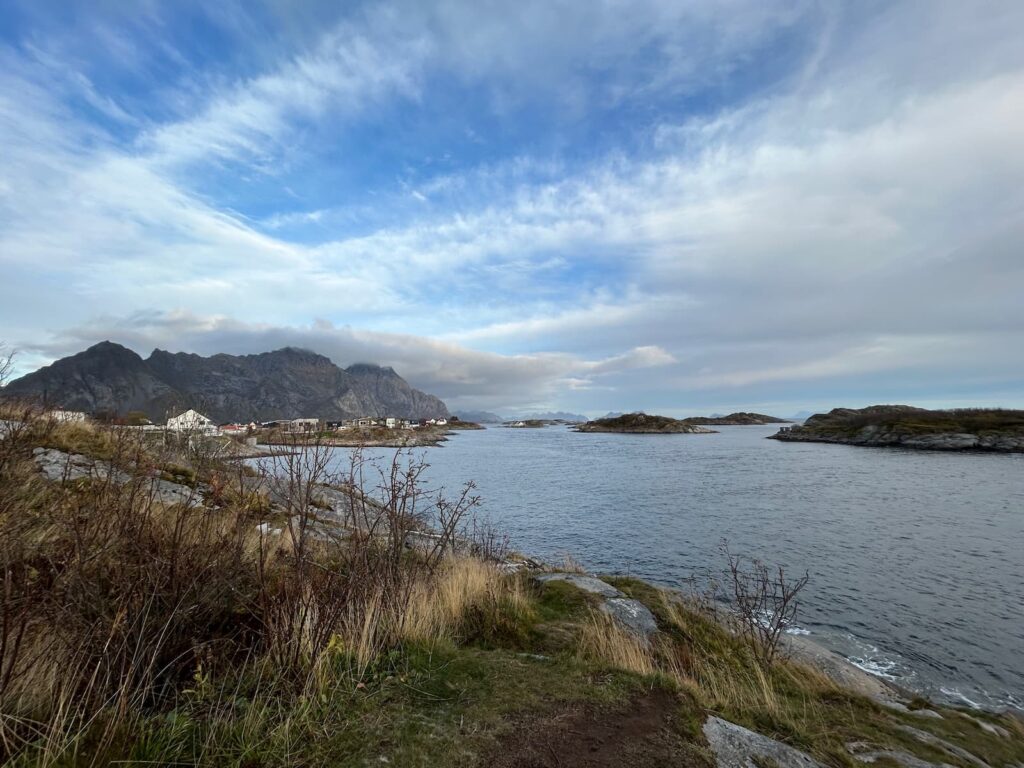In October 2022 we did a wonderful 19-day, self-drive trip in Norway.
Take a look at our slideshow on Norway.
We split the trip into two parts:
- Western Norway: Bergen – Sogndal – Geiranger – Kristiansund – Alesund – Loen – Balestrand – Bergen
- Lofoten Islands: Flew Bergen to Bodo, hired car and drove to Lofoten Islands, drove back to Bodo, flew to Oslo.
This is a trip with magnificent scenery of mountains, fjords and charming villages. At this time of the year we also experienced autumn colours. The only downside with travelling in October was that some of the scenic mountain roads were closed due to snow.
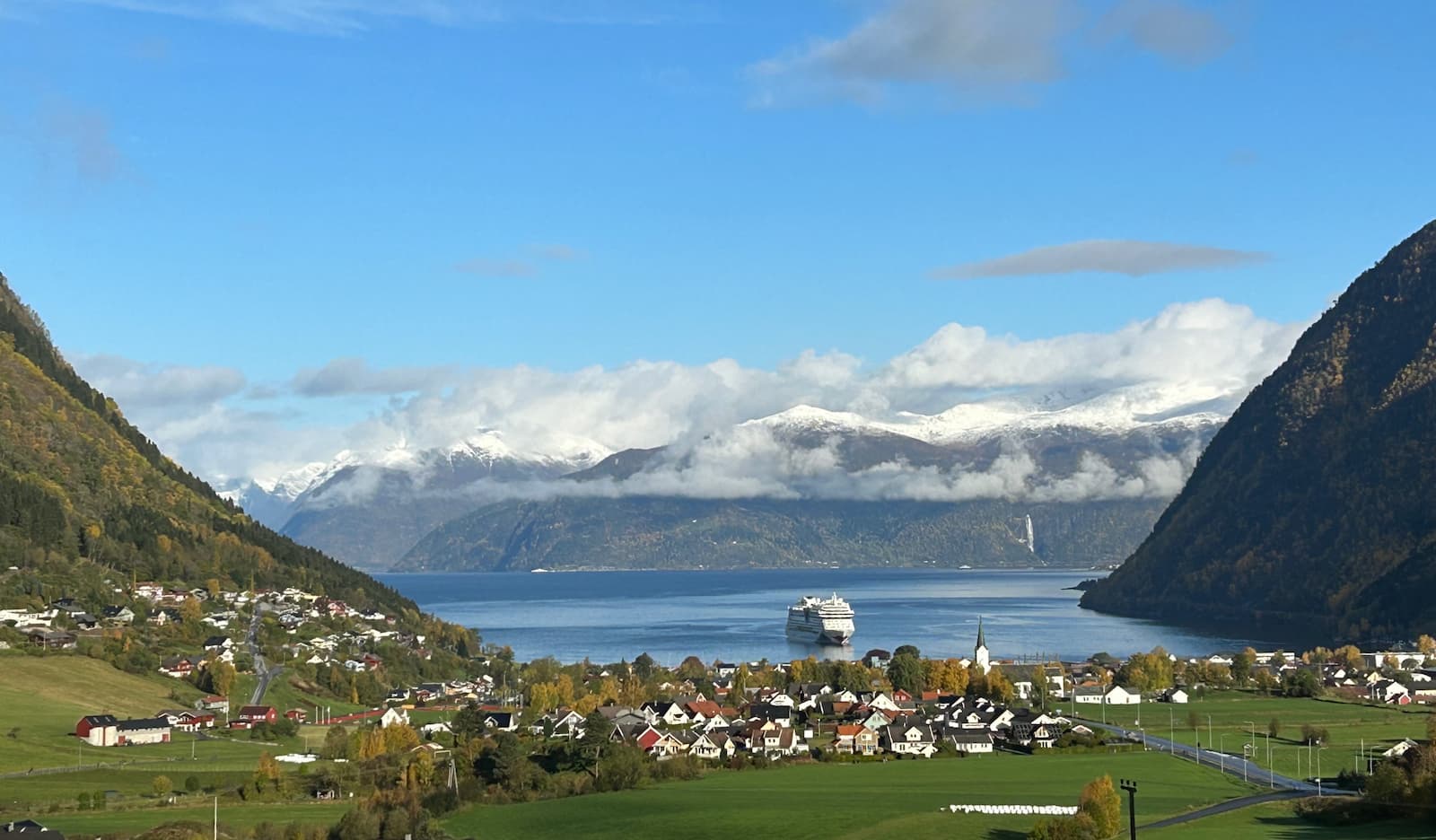
Vikoyri on Sognefjord
Norway 19-Day Itinerary
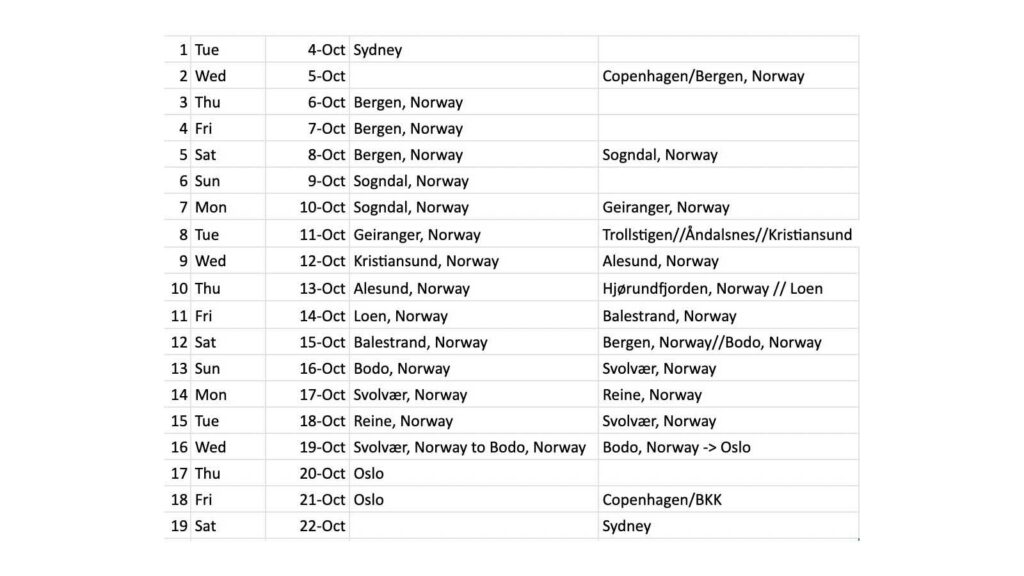
We flew with Thai Airways from Sydney to Copenhagen (Denmark) via Bangkok. With a layover of several hours in Bangkok we organised a hotel room through Miracle Lounge at the airport.
Arriving in Copenhagen at 7am in the morning we had a day of sightseeing before continuing on to Bergen.
We stored our luggage in a locker at Copenhagen airport and took a taxi into the city where we joined a 2-hour Copenhagen Free Walking Tour at 10.30am – highly recommended.
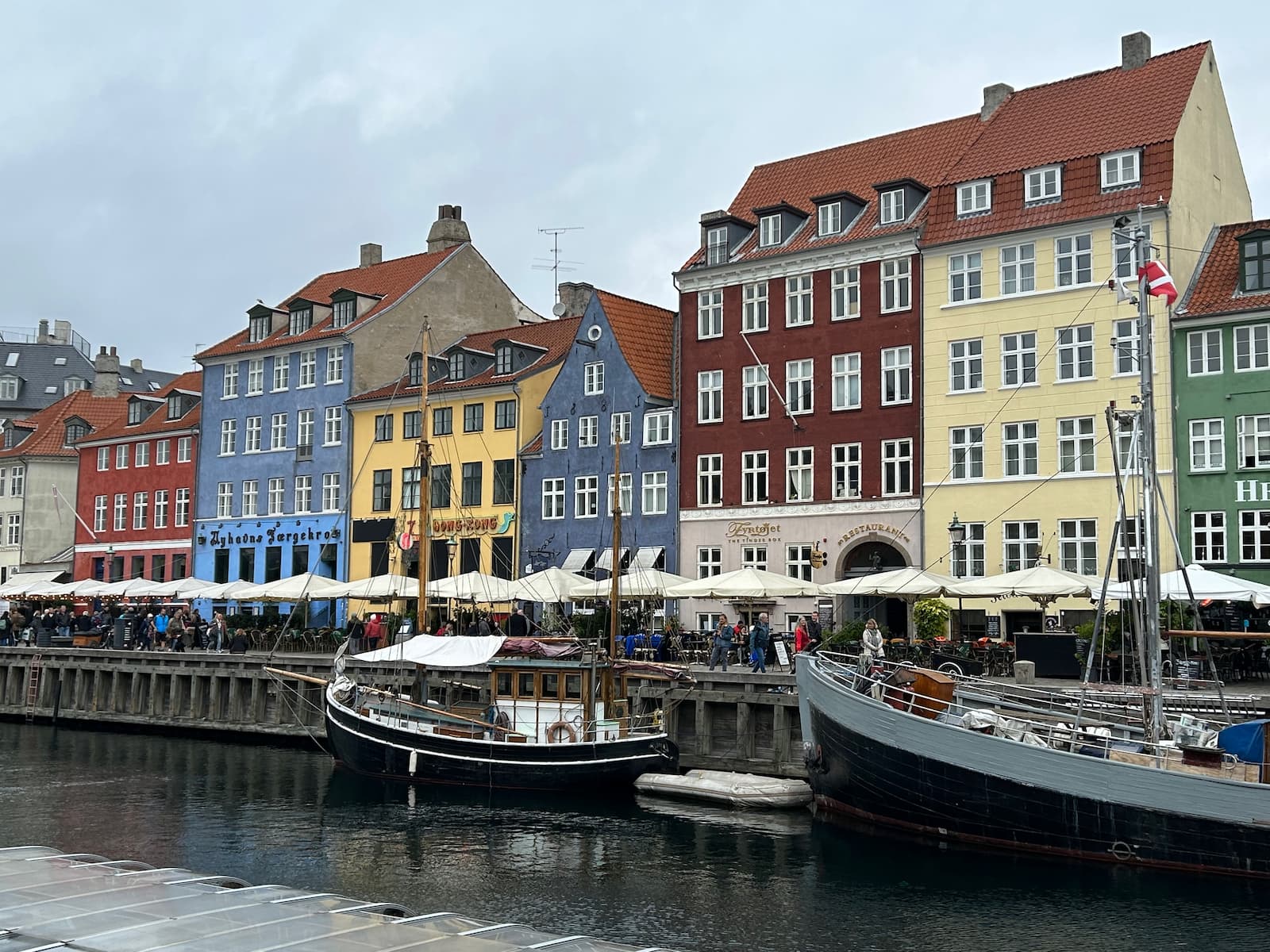
Nyhavn Canal, Copenhagen
Highlights of Copenhagen Free Walking Tour:
- City Hall – did a tour of the beautiful interiors of city hall building.
-
Christiansborg Palace – the Danish Parliament, the Prime Minister’s office and the Supreme Court.
- Magasin du Nord – flagship store of Denmark’s oldest department store.
- Royal Danish Theatre (Old Stage) on Kongens Nytorv Square – Copenhagen’s oldest theatre (1748).
- Nyhavn canal – lined with colourful 17th and 18th century buildings.
-
Amalienborg Palace – winter residence of the Danish royal family where we saw the changing of the guard ceremony, Marble Church.
We had a very short time in Copenhagen but there is much more to see including Tivoli, Rosenborg Castle, Stroget (Copenhagen’s main shopping street), and Christiania (alternative area).
After the walking tour we had delicious pastries and coffee at Hart Bakery then wandered through the city taking photos before catching a taxi at 2pm back to the airport for our 5pm flight to Bergen on Norwegian Airlines. We arrived about 6pm in Bergen to begin the first part of our Norwegian trip.
WESTERN NORWAY

Western Norway Itinerary Map
There are so many highlights in this part of Norway. Our favourites:
- Bergen – pretty town, the gateway to many of Norways famous fjords.
- Hardangerfjorden – second longest fjord in Norway.
- Flam Railway – popular tourist train ride with stunning views of mountains, waterfalls and fjords.
- Sogndal and Solvorn – charming towns on Sogndalfjord – the longest, deepest fjord in Norway.
- Geirangerfjord – UNESCO World Heritage listed – amazing, beautiful scenery.
- Trollstigen – a steep and dramatic ‘troll road’.
- Alesund – charming town on the west coast known for colourful Art Nouveau architecture.
- Stryn, Olden and the Briksdal Glacier – an area of beautiful scenery.
Bergen: 6 October
At Bergen Airport we collected a Sixt hire car and drove to our accommodation – Fosswinckel Apartments. We loved our cosy, 3-bedroom apartment in the university district. It was a pleasant seven minute walk to the city centre. We can highly recommend Fosswinckel Apartments.
The next day we walked to the music gazebo in the city centre to join an 11:00 am Bergen Free Walking Tour by TwentyTour. Highlights included:
- Musikkpaviljongen (Music Pavilion)
- City Park
- Bergen Fish Market
- St Mary’s Church
- Bergenhus Fortress and the Rosenkrantz Tower
- Bryggen – colourful UNESCO-listed heritage Hanseatic merchant buildings facing the Bergen harbour
- Hanseatic Museum and Schøtstuene
After this excellent tour we wandered the colourful Bryggen area before taking the Fløibanen – a funicular railway to the top of Floyen for wonderful views over Bergen.
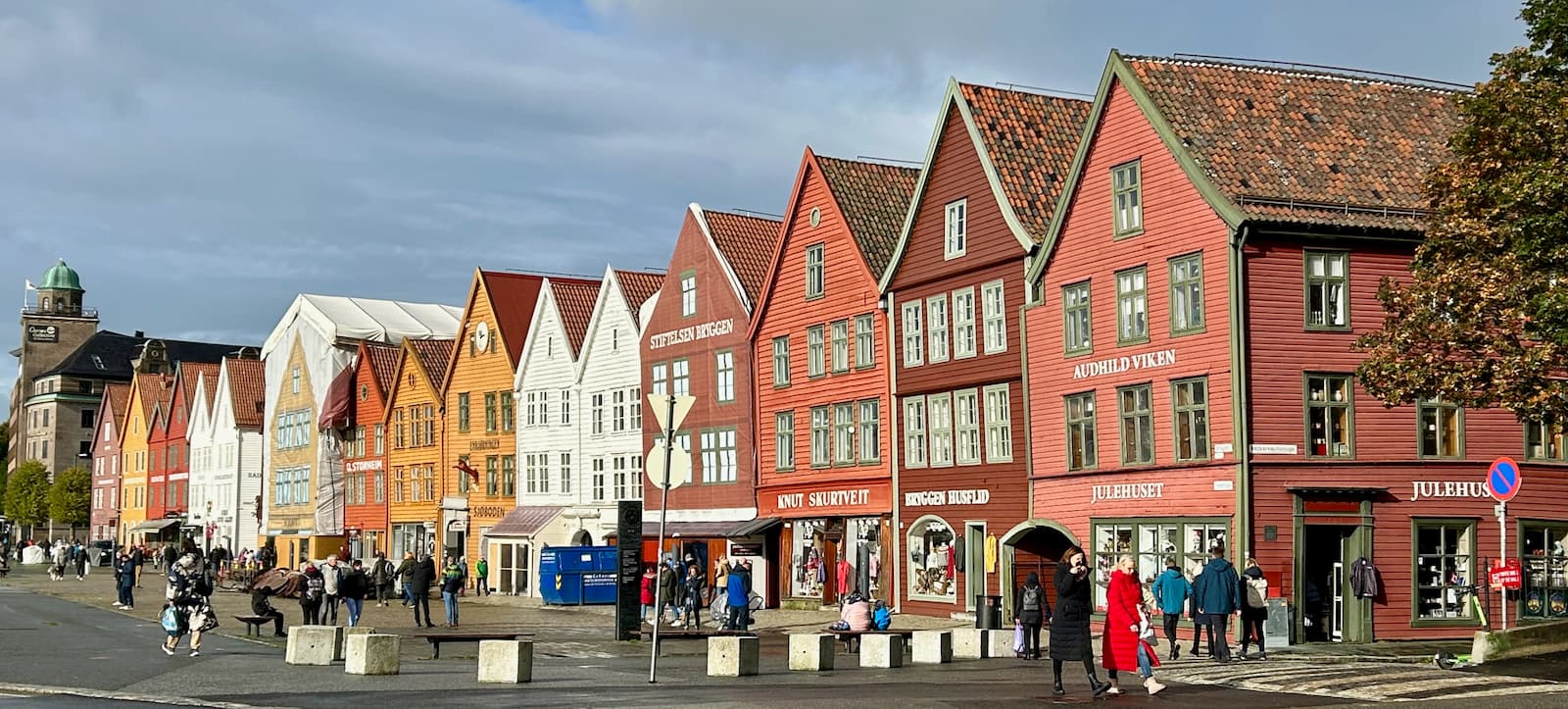
Bryggen, Bergen
Day Trip from Bergen to Hardangerfjorden: 7 October
From Bergen we did a self-drive day trip to the beautiful Hardangerfjorden – one of the longest fjords in the world. Our drive was a variation of the Scenic Route Hardinger (one of Norways Norwegian Scenic Routes).
We firstly drove from Bergen to Norheimsund, where we stopped at Steinsdalsfossen – a pretty waterfall that has a walking track leading up to the waterfall – you can actually walk behind the falls.
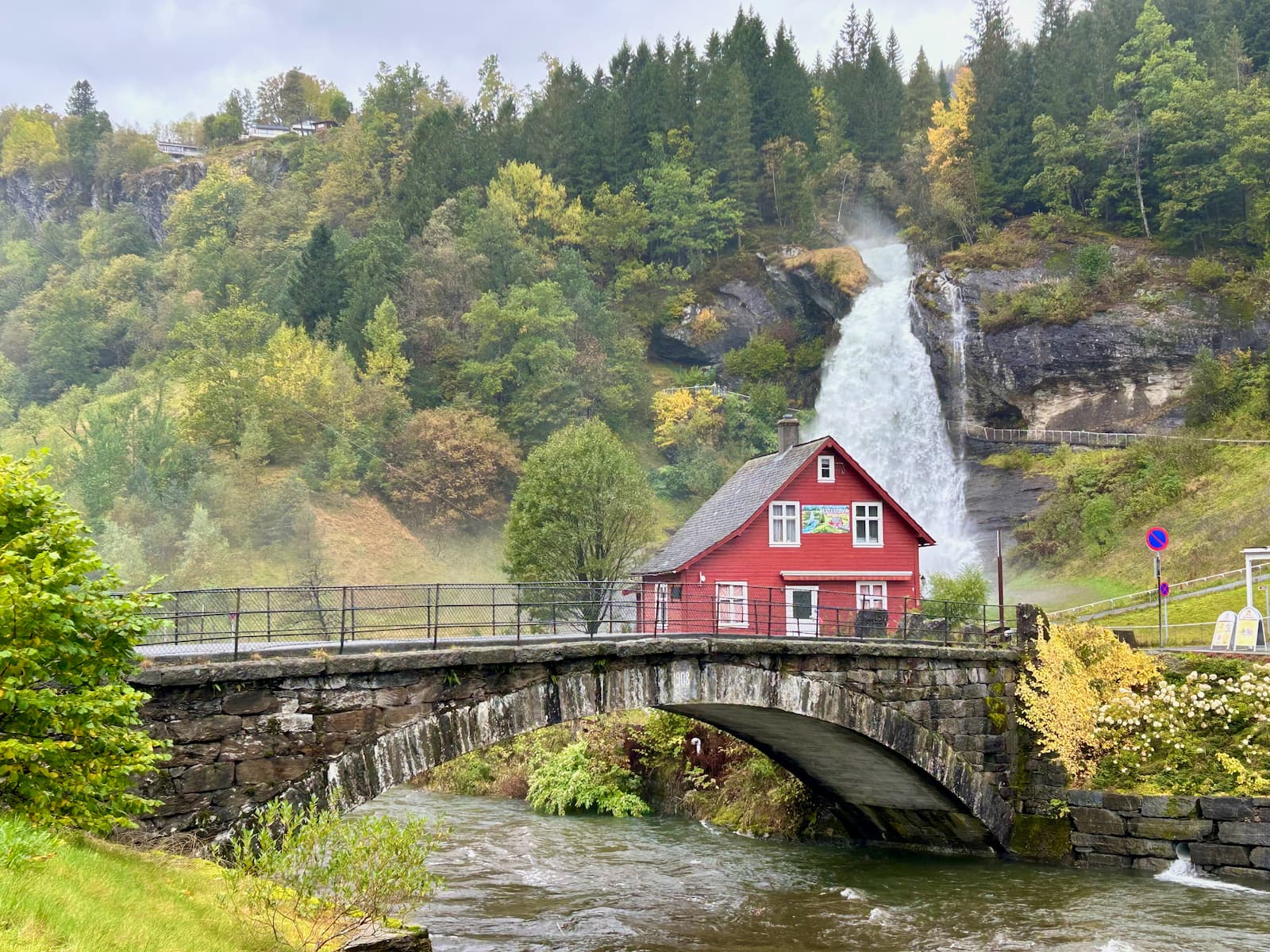
Steinsdalsfossen – waterfall near Norheimsund
In Norheimsund we had a delicious lunch at Kaffimat Café overlooking the fjord, before continuing on Route 79 – a beautiful drive alongside Hardangerfjorden.
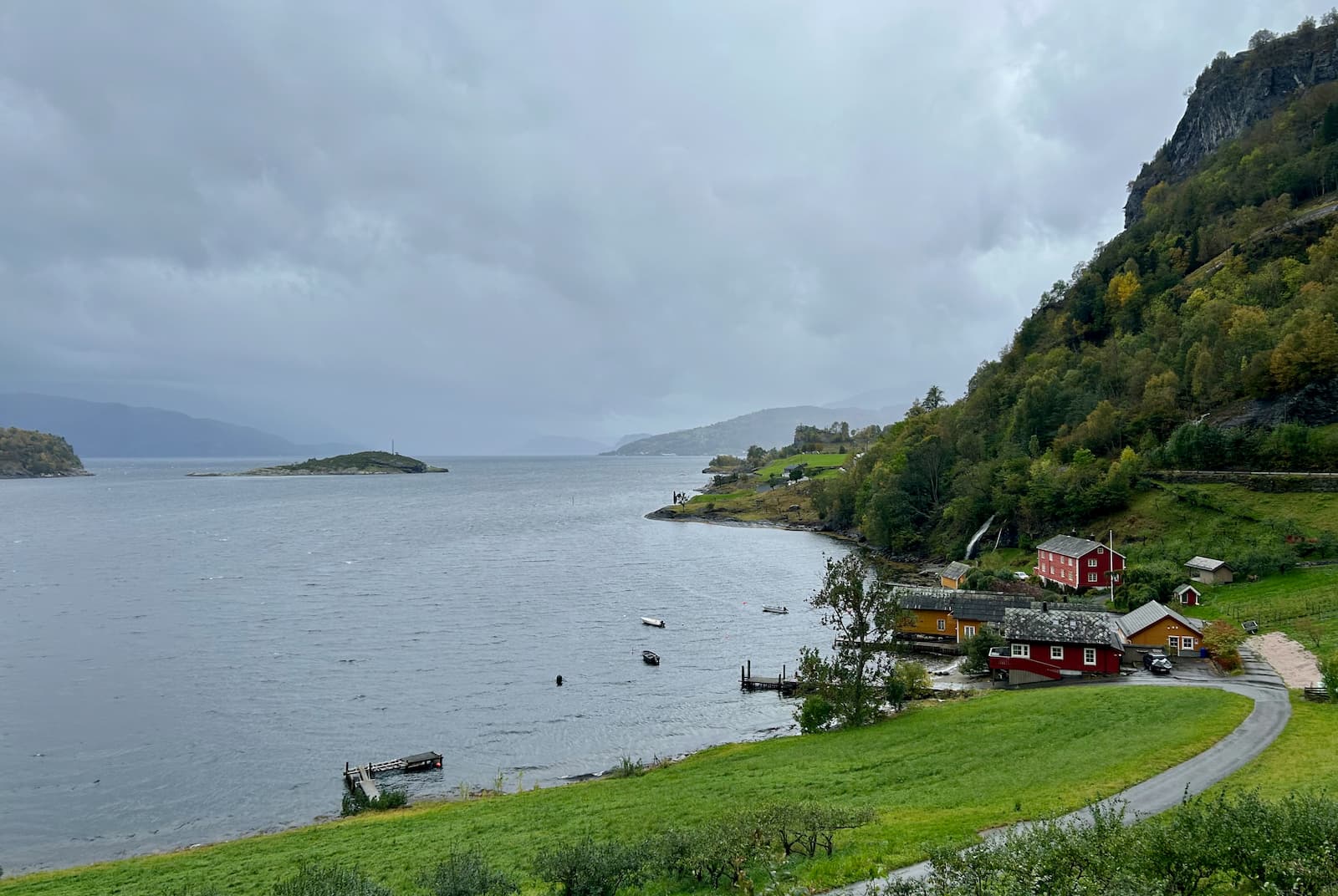
Route 79 alongside Hardangerfjorden
We could have taken the car ferry from Kvanndal to Utne but just missed it! (Skyss operate ferry services in Vestland county.)
Instead we drove around the fjord to Kinsarvik (via the Hardanger Bridge) and took the car ferry (it is free) from Kinsarvik to Utne – a 28 minute crossing.
We drove from Utne to Jondal on Rte 550 (52 minutes) – along the edge of the fjord through pretty orchards and small communities – with views of the fjord all the way – one of our favourite parts of the drive.
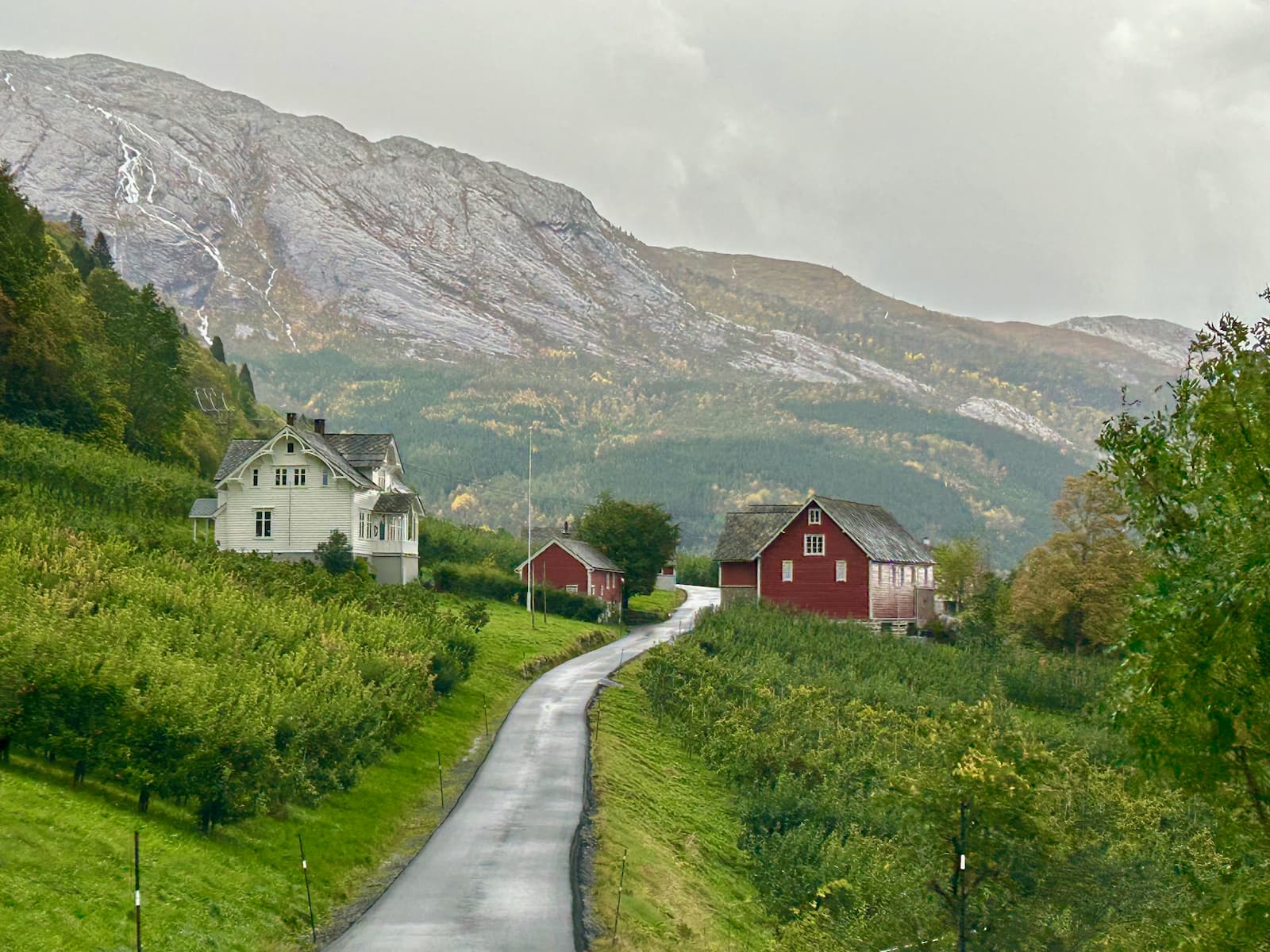
Rte 550 alongside Hardangerjforden – through orchards between Utne and Jondal
At Jondal we took a ferry to Torvikbygd (19 minute crossing).
We then drove from Torvikbygd back to Bergen (1.5 hours).
It was a long day trip but we loved it – beautiful scenery – highly recommended.
For more information on visiting the Hardanger area – take a look at the Travel Guide for Hardanger website.
Bergen to Sogndal & the Flam Railway: 8 October
Leaving Bergen we drove the E16 to Voss where we had lunch at the Vargen Café in Voss.
We then continued on to Flom where we took the Flam Railway – a round trip to Myrdal (departing 2.10pm returning at 4.30pm). This train trip is an hour each way and offers stunning scenery. The train stops at the Kjosfossen waterfall for a short time where we were able to take photos. Once in Myrdal we had just 20 minutes to hop off and take photos before taking the train back to Flom. It is possible to stay in Myrdal if you choose. Flom is a very pleasant place and the station has good gift shops and a great bakery.
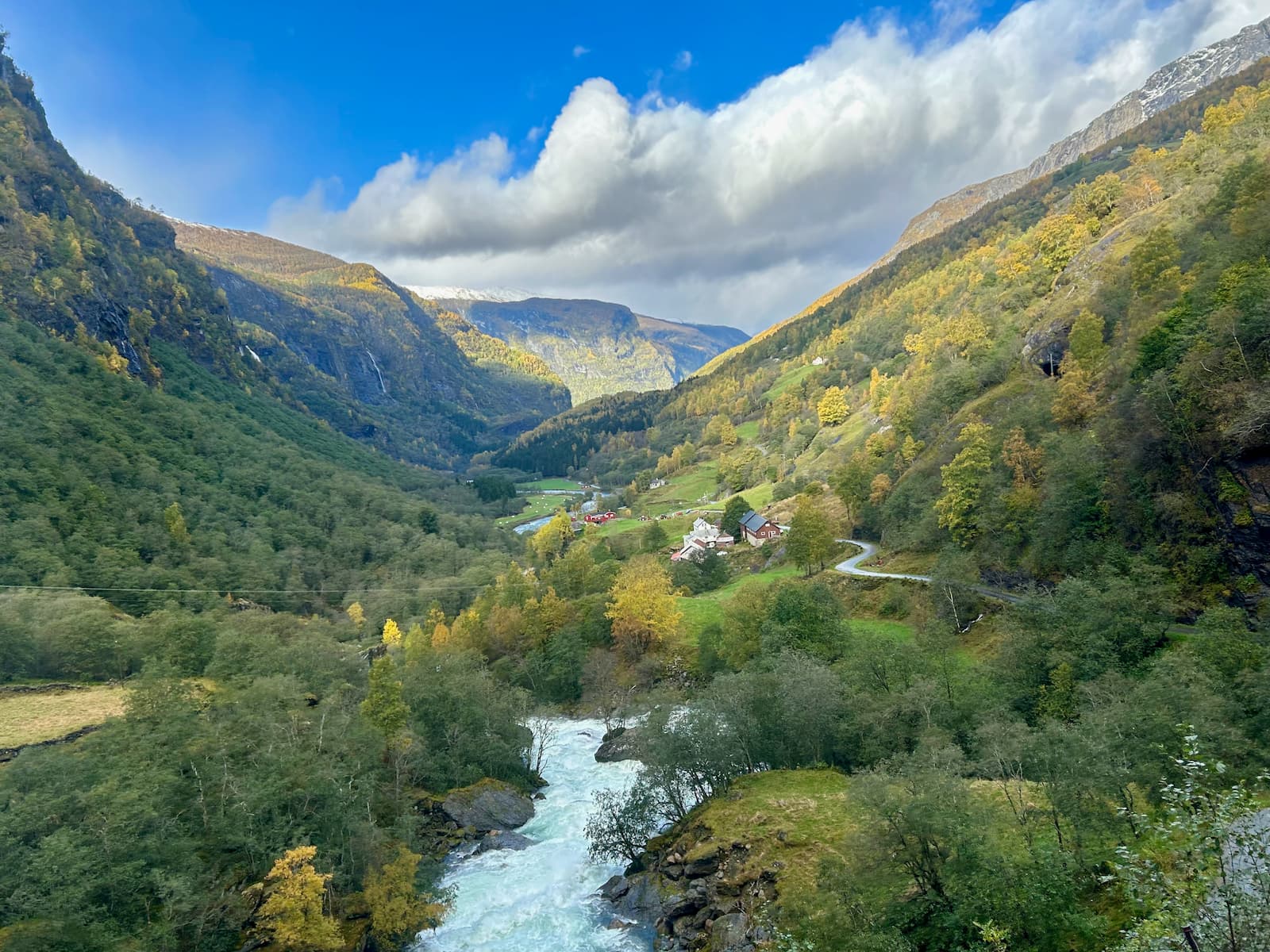
Views from the Flam Railway
We had intended to drive from Flom over the mountain to Sogndal on National Tourist Route Aurlandsfjellet (including a stop at the amazing Stegastein viewpoint platform). Unfortunately during our visit the Aurlandsfjellet road was closed due to snow and ice.
So instead, after taking the Flam Railway, we continued from Flom to Sogndal via the Laerdal Tunnel (Laerdalstunnelen) – the world’s longest road tunnel – 24.5 kilometers (15.2 miles) long.
In Sogndal we stayed at Hodlekve Panorama 5. This was an amazing 3 bedroom apartment about a 15 minute drive from Sogndal in an area known as Sogdnal Ski Center Hodlekve. The apartment was brand new, spotlessly clean and had fabulous views. Highly recommended.
Sogndal: 9 October
There are a couple of pretty spots to visit from Sogndal.
Firstly we drove to Laerdalsoyri, a pretty village, visited the Lutheran Church and the fabulous bakery.
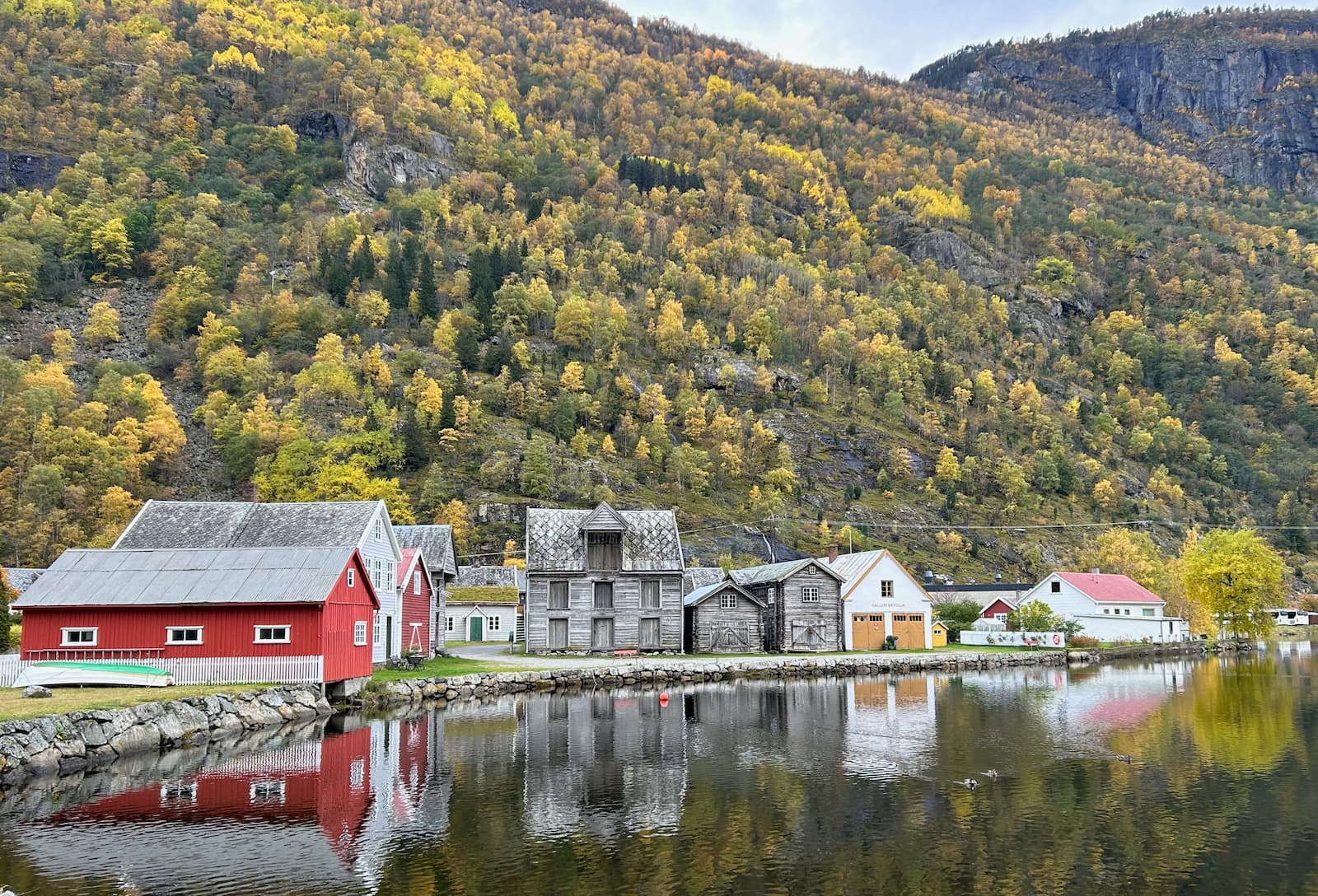
Pretty village of Laerdalsoyri
We then drove to Solvorn – a very beautiful village on the Lusterfjord (a branch of Sognefjord). We had hoped to visit the small village of Ornes by ferry to see the UNESCO World Heritage listed Urnes Stave Church but the ferry was only running at 6.30pm that day – too late for us.
We spent time walking photogenic Solvorn:
- Gorgeous reflections of buildings and mountains in the fjord.
- Charming Walaker Hotel
- Many beautiful walks from Solvorn – we did a section of the walk along the fjord.
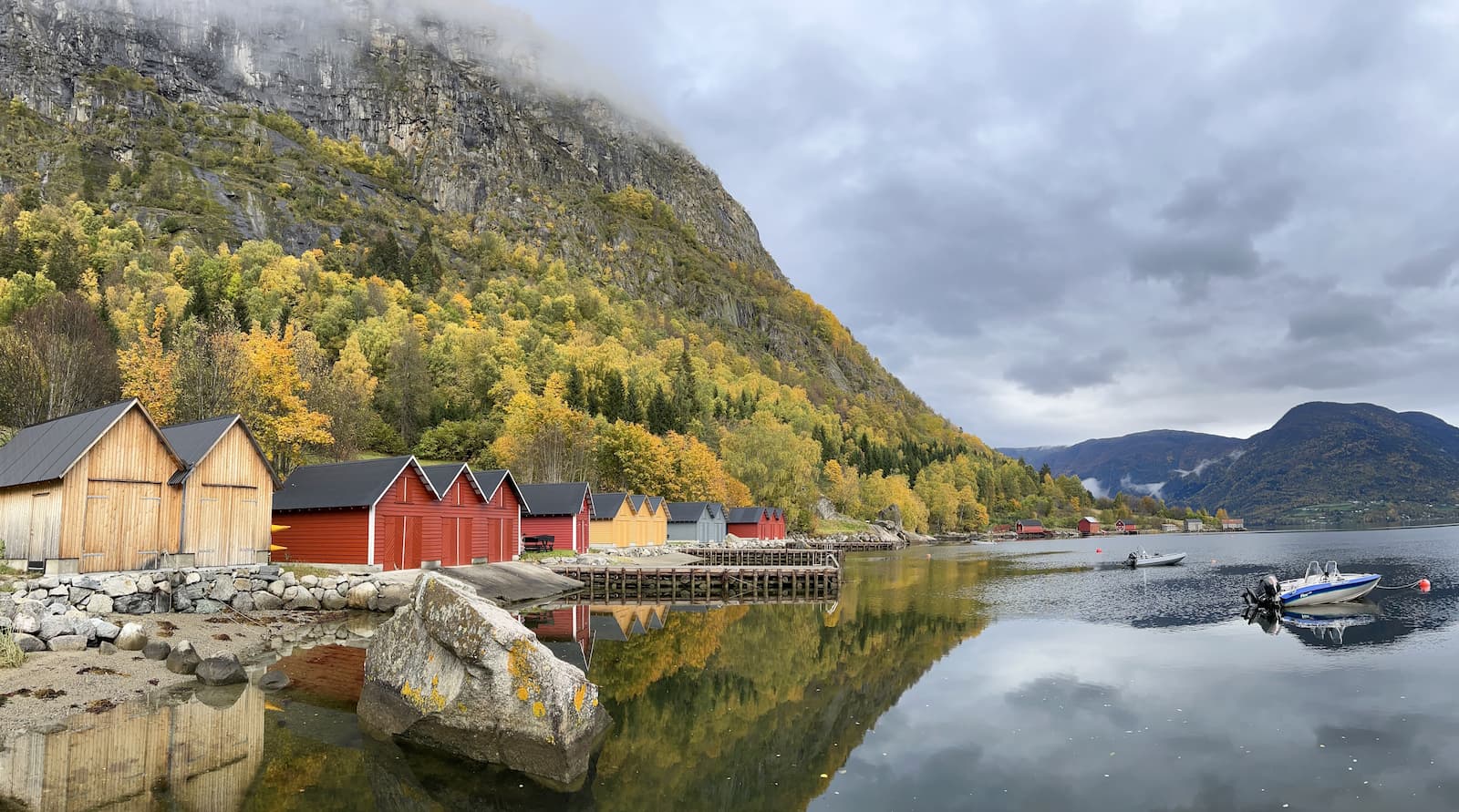
Solvorn
We then drove back towards Sogndal and took the beautiful drive along the Sognefjorden to Hella. Running out of daylight we turned around at Hella and drove back to Sognal where we stayed a second night.
Sogndal to Geiranger: 10 October
We left Sogndal intending to drive part of the National Tourist Route Sognefjellet (Rte 55 to Lom (Fossbergom) then Rte 15-Rte 63 to Geiranger). This route is the highest mountain pass in northern Europe.
We drove from Sogndal around the fjord to Skjolden (Rte 55) – about one hour. Just beyond Skjolden is a little village called Fortun – we asked a fellow at the local garage if there was snow on the mountain road (Routes 55/15/63) and he said yes there was. We would have been okay to drive it however he said we had summer tyres on our rental car and they were not suitable for that road. He had already rescued five cars the previous day as they did not have suitable tyres! So we took his advice and missed driving the mountain road – very disappointing – another mountain road that was inaccessible to us!
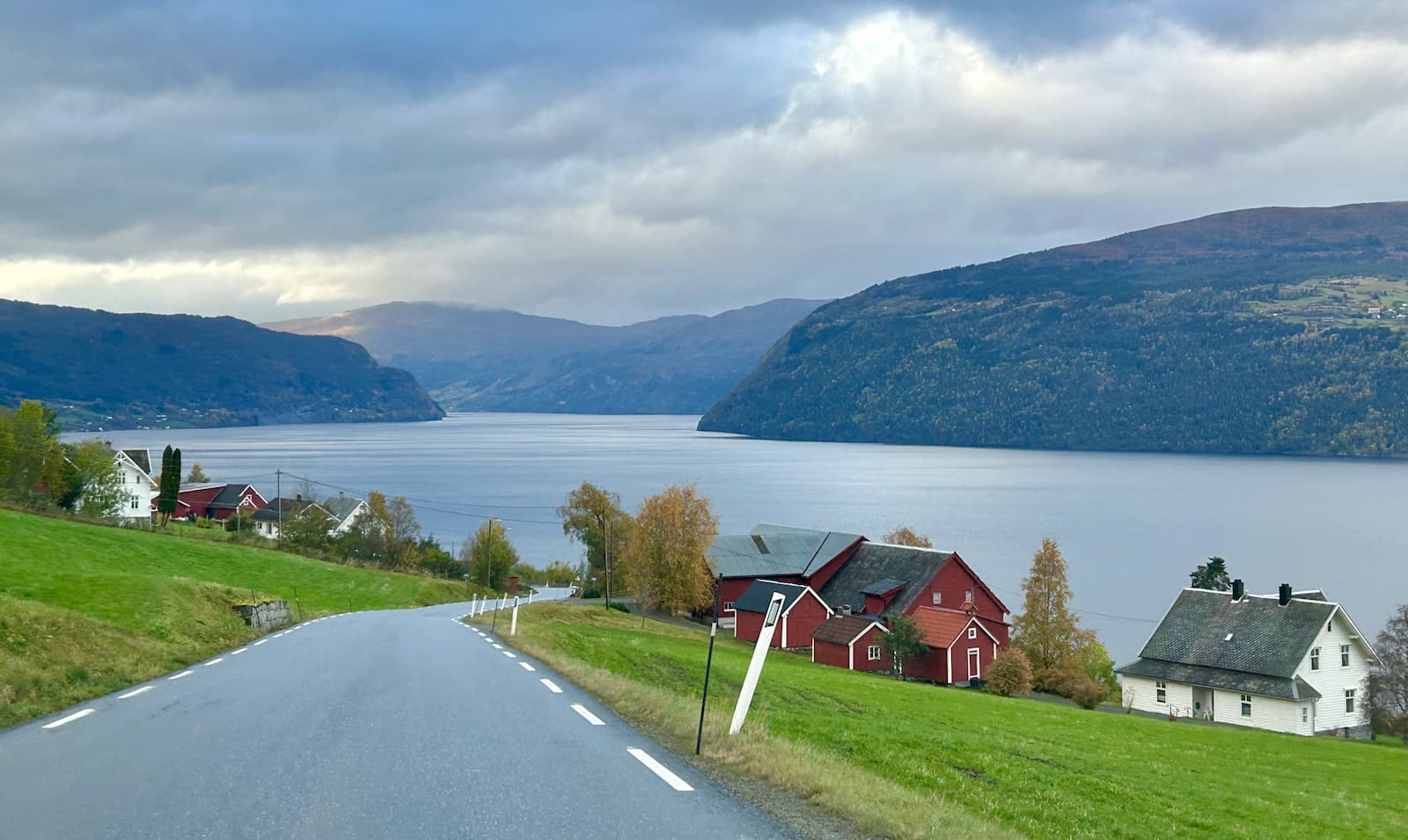
Views at Utvik on the way to Hellesylt and the Geiranger Fjord
So we headed back to Sogndal and taking the ‘low’ roads, we drove all the way to Hellesylt (about a 3 hour drive) via Utvik, Olden, Leon and Stryn – a beautiful drive. At Hellesylt we took the car ferry to Geiranger for the 55 minute ferry trip on the magnificent Geiranger fjord. This was an amazing way to see the stunning Geiranger Fjord and a great way to arrive in the small town of Geiranger.
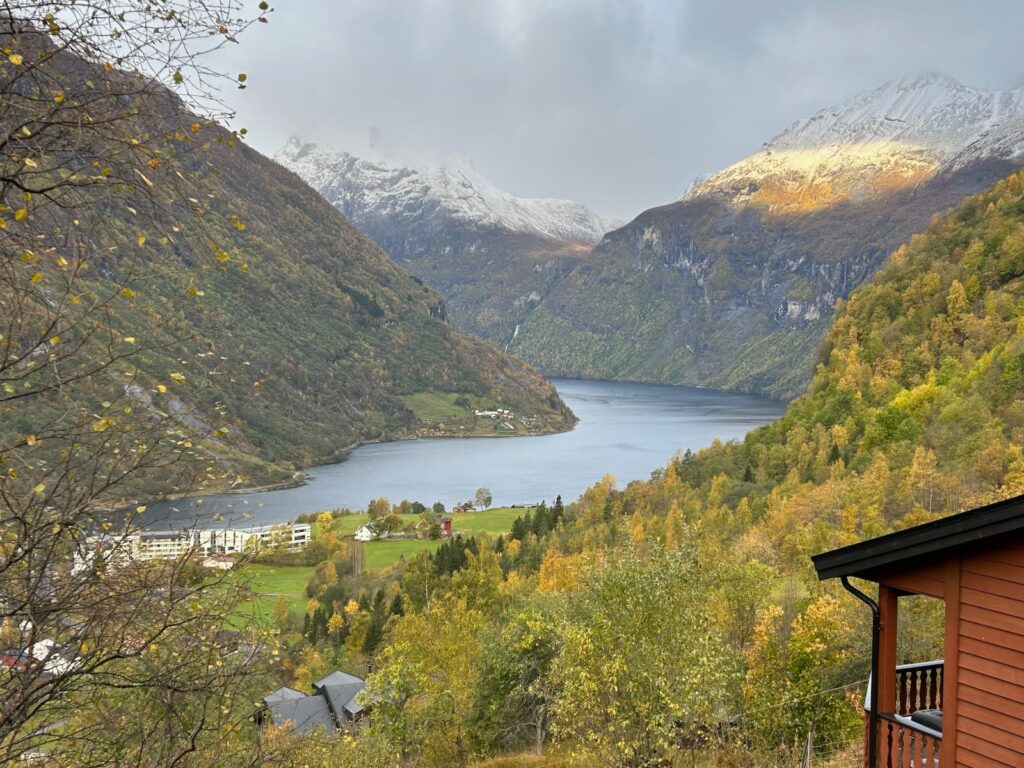
Views of Geiranger Fjord from our Geiranger accommodation
At Geiranger we visited the grocery shop to buy supplies for dinner and checked into Fossen Accommodation – a cosy two-bedroom, one bathroom self-contained cabin up the mountain from Geiranger – incredible views of Geiranger Fjord (Geirangerfjorden)! Facilities included kitchen, two bedrooms (one with bunk beds) and small balcony. Highly recommended.
Geiranger – Trollstigen – Andalsnes & the Atlantic Road: 11 October
This was another amazing drive with spectacular scenery firstly along the Golden Route (Hwy 63) one of Norway’s 18 Scenic Routes, linking Geiranger and Andalsnes, and then along the Atlantic Road (Atlanterhavsvegen) overnighting in Kristiansund. We had a rainy day which wasn’t ideal to take in the views along the way.
Leaving Geiranger we drove up out of the town on the amazing Ornesvingen ‘Eagle Road’, a zig-zag road up the steep side of the Geiranger Fjord, stopping at the Ornesvingen look-out point on the way up. Fabulous views.
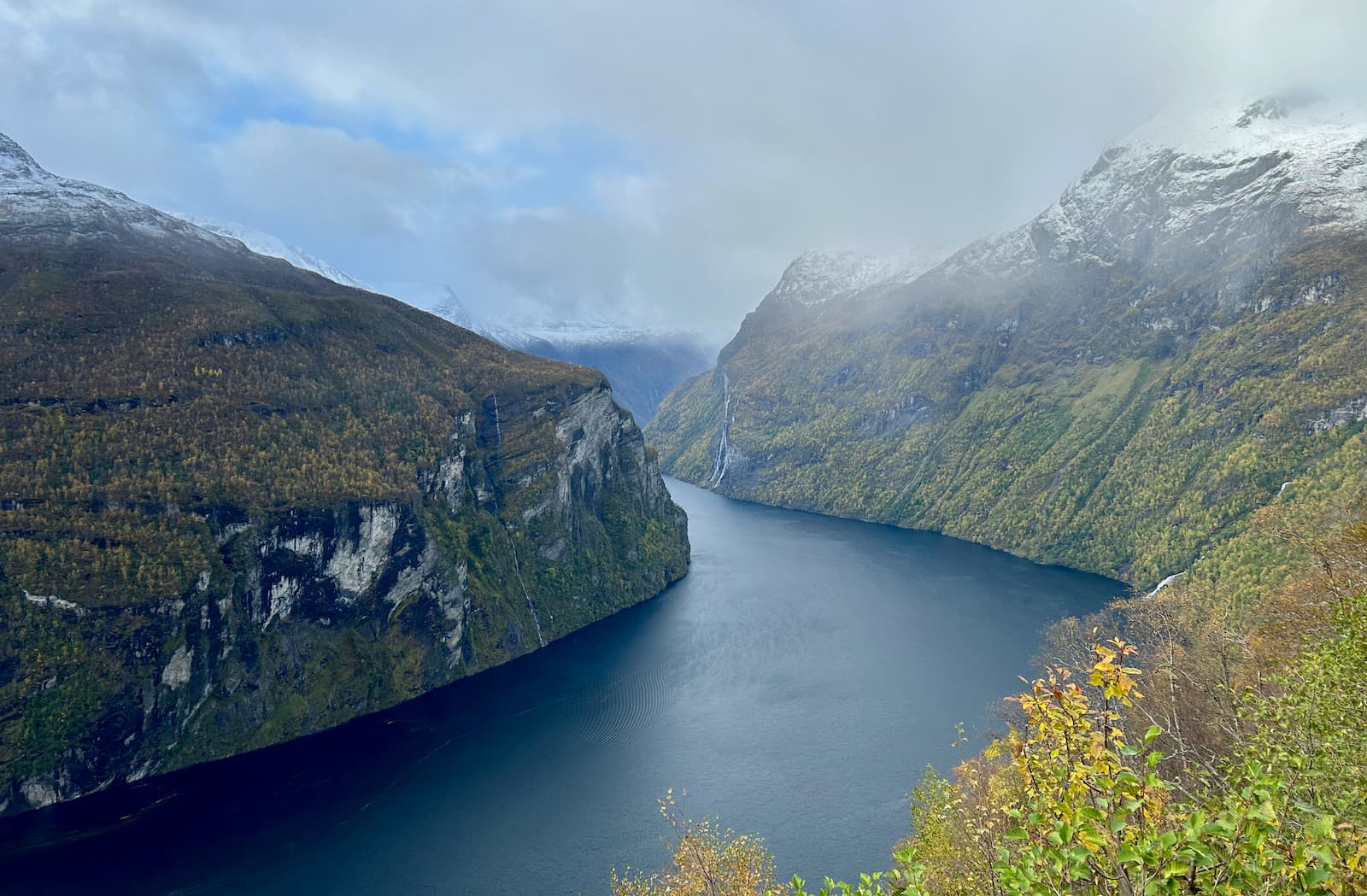
Part of the view from Ornesvingen lookout
From there it was more beautiful mountain and farmland scenery to the agricultural village of Eidsal. At Eidsal we took a car ferry across Norddalsfjorden to Linge. Still on Hwy 63 we passed through Valldal and the viewing point at Gudbrandsjuvet gorge.
From Valldal the road climbed and it snowed! Just before the steep and famous part of the road – with 11 hairpen bends down to the Romsdalen valley, there are viewpoints, walkways and a cafe with wonderful views of the Trollstigen (troll road) and valley below.

A section of the steep hairpin bends of the Trollstigen road
At Andalsnes we stopped for a delicious lunch at the charming Sodahlhuset Cafe.
From Andalsnes we took Hwy 64 toward Kristiansund and the Atlantic scenic road (Atlanterhavsvegen).
Atlantic Road
The Atlantic Road is 36kms long between Bud and Karvac. There are seven bridges connecting the islands and islets along this route – they are a spectacular feat of engineering. Most people find the most dramatic section of the road is between Vevang and Karvag.
Between Bud and Karvag there are many rest areas and viewpoints.
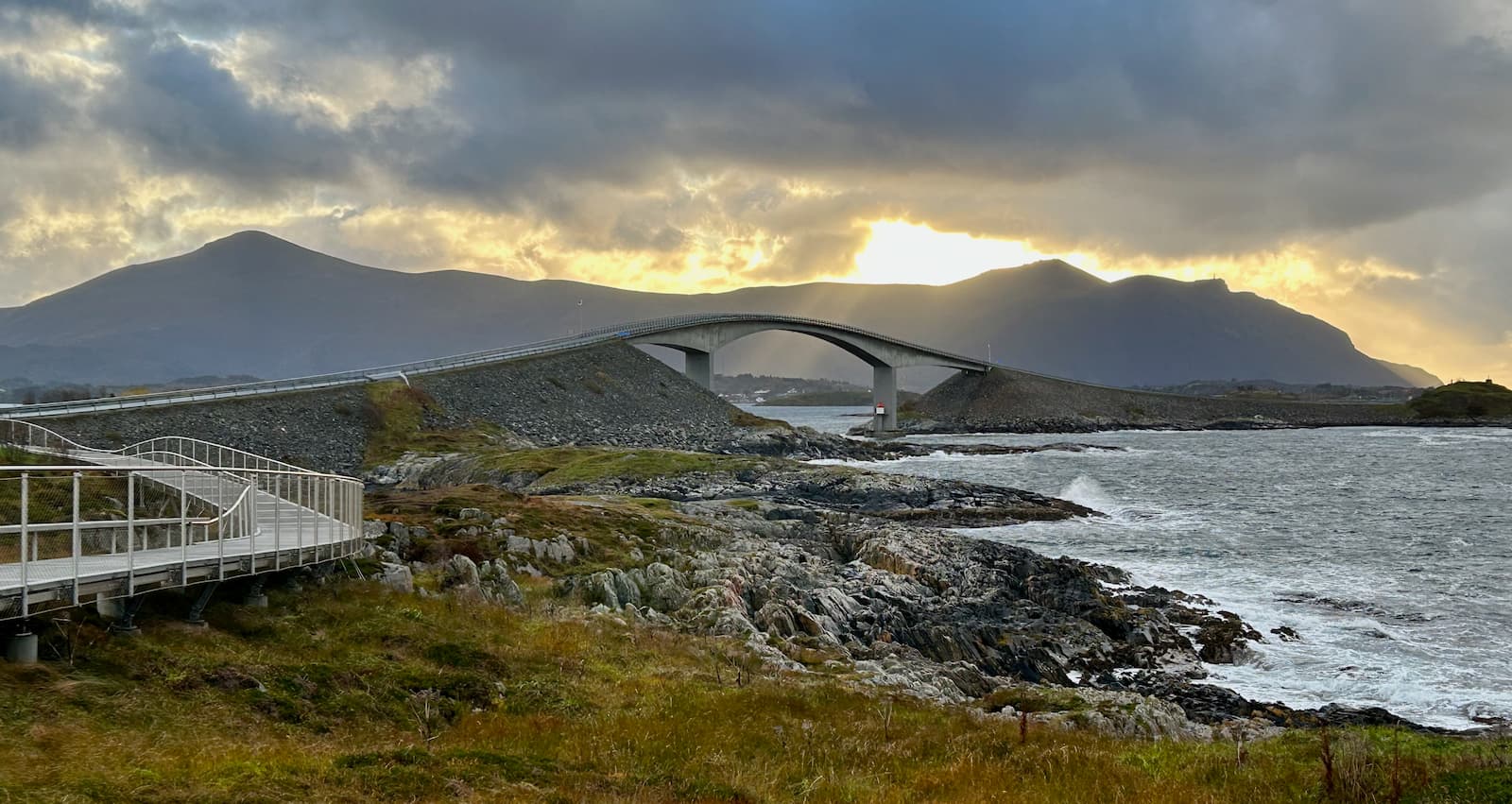
Storseisundet Bridge on the Atlantic Road viewed from the boardwalk at Eldhusoya
We particularly liked:
- Kjeksa – take the concrete path through heathlands down to the shore, views of the open sea and Hustadvika – a notorious stretch of sea where many ships have been wrecked.
- Askevagen viewpoint – sitting just above the ocean, this little platform with glass sides is located at the end of the breakwater – enjoy 360 degree views.
- The Storseisundet Bridge (Storseisundbrua) – the most iconic and amazing bridge on the route.
- The Myrbaerholmen bridge – with metal walkways either side for fishing.
- Eldhusoya – an elevated metal hiking path – takes you on a circular route close to the ocean and vegetation. Lovely views of the ocean and of the Storseisundet Bridge.
- Geitoya Haholmen viewpoint.
- Haholmen – an old fishing village that has been transformed into a modern hotel and restaurant company – Haholmen Havstuer – only accessible by boat.
We stayed the night near Kristiansund in beautiful accommodation – Vikaneset Havhotell (Viking Harbour Hotel) – a collection of Norwegian-style cabins and old buildings converted into apartments. The cabins are located right on the sea and have amazing views. We had a beautiful cosy cabin. Highly recommended.
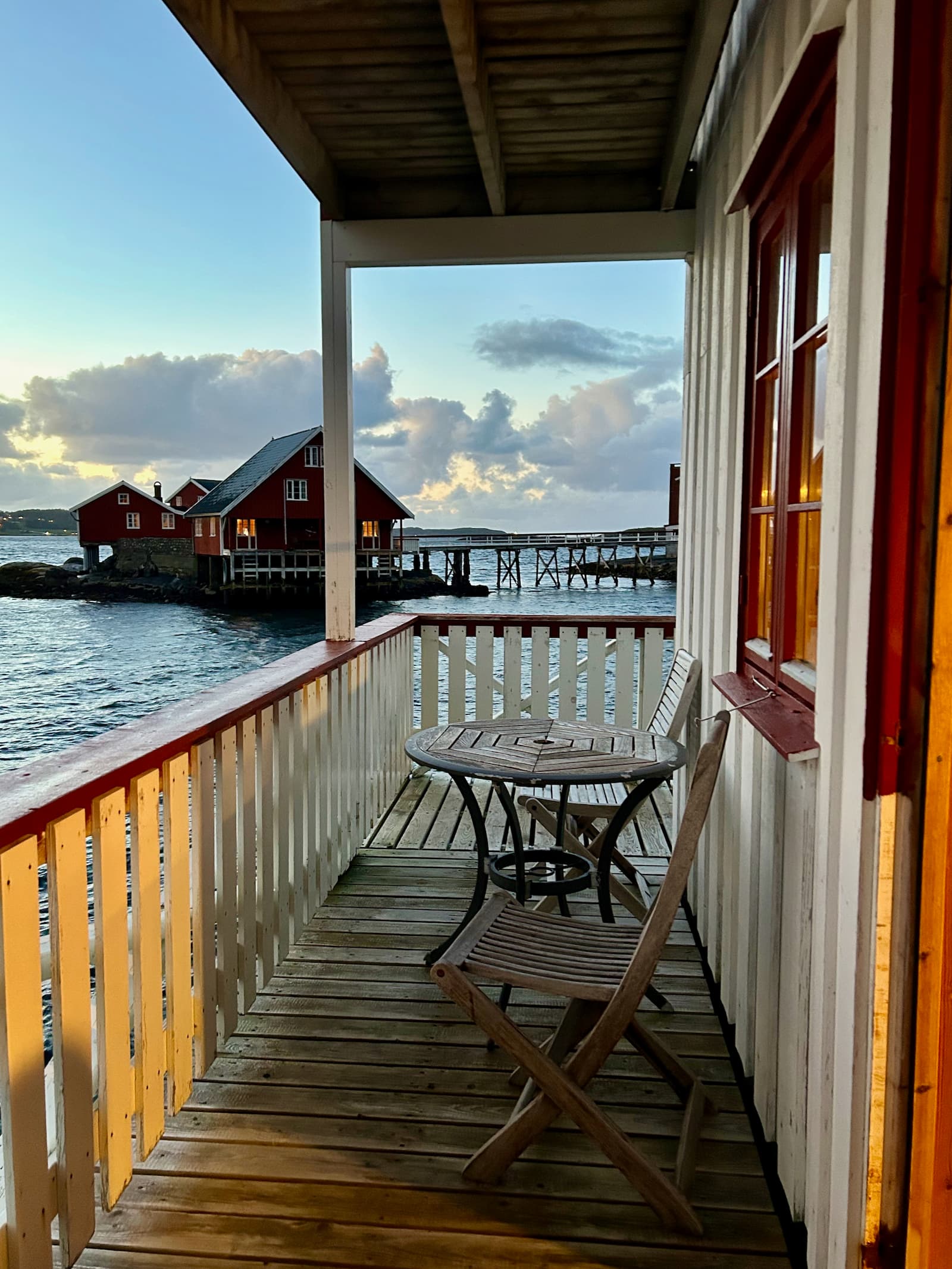
Our cabin at Vikaneset Havhotell (Viking Harbour Hotel), Kristiansund
(In hindsight, if short on time, our advice would be to skip the Atlantic Road and concentrate on the stops along the Golden Route between Geiranger and Andalsnes. It was a long drive to see the 8.3km highlights on the Atlantic Road.)
Kristiansund to Alesund: 12 October
Kristiansund was as far north as we drove on this trip. It was time to head south again, taking the inland route – E39 via Molde to Alesund – about a 3 hour drive. Beautiful scenery along the way – lush farmlands, mountains and fjords.
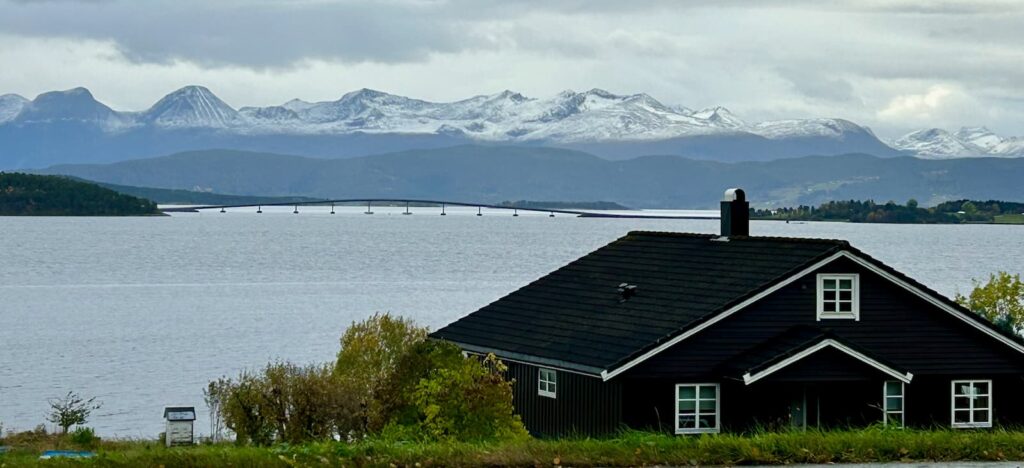
Views of Fannefjord, Molde
Alesund is a very attractive town. Don’t miss the Aksla Viewpoint (Akslatrappa) for beautiful views of Alesund and surrounds. You can walk up the 418 steps from the City Park, or drive up to the viewpoint.
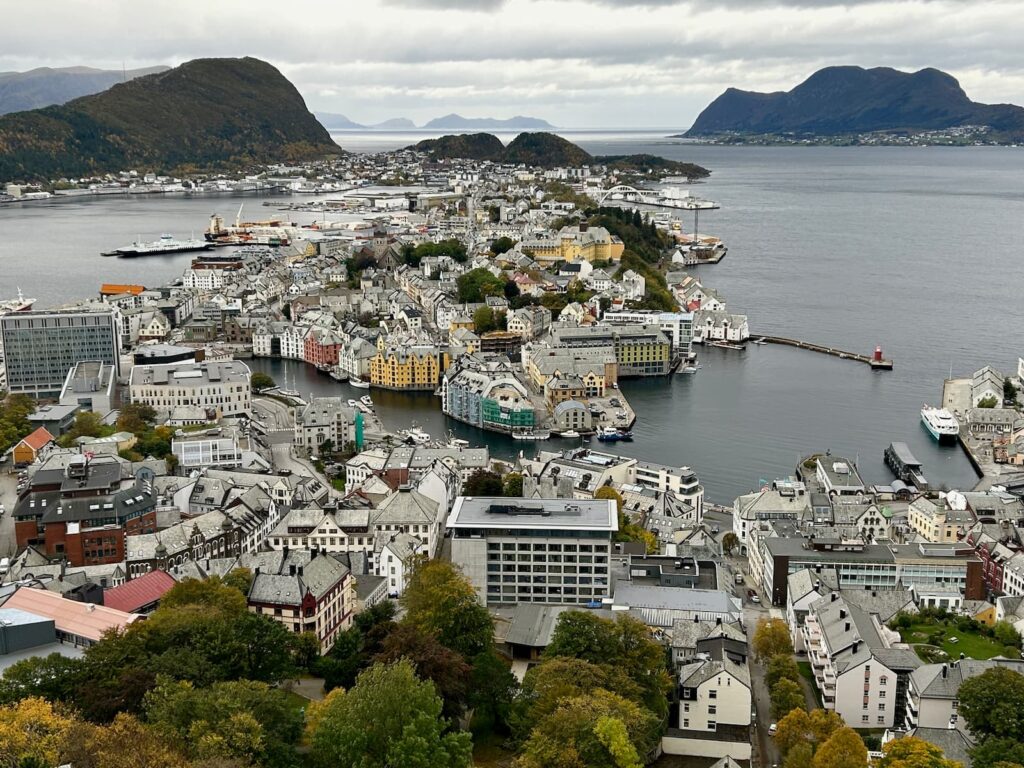
Alesund from the Aksla Viewpoint
We spent the night in Alesund at Downtown Historical House with Renovated apartments – a very well equipped apartment with kitchen and laundry. Highly recommended.
Alesund to Stryn: 13 October
After one more quick drive around the ‘old town’ we left Alesund taking the scenic route – the E39 – a beautiful drive along the fjord and lakes. Half an hour from Alesund we took a car ferry from Solavagen to Festoya (30 minute crossing), then followed E39 through beautiful Barstadvik alongside the Vartdalsfjorden – a stunning drive to Stryn.
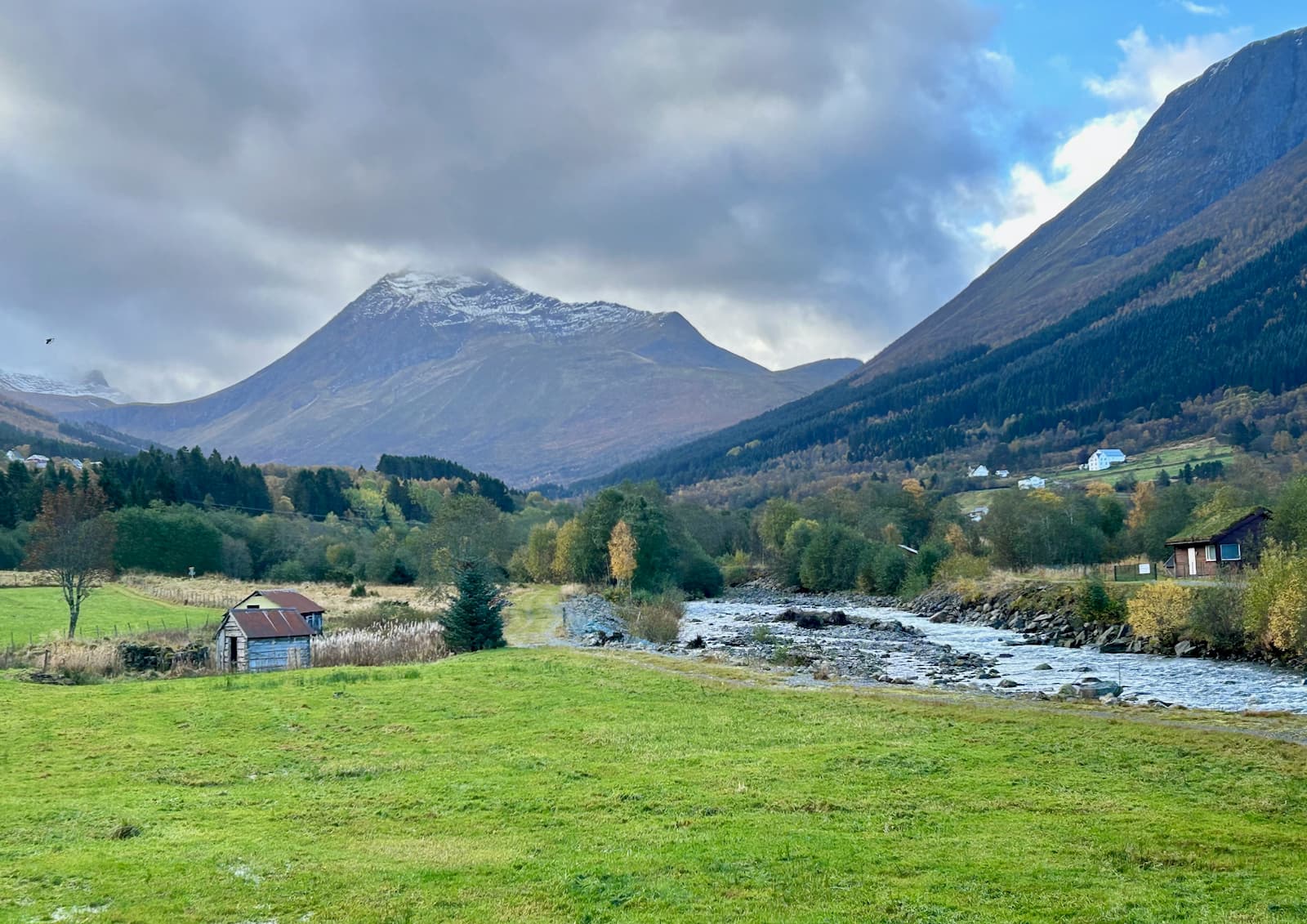
Barstadvik
Our accommodation was just a 7 minute drive from Stryn – Mindresunde Camping – an amazingly beautiful location on Stryn Lake (Strynevatnet). We had a lovely little cabin, spotlessly clean, right on the lake. As is the custom at this level of accommodation, we hired towels and bedlinen and made up our beds on arrival. Pillows and doonas provided. Our cabin – number 5 – had a kitchen/living room, bathroom and one bedroom with two twin beds, and another room with a bunk bed with double bed on bottom and single on top. We also had a little balcony with outdoor table and chairs overlooking the lake.
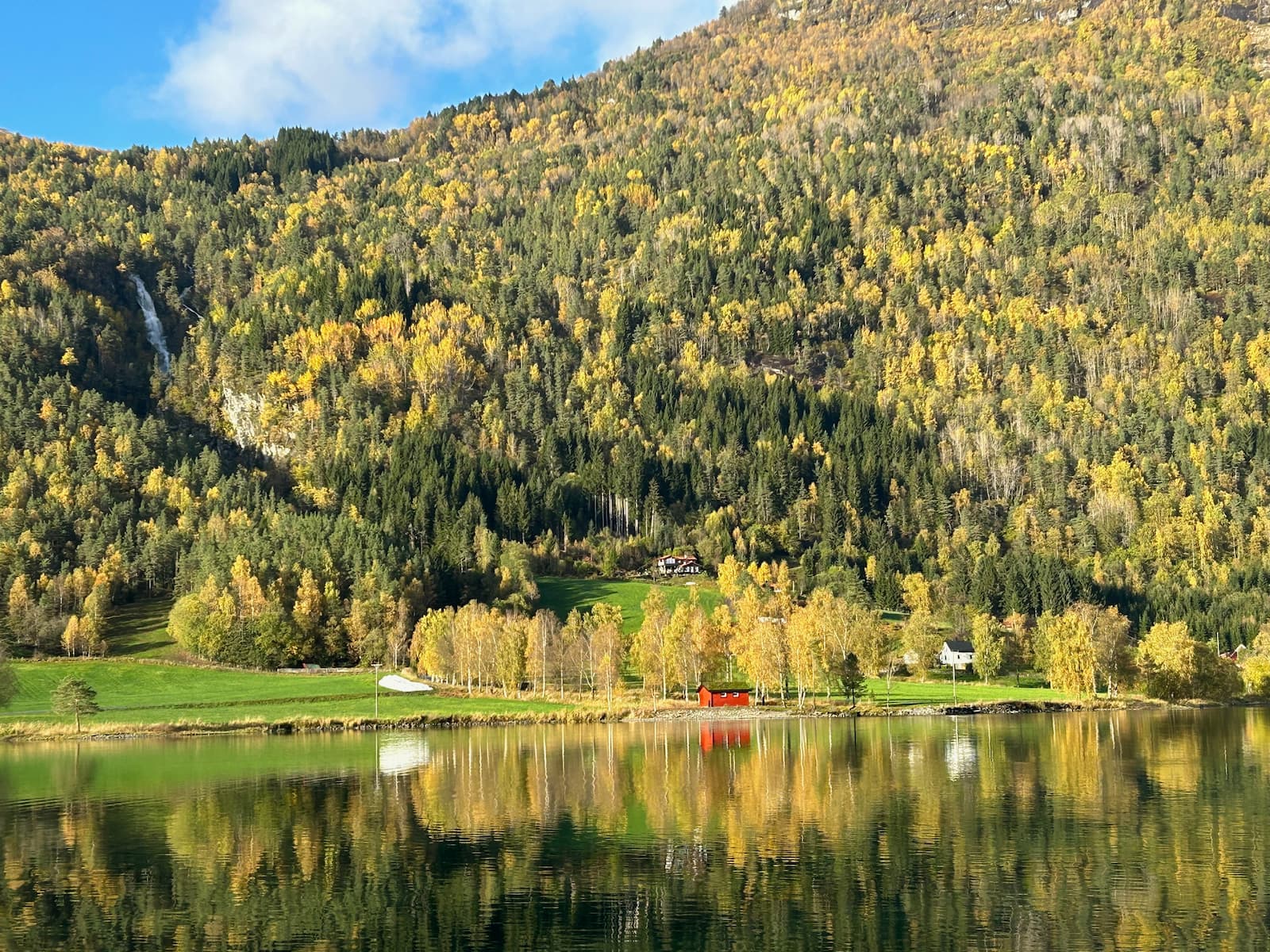
Stryn Lake
Stryn – Loen – Balestrand: 14 October
From Stryn we drove around the fjord to Loen (11km) – a very scenic drive with snow-capped mountains all around us. Just beyond Loen is beautiful Olden, on the southern shore of Nordjforden. We took the pretty road through the Oldedalen Valley to visit Briksdal Glacier (Briksdalsbreen).
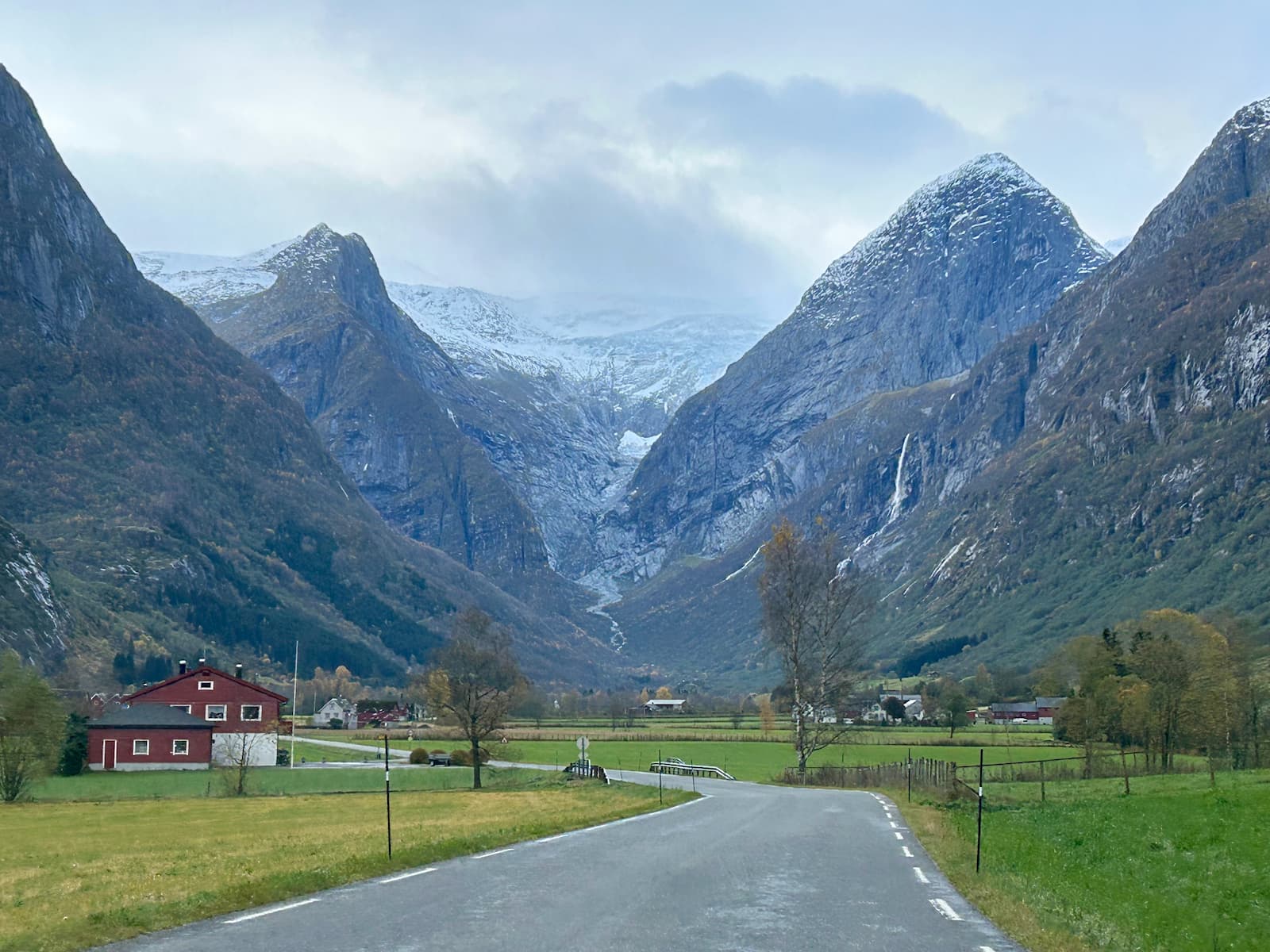
Oldedalen Valley
Briksdal Glacier
Short on time we took a troll car (or alternatively you can walk) for the 10-15 minutes/2.5km trip up to see the glacier (A$40 per person). We walked the last 600m to the glacier and the little lake. It is very beautiful and well worth doing – although very cold and windy at the glacier. We allowed about minutes there.
Leaving Briksdal Glacier, we headed back to Olden and from there drove around the fjord through Innvik, then to Utvik where we took Hwy 60 inland and met up with E39 at Byrkjelo. We had a quick but delicious lunch in Byrkjelo at Bakar Jon – a selection of burgers, kebabs, etc. It is also a gourmet supermarket. We each had a hamburger and bottle of soft drink for 345 Kroner (A$50). Food was delicious and plentiful. The cakes are also amazing.
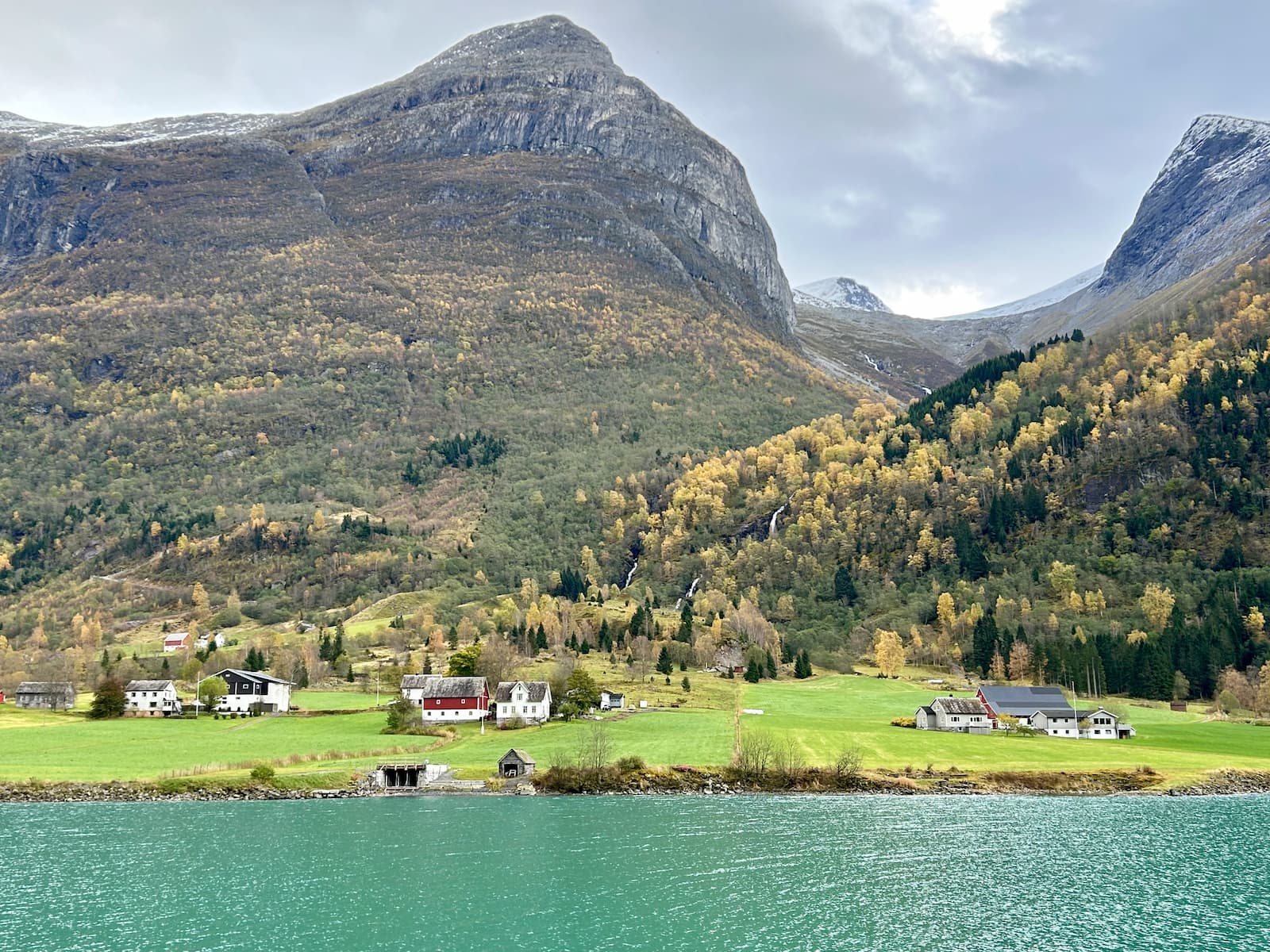
Olden
Continuing on we took the E39 to Skei. At Skei we came to Jolstravatnet (lake) which we followed in the direction of Forde. We then turned onto the Hwy 613 – part of the scenic Gaularfjellet National Tourist Route over the mountain. This was another road with gorgeous scenery – despite the rain and low cloud.
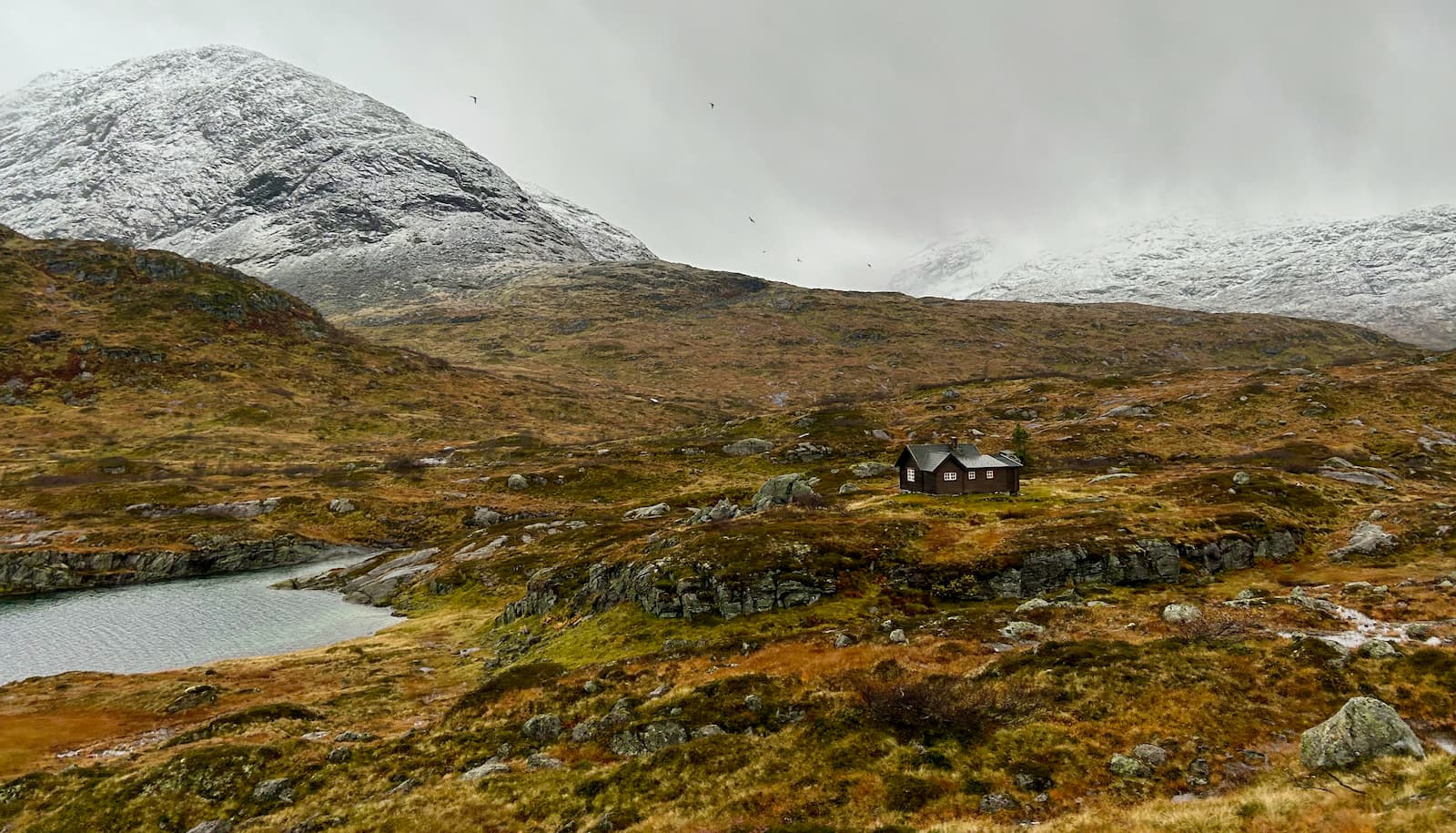
Gorgeous scenery along Gaularfjellet National Tourist Route
There are 3 recommended stops on this mountain road:
- Likholefossen waterfall – architecturally designed metal pedestrian bridge across Likholefossen waterfall. This is the start of the 21km Fossestien (‘the waterfall path’) nature trail.
- Torsnesstolen – the artwork of Marianne Heier consists of ten wells and one of those wells is located on the Gaularfjellet tourist route.
- Utsikten (the view) – an amazing viewing platform affording views of the mountain scenery and spectacular road snaking down the mountainside to the Bårddalen valley.
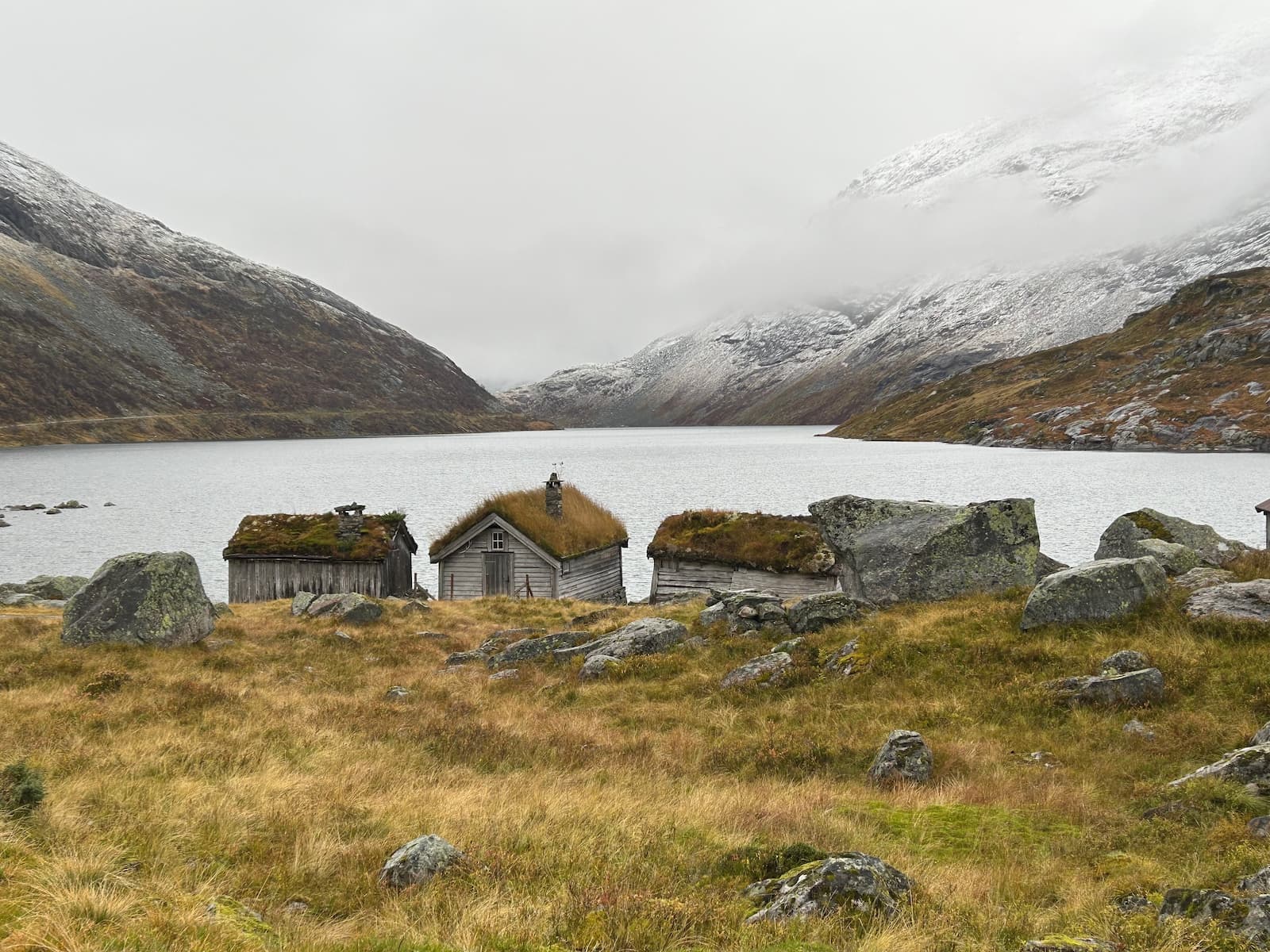
The Gaularfjellet National Tourist Route
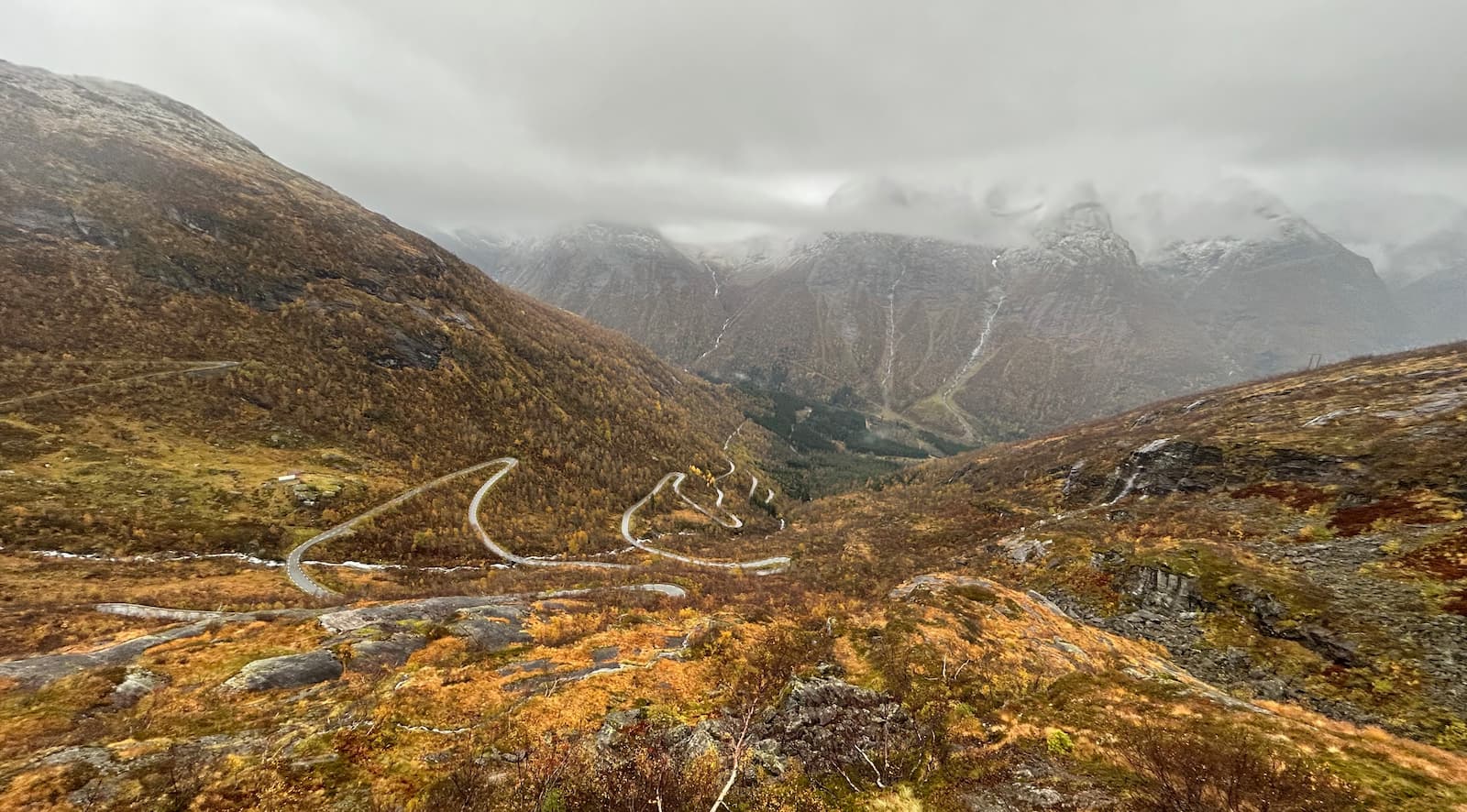
Accommodation in Balestrand: Balestrand Fjordapartments Holmen 19A – a beautiful apartment overlooking the little harbour on the Sognefjord – highly recommended.
Balestrand is a beautiful place with a long history as an art village and a tourist spot. It has a magnificent setting on the Sognefjord.
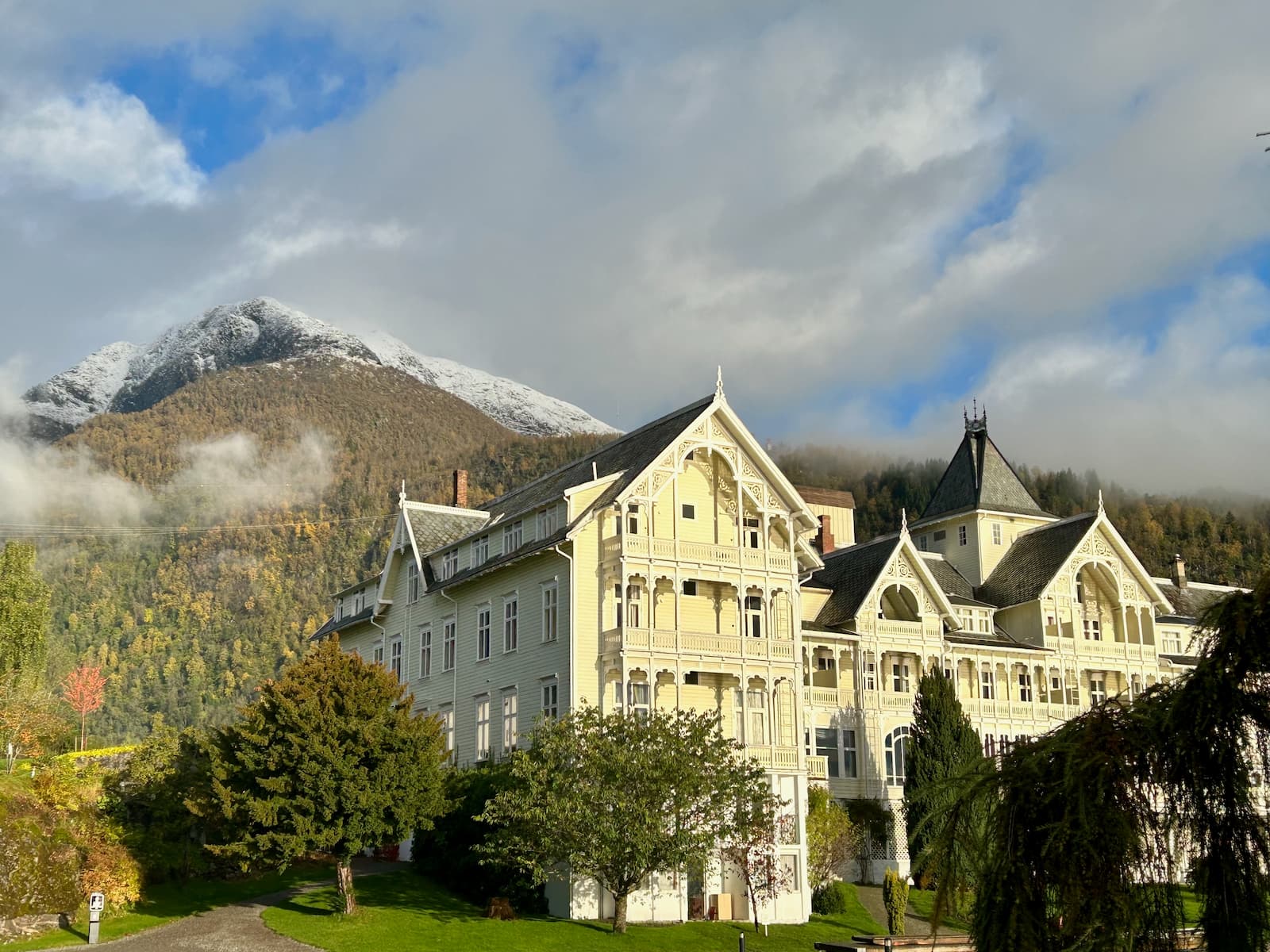
Balestrand’s Historic Kviknes Hotel, dating back to 1877
Balestrand – Bergen – Fly Bergen to Bodo: 15 October
Leaving Balestrand we took the short drive around the Esefjorden to Dragsvilk where we caught the Dragsvilk-Vangsnes car ferry. This half-hour ferry trip gave us fabulous views.
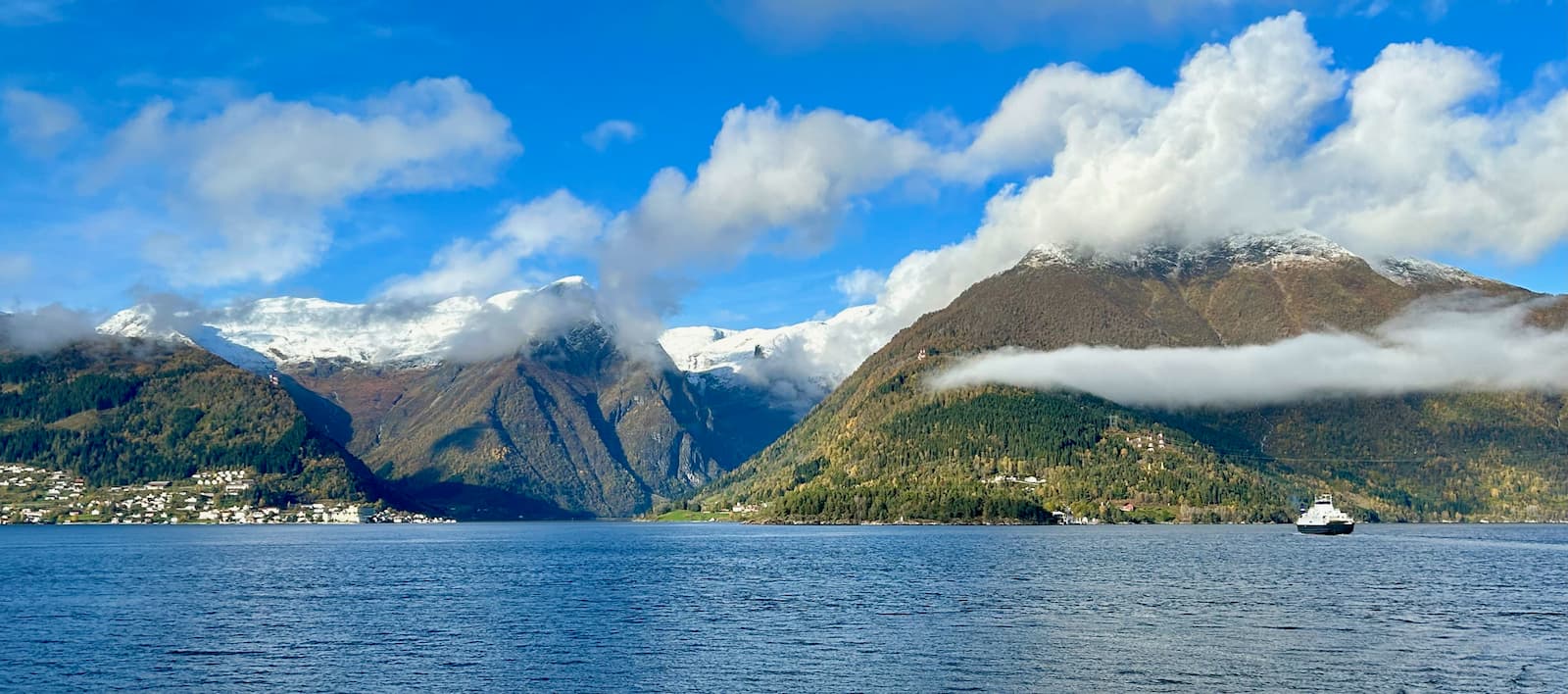
Views from the Esefjorden to Dragsvilk ferry
The scenery along the fjord was beautiful as we drove from Vangsnes to Vikoyri. There was a cruise ship in port at Vikoyri and so lots of people about. From Vikoyri we continued on Rte 13 in the direction of Voss.
The mountain road (Rte 13) between Vikoyri and Voss is called the Vikafjellet road. Climbing up out of Vikoyri – there are spectacular views back across Sognefjord and the mountains.
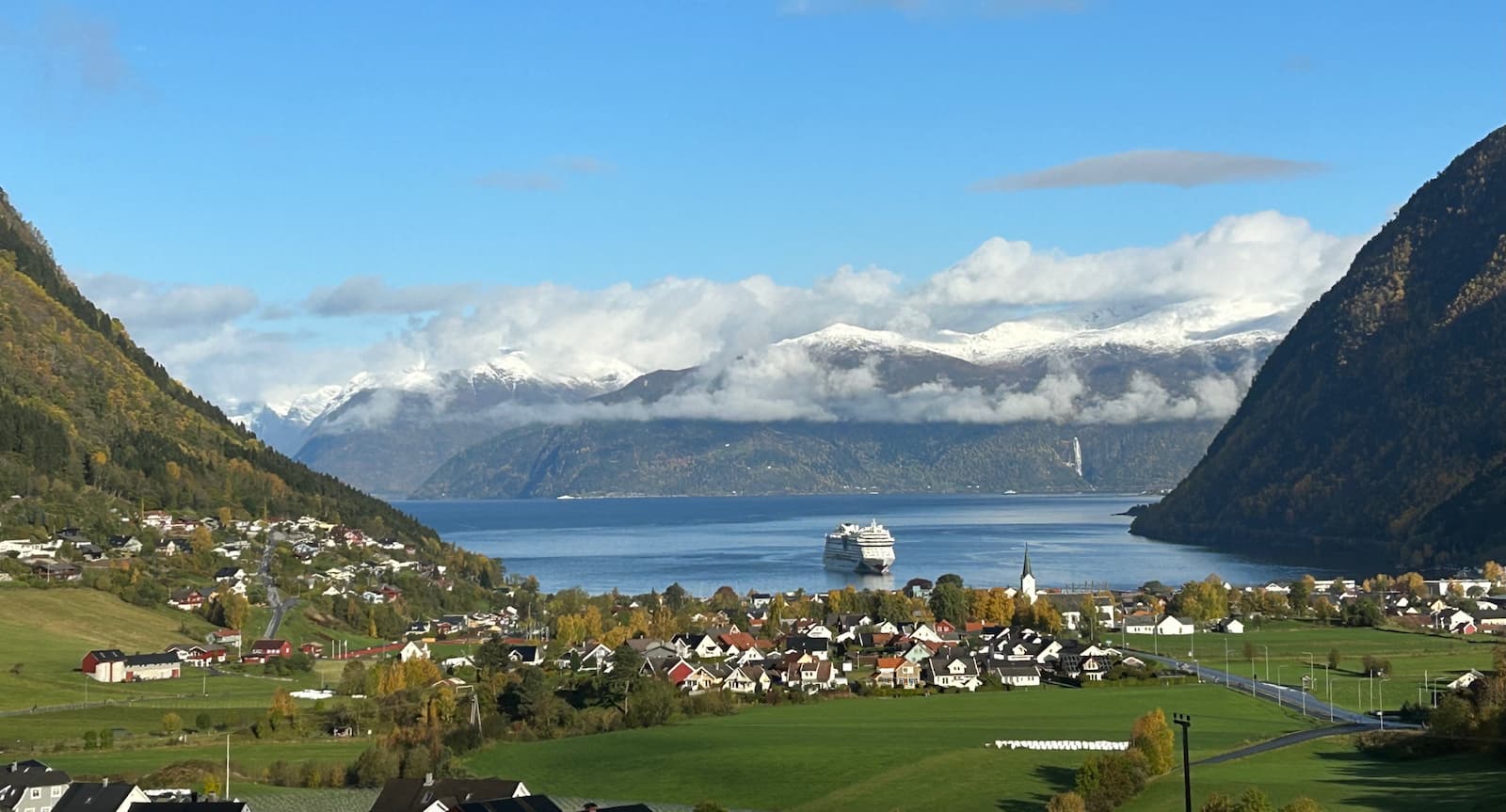
View back to Vikoyri and the Sognefjord
As we climbed higher there was snow all around – beautiful.
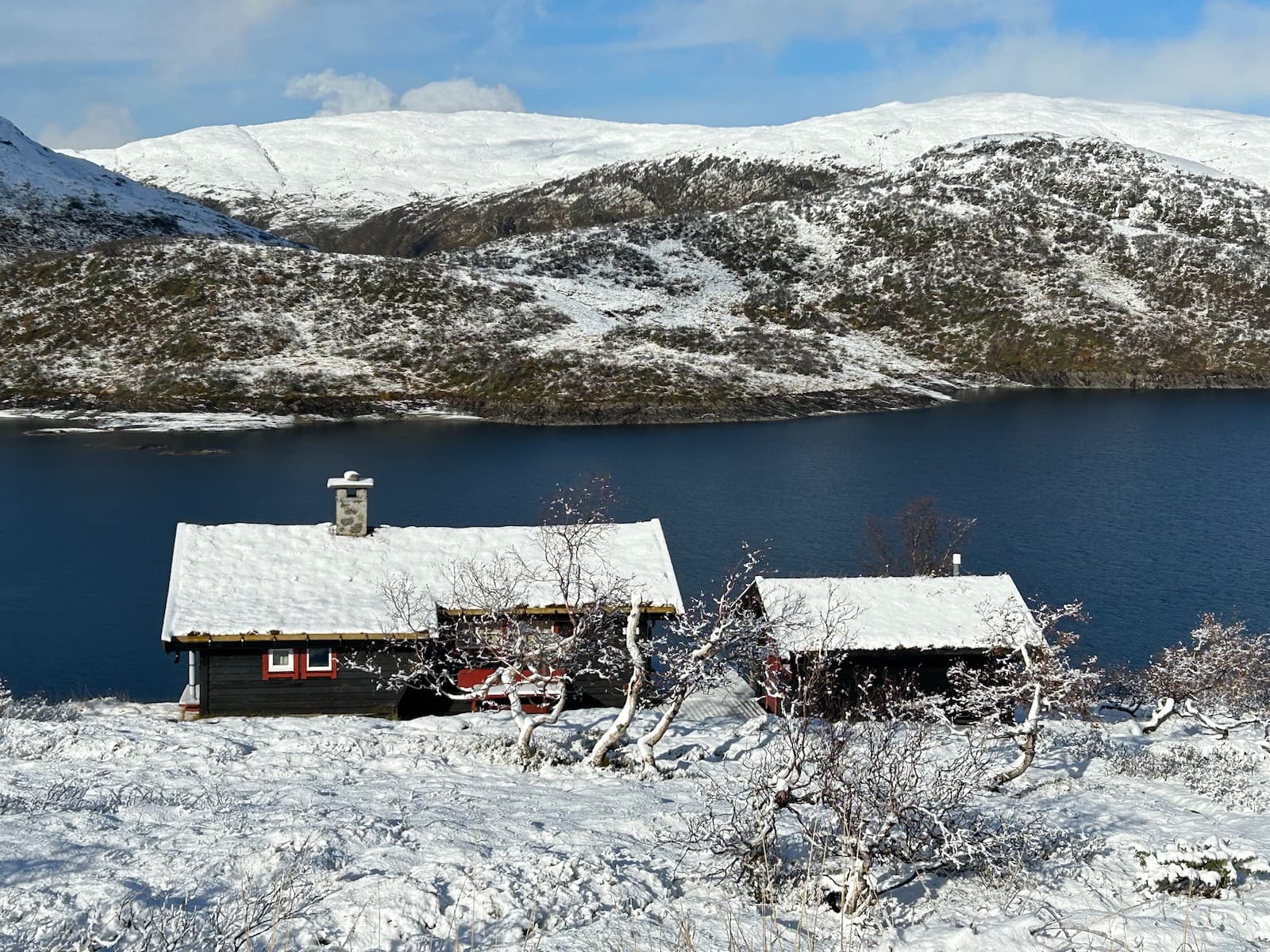
Snow along the Vikafjellsvegen (Rte 13)
Just before the zig-zag road (Myrkdalsvegen/Serpentinvegdown) down off the mountain road we stopped to take in the spectacular view of the Kvassdalen valley below.
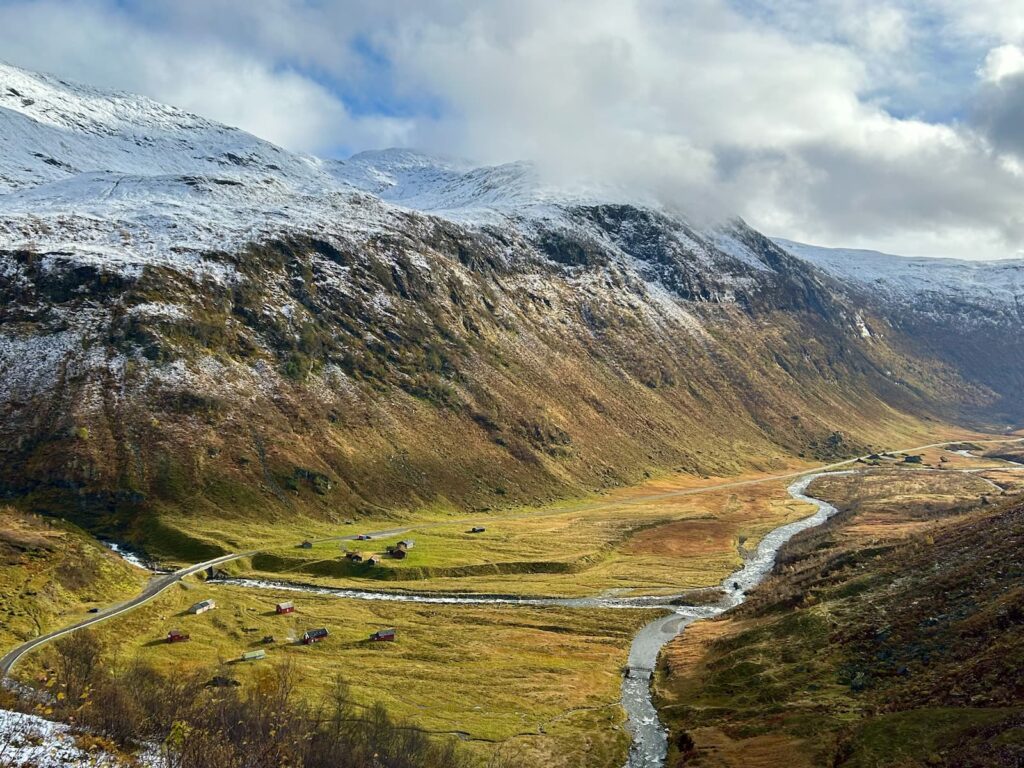
Kvassdalen Valley
At the bottom of the road there are views of the Sendefossen waterfall.
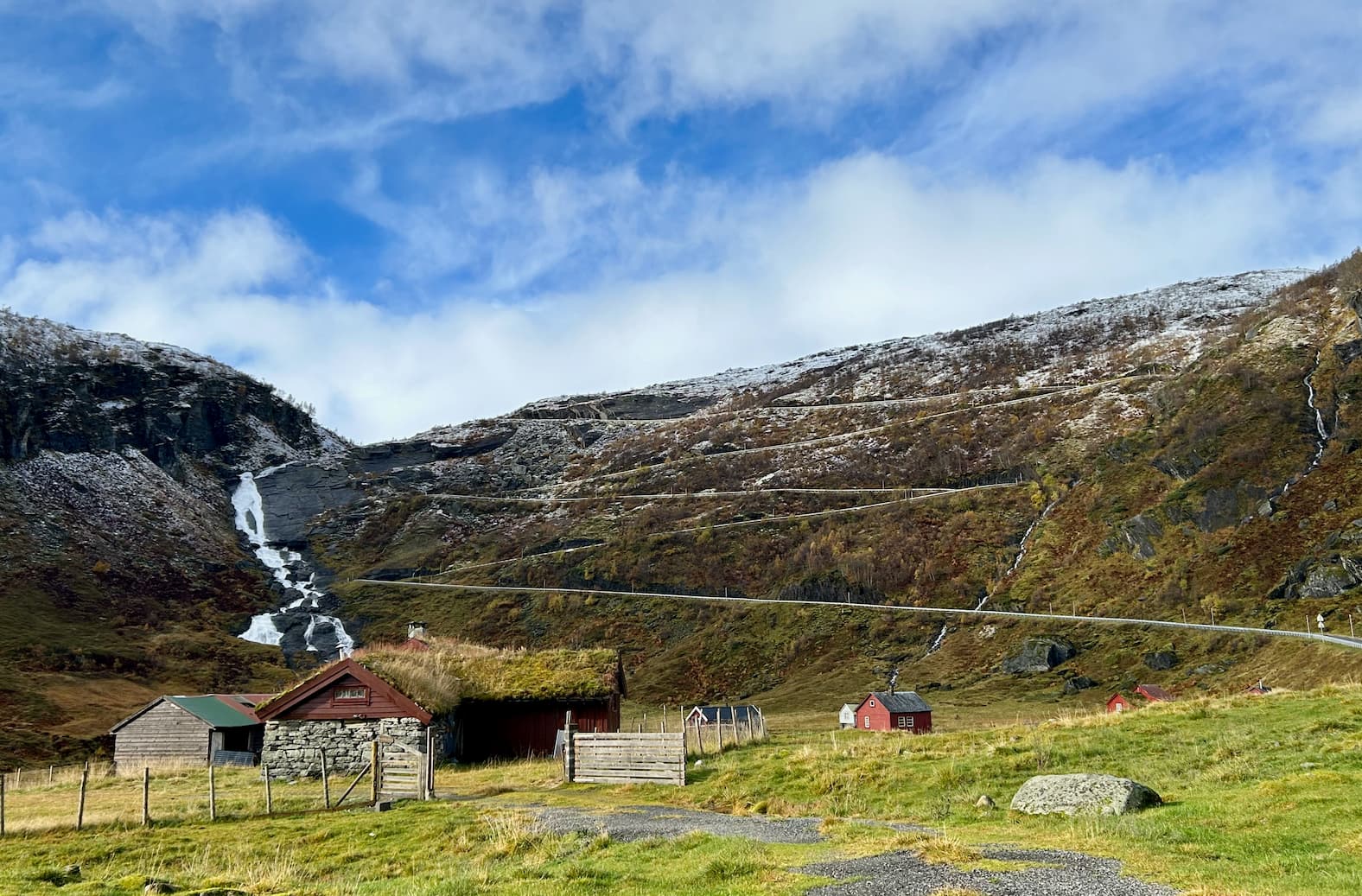
Sendefossen waterfall
At Vinje we turned on to Rte 16 and followed Google maps to Bergen airport where we dropped off the Sixt hire car and took a Wideroe flight to Bodo. At Bodo Airport we rented another Sixt car so that we could self-drive through the Lofoten Islands. We spent the night in Bodo before setting out the next day.
Accommodation Bodo: Aurora Central Premium Apartment Bodo – a brand new apartment – highly recommended.
LOFOTEN ISLANDS
The Lofoten Islands are a string of islands located in the north of Norway known for their wild, natural beauty. The steep and dramatic Lofotenveggen (Lofoten Wall) mountains run the length of the islands. There are charming and picturesque fishing villages throughout. Fishing has always been an important source of income, with the islands’ most famous export being dried cod (stockfish). We saw many timber drying racks (empty in October) used to dry the fish. We loved the colourful houses and the traditional fishermens’ cabins called rorbu (many are now used for tourist accommodation).
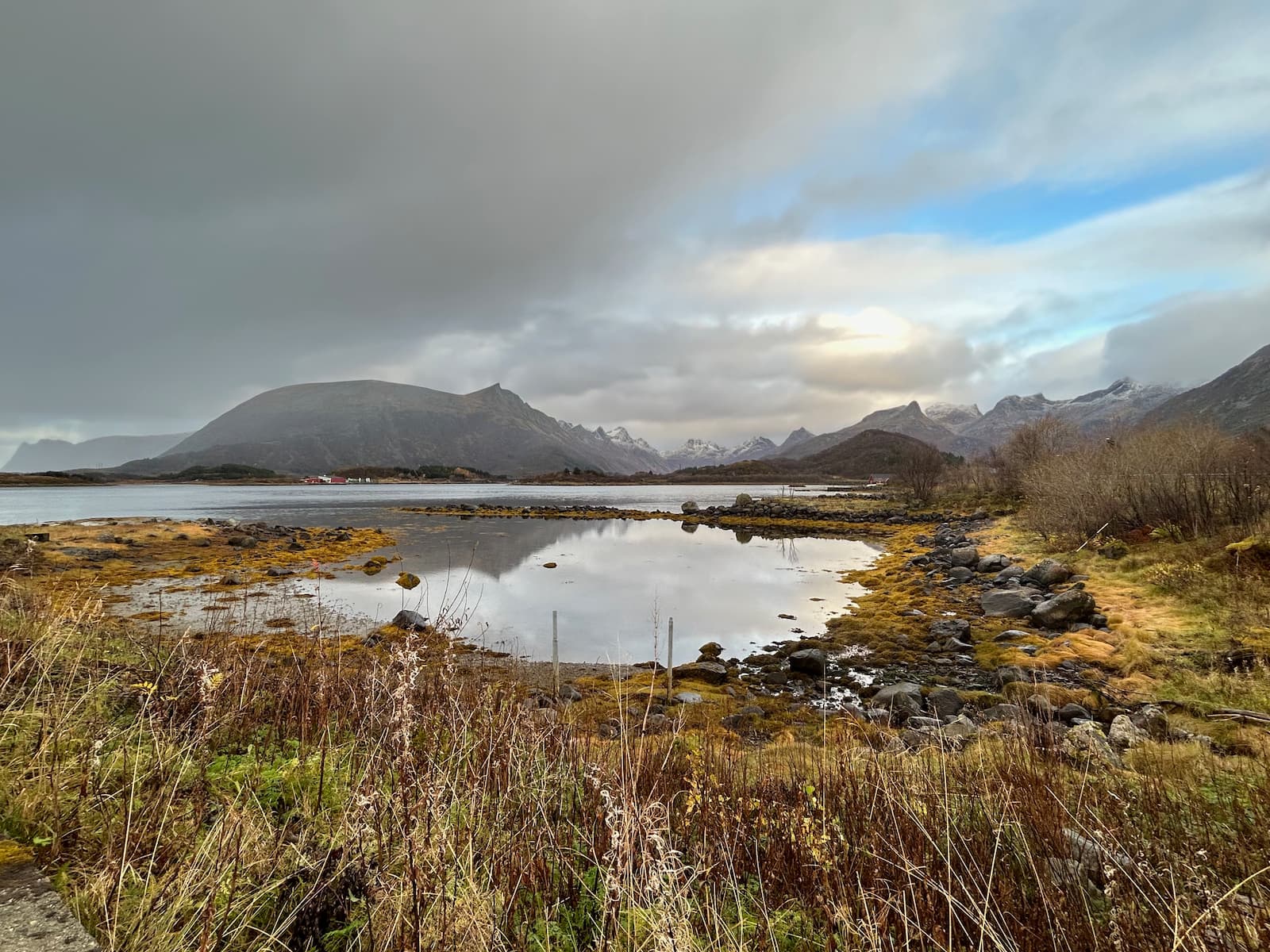
Lofoten Islands – Austvagoy
The Lofoten Islands are divided into six areas (from north to south):
- Austvågøy & Gimsøy
- Vestvagoy
- Flakstad
- Moskenesoya
- Vaeroy
- Rost
We drove most of those from north to south but didn’t get as far as Vaeroy and Rost – they are not accessible by road.
Must-See Lofoten Villages
We loved the picturesque villages along the way – some of the must-see villages are:
- Henningsvaer – a popular village with cafes, art galleries and boutique hotels. It’s a bit off the beaten track but offers a unique blend of traditional and modern charm.
- Nusfjord – a well-preserved historical fishing village. It’s a must-see for its stunning location and historical significance.
-
Reine – one of the most photographed villages in the Lofoten Islands – stunning location.
-
A i Lofoten – located at the southern tip of the Lofoten Islands, Å is a charming village – it’s the last village accessible by car on the E10 scenic road. A is well known for its Norwegian Fishing Village Museum.
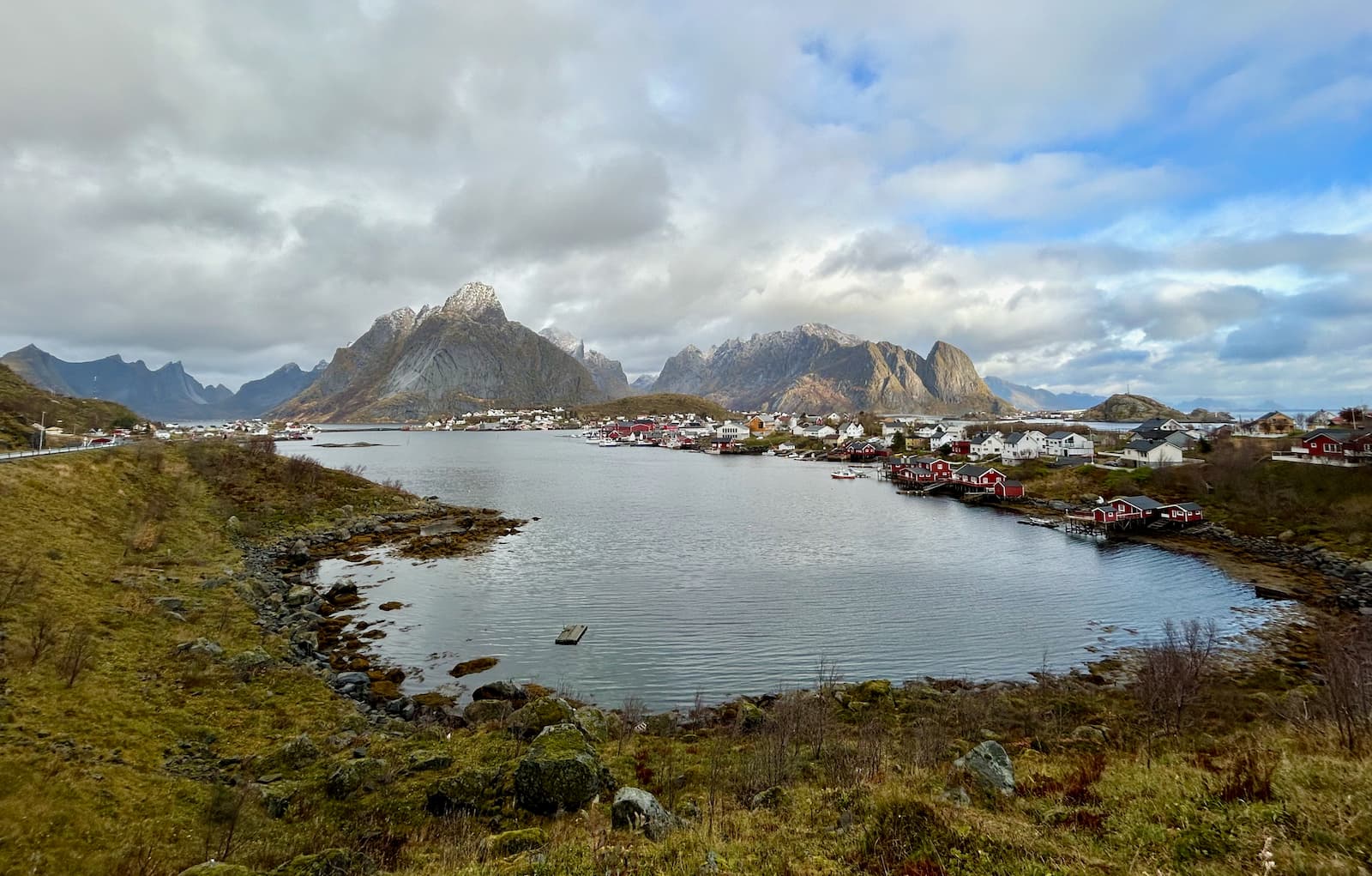
Reine, Lofoten Islands
Driving Lofoten – the National Tourist Route
It is easy to drive through the Lofoten Islands. There is one main road – the National Tourist Route, or E10 – its about 230kms one way. It is a very good road and in October not crowded at all. There are many detours along the way – just off the E10 – including Henningsvaer, Eggum, Unstad, Utaklieiv, Vikten and Nusfjord.
Getting to Lofoton Islands from Bodo
If doing a self-drive trip from Bodo, the ideal way to get to the Lofoten Islands is to take the car ferry between Bodo and Mosknes (a 3-4 hour trip) and drive through the islands (south to north) and drive back around to Bodo taking the Bognes to Logingen ferry. You could do the trip either clockwise or anticlockwise, it doesn’t really matter.
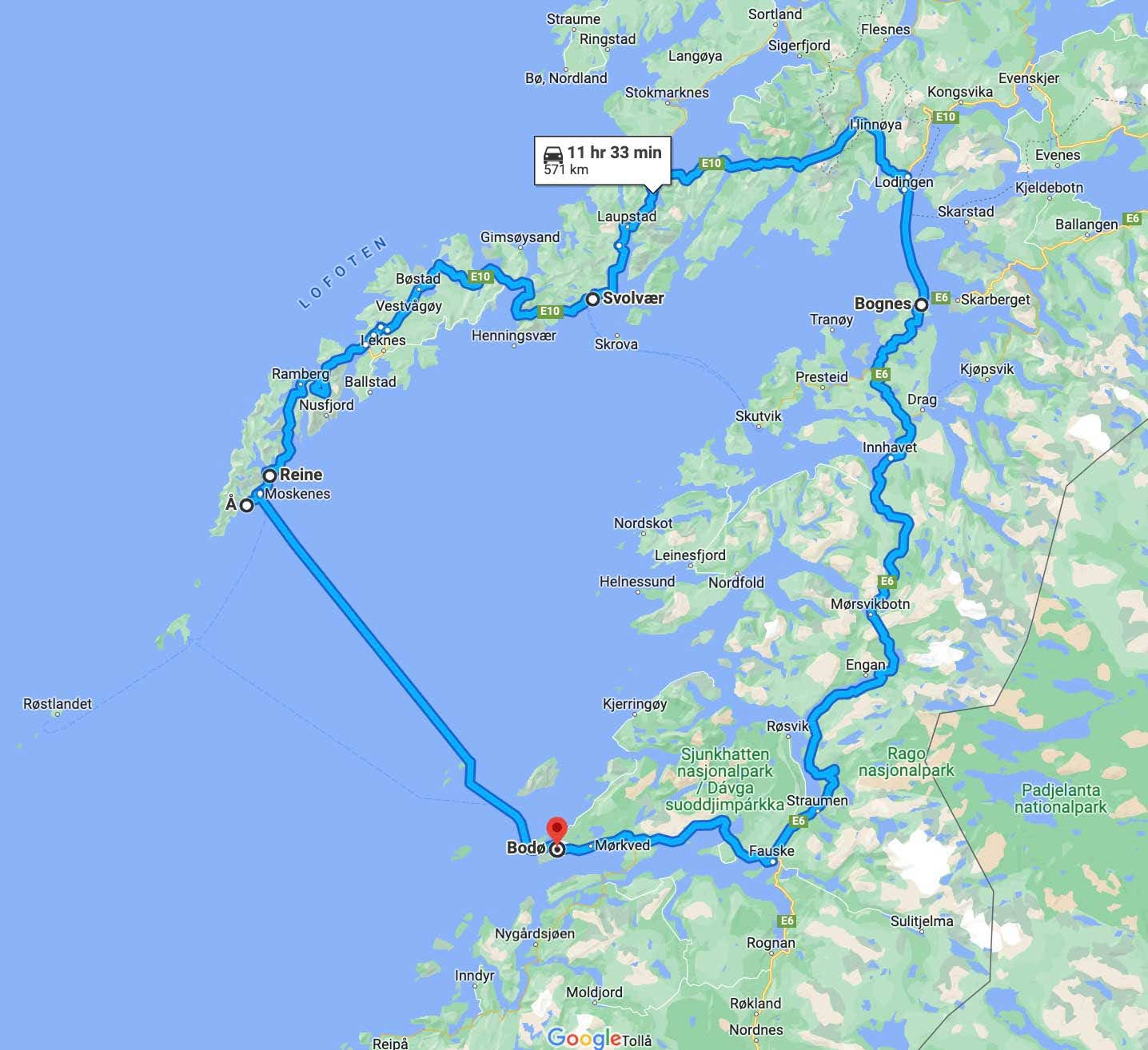
Lofoten Island – the Ideal Itinerary
Unfortunately the timing of our trip resulted in the Bodo-Mosknes car ferry not being an option for us. In the offseason there are fewer ferries running, so check that there is a ferry running on the day you are there, plus it is advisable to book a space on the ferry in advance.
So instead of taking the Bodo-Mosknes ferry, we drove from Bodo to Bognes and took the Bognes to Logingen ferry across to the Lofoten Islands, spent a couple of days on the Islands, then returned to Bodo the same way.
Our Itinerary
Bodo – Laupstad – Svolvaer – Rorvik Beach – Henningsvaer – Valberg and Stamsund – Leknes – Vik Beach, Haukland Beach & Uttakleiv Beach – Nusfjord – Reine – A – Eggum – Kabelvaag – Svolvaer – Bodo.
At A we turned around and drove back to Bodo (breaking the trip in Svolvaer). Alternatively, it is possible to take a car ferry between A and Bodo but the timing of the ferry did not suit us unfortunately.
Following is our itinerary through the Lofoten Islands in more detail.
Bodo – Svolvaer: 16 October
We drove from Bodo to Bognes (3 hours 15 minutes on Hwy E6), took the Bognes-Lodingen car ferry (1 hour), then drove Lodingen to Svolvaer (1.5 hours). It is a scenic drive, especially between Lodingen and Svolvaer, with many tunnels along the way.
Just before Svolvaer we made a stop at the Austnesfjorden rest area where boardwalks provide a short walk to take in the beautiful views of the fjord and rugged mountains. Well worth the stop.
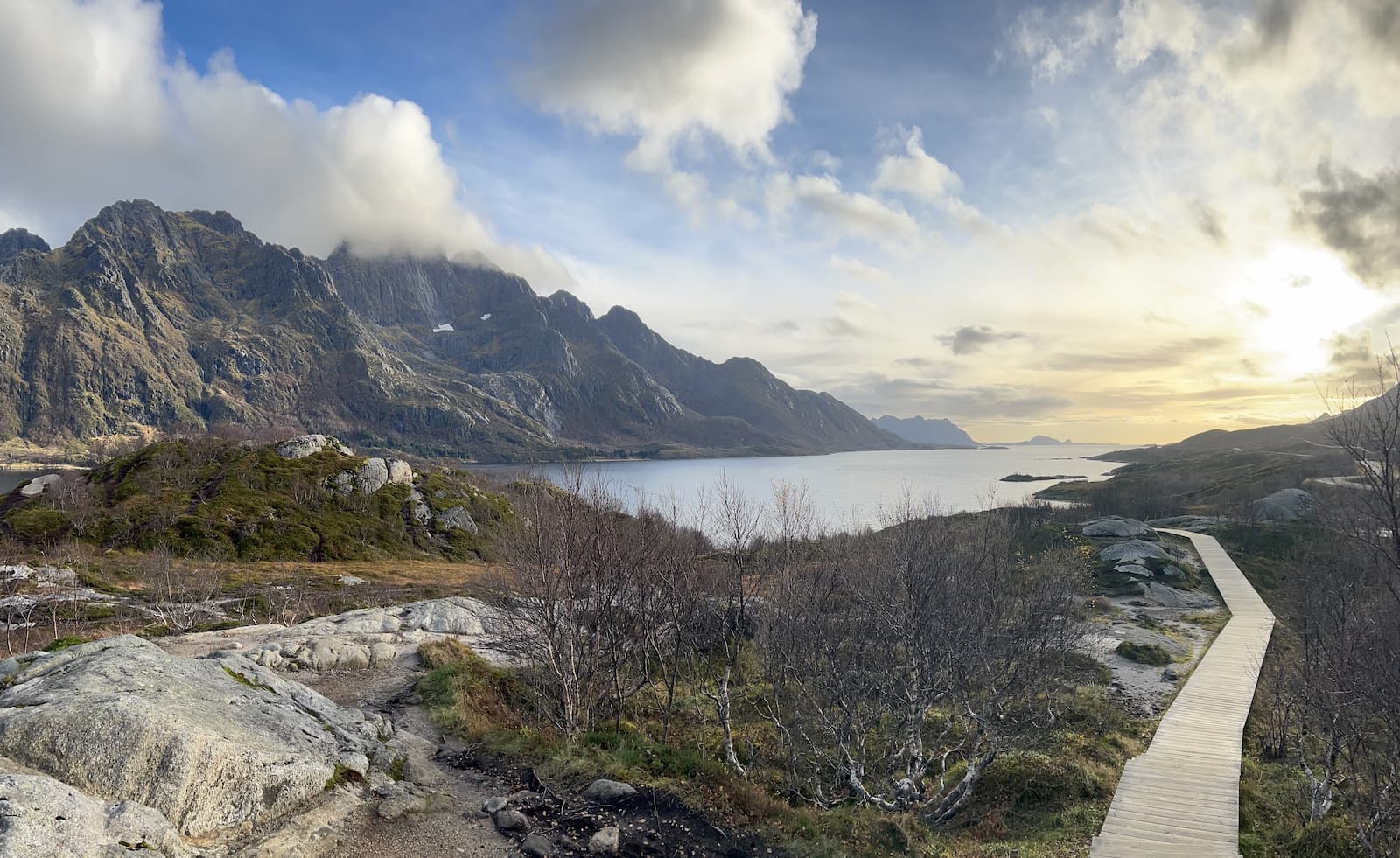
View from Austnesfjorden Rest Area
Our first night on the Lofoten Islands was in Svolvaer – the largest town on the Lofoten Islands and essentially the gateway to the islands. Our accommodation was a renovated rorbu (fishermen’s cabin) at the charming Svinøya Rorbuer on Svinoya island, about 3kms from the centre of Svolvaer.
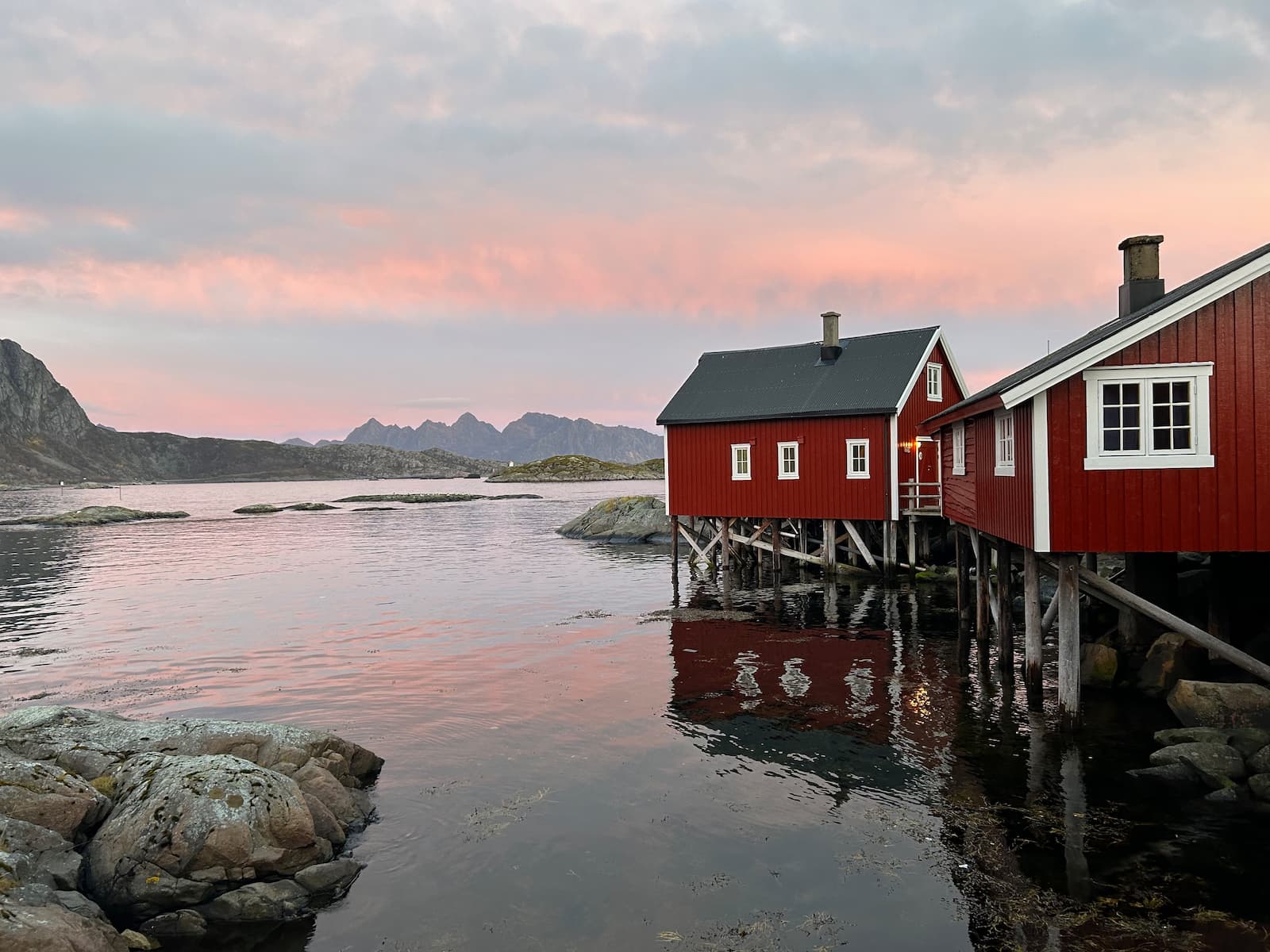
Rorbuer (fishermen’s huts) – at Svinoyer Rorbuer
Svinoya Island is the oldest part of Svolvaer. It was established in 1828 and, in those days, was the heart of the fishing village with a grocery shop, bakery, telegraph station, wharves and warehouses. The Berg family owned property here and many historic buildings remain. The Svinoya Rorbuer hotel has rebuilt and refurbished a number of fishermen’s cabins for accommodation as well a number of historic buildings including the Manor House (originally the Berg family home).
The reception area for Svinoya Rorbuer is located in what was the first grocery shop in Svolvaer – with the shop still intact for display purposes. The renowned Borsen Restaurant is in the same building. The Gunnar Berg Gallery is another attraction on Svinoya. We loved our stay in this historic area – highly recommended.
Photos of Svinoya:
Attractions in Svolvaer:
- Cruise the Trollfjord – beautiful, photogenic fjord, 2.5 km long and only 100 meters wide at the mouth.
- Take a ferry to Skrova
- Svinøya Island – the original fishing village of Svolvaer
- Lofoten Krigsminne Museum – WWII war museum
- Magic Ice Lofoten – ice sculptures and artworks
- Lofotpils Brewery – to sample local brews
- Visit local art galleries – North Norwegian Art Centre, Gallery Dagfinn Bakke, Gunnar Berg Gallery.
Rorvik Beach (Rørvikstranda)
Rorvik Beach is a beautiful beach about 20 minutes drive from Svolvaer on the way to Henningsvaer (it is just off the E10 at the turnoff to Henningsvaer).
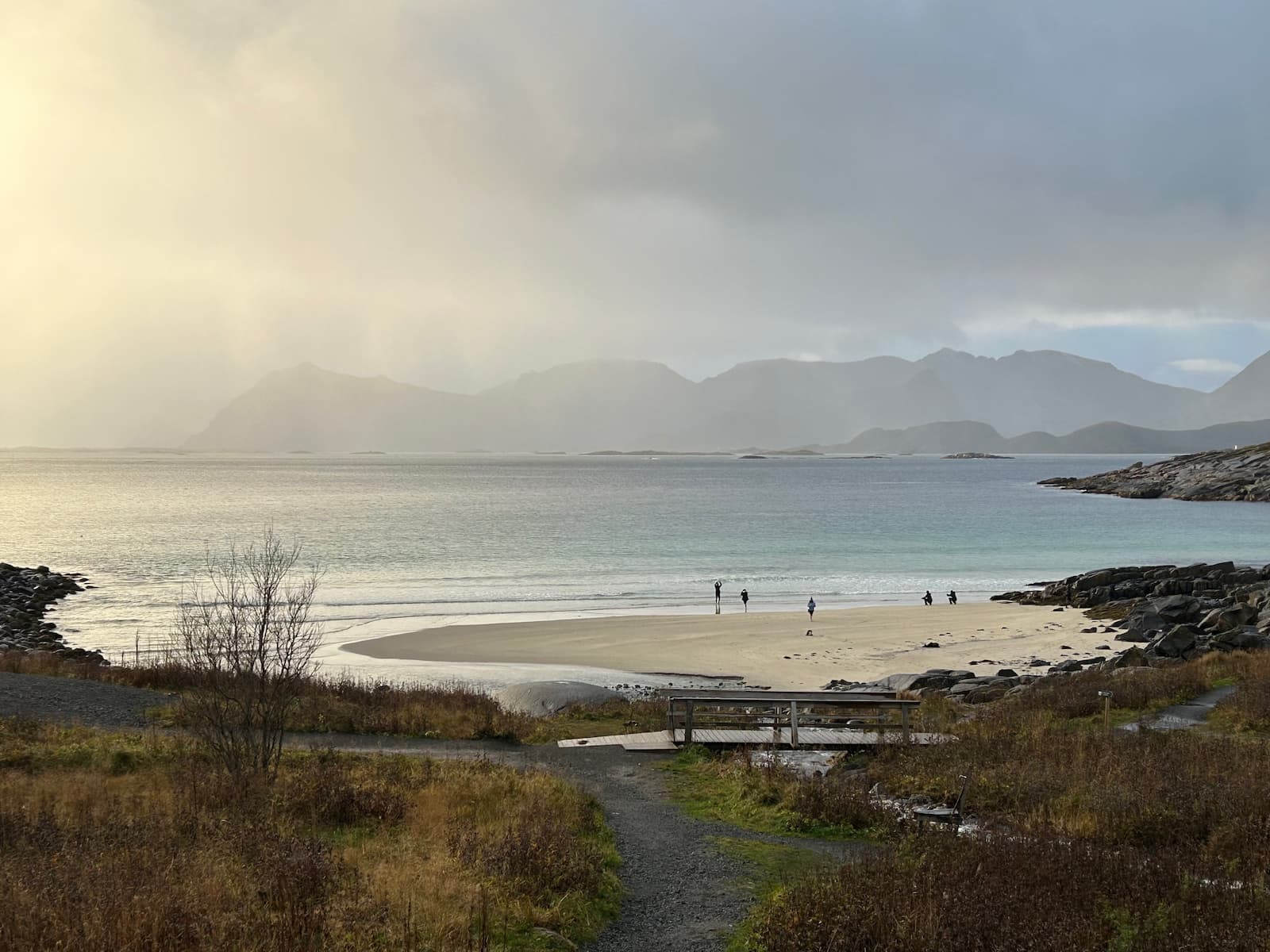
Rorvik Beach on the road to Henningsvaer
Henningsvaer
About a 30 minute drive from Svolvaer, Henningsvaer is a fishing village located over several small islands. It has a rich history in fishing and a very picturesque setting. There are chic shops, cafes and accommodations. A very attractive place – a mix of a traditional fishing village and modern tourist destination – highly recommend a visit. It has a soccer field with the most incredible location!
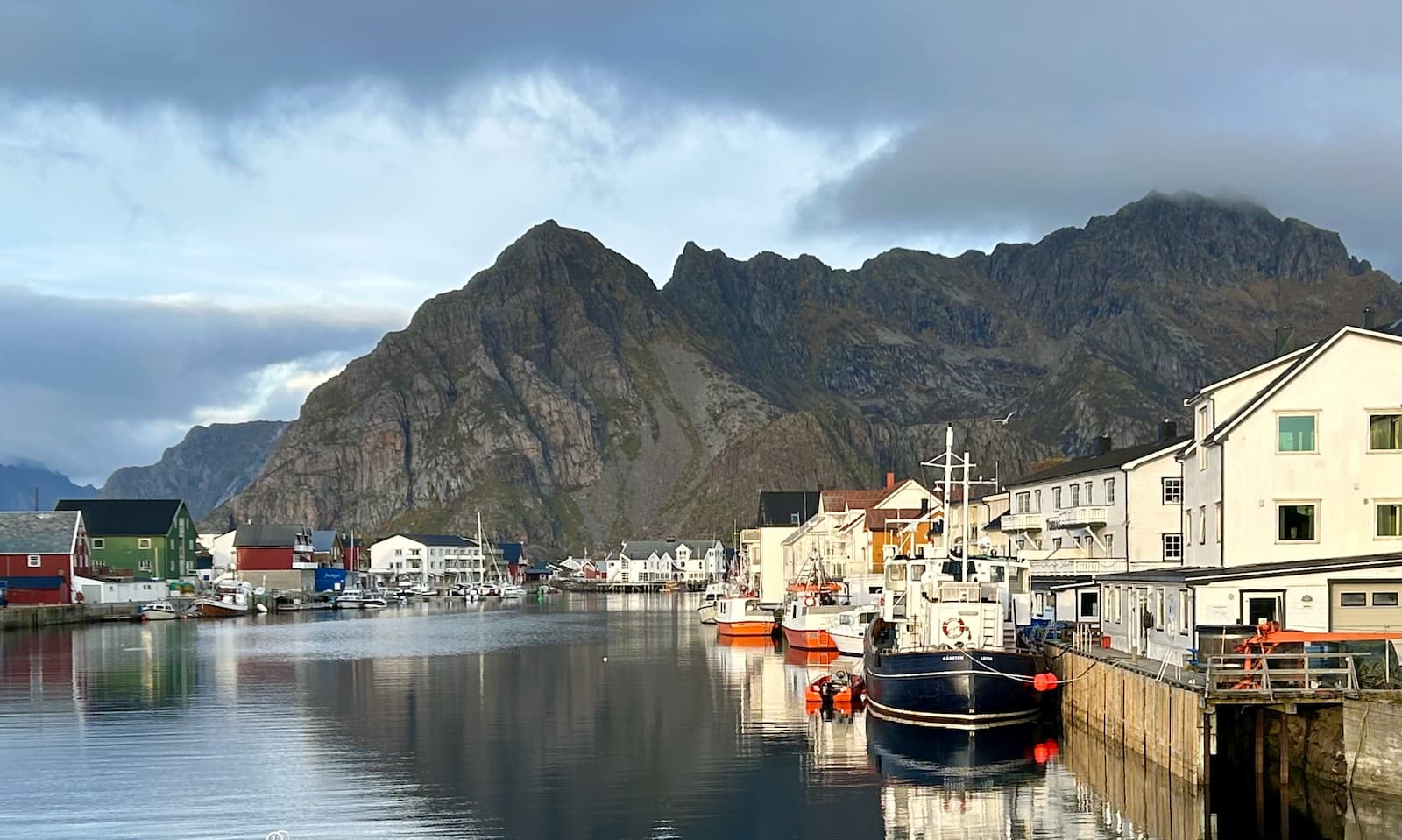
Henningsvaer – main harbour
Highlights of Henningsvaer:
- Gallery Engelskmannsbrygga – beautiful arts and crafts
- Gallery Kaviarfabrikken – gallery of modern art
- Trevarefabrikken – hotel, cafe, pizzeria, brunch restaurant (Hermetikken) and wine bar (Trandamperiet).
- Lofoten Wool – founded by textile artist Raghild Lie, this is a Norwegian company specialising in high-quality locally produced wool products sourced from sheep raised in the Lofoten Islands and Northern Norway.
- Soccer field amongst the timber fish-drying racks surrounded by the sea – unique!
Photos of Henningsvaer:
Svolvaer – Reine – 17 October
Leaving Svolvaer we followed the E10. Just over the Gimsøystraumen Bridge we turned right onto a smaller road around to Gimsoysand where there is a white sandy beach. This scenic road looped back onto the E10 where we quickly took a left onto Rte 815 towards Valberg and Stamsund, following the coastline the whole way – a very pretty drive. If you are in Stamsund between April and August, be sure to call into the Lofoten Wool Farm Shop.
Leknes
After Stamsund our next stop was in Leknes, where we joined the E10 again. We had a delicious lunch at Lofoten Bakery in Leknes – highly recommended.
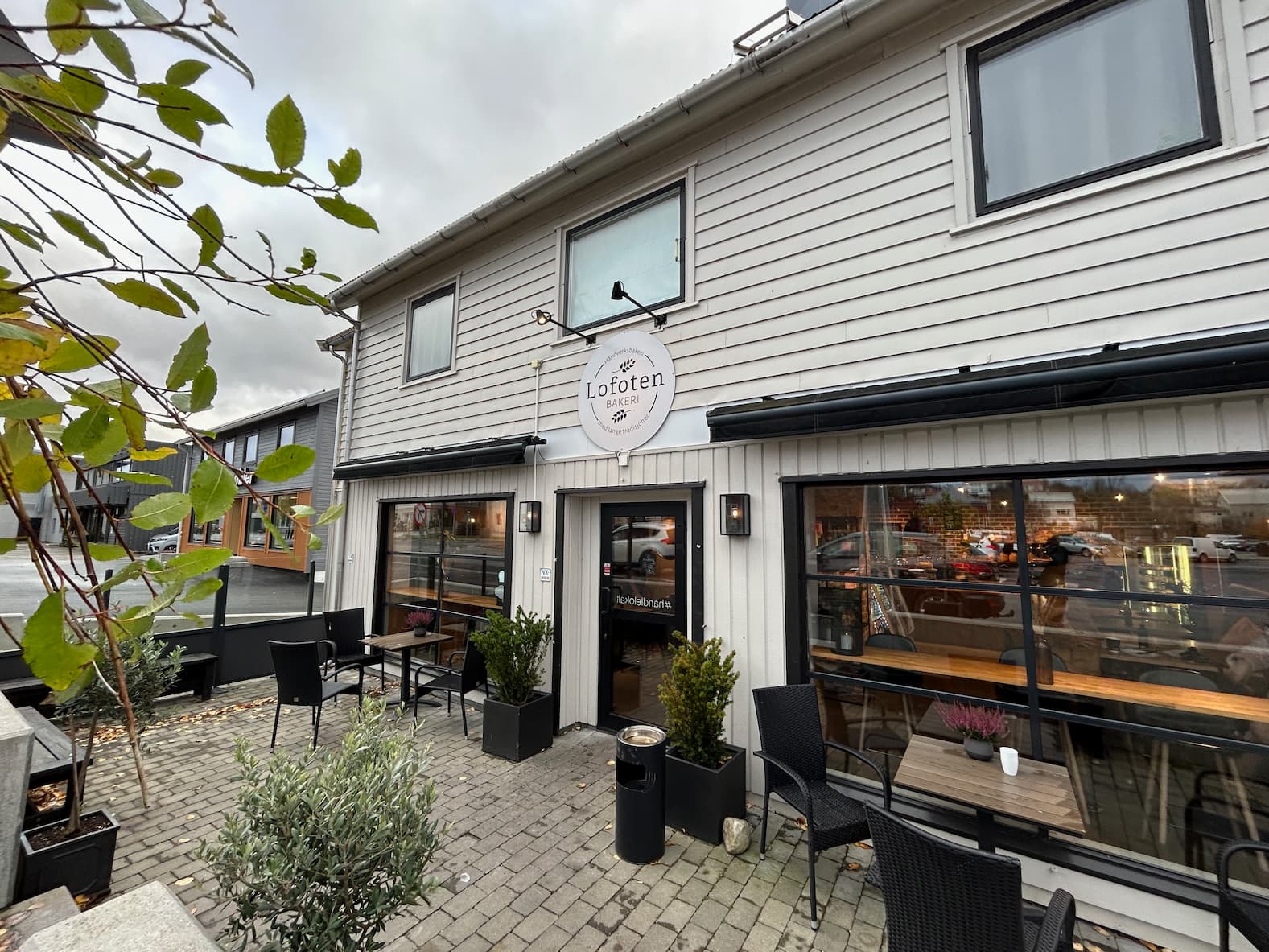
Lofoten Bakery, Leknes
Vik Beach, Haukland Beach & Uttakleiv Beach
From Leknes we drove to beautiful Vik Beach and neighbouring Haukland Beach (one of the most famous of the Lofoten Islands) – even on a cloudy day we could see that these would be popular in summer. From there we followed the road signs through the little tunnel to pretty Uttakleiv Beach. If the weather is good, there is a 4km walking trail around the headland from Haukland Beach to Uttakleiv Beach.
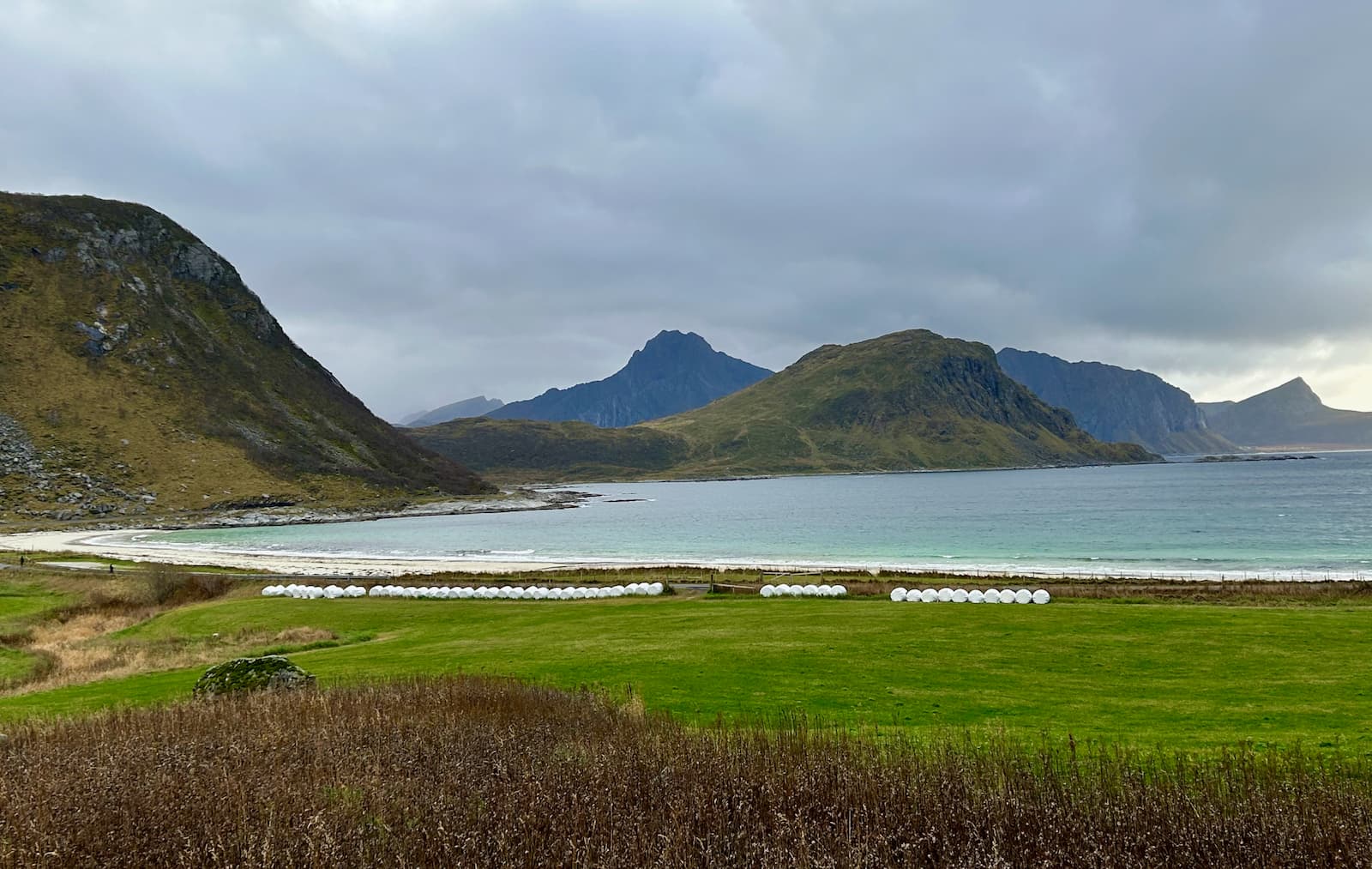
Vik Beach
Back on the E10 we crossed a bridge onto Flakstadoya and drove around the picturesque Flakstadpollen bay and fjord.
Nusfjord
We took a detour off the E10 to visit the historic fishing village of Nusfjord and surrounds. The coastal scenery is beautiful and there are many fishermen’s cabins in the area – it is all very photogenic. Nusfjord village has a stunning location and is well preserved but these days only a handful of permanent residents live there. The village and the rorbuer are now given over to tourism, with the main accommodation provider being Nusfjord Village & Resort who have done a good job preserving this beautiful village. To help maintain the village there is an entrance fee however when we visited late in the day we didn’t encounter this.
There are a few good places to eat in Nusfjord.
We loved our visit to Nusfjord and surrounds and can highly recommend a visit.
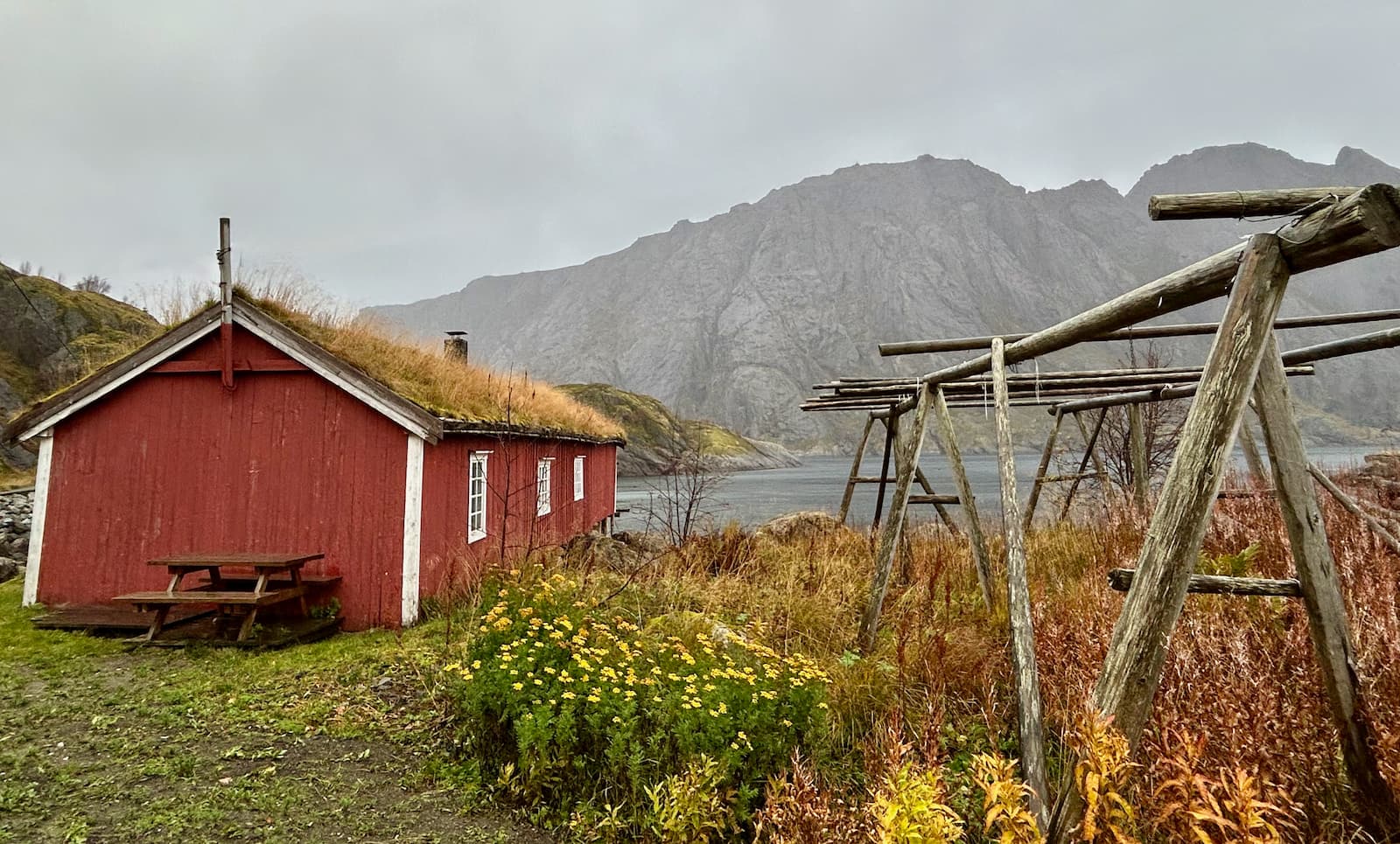
Vika near Nusfjord
After visiting Nusfjord we got back onto the E10 and followed that through Flakstadoya – beautiful scenery.
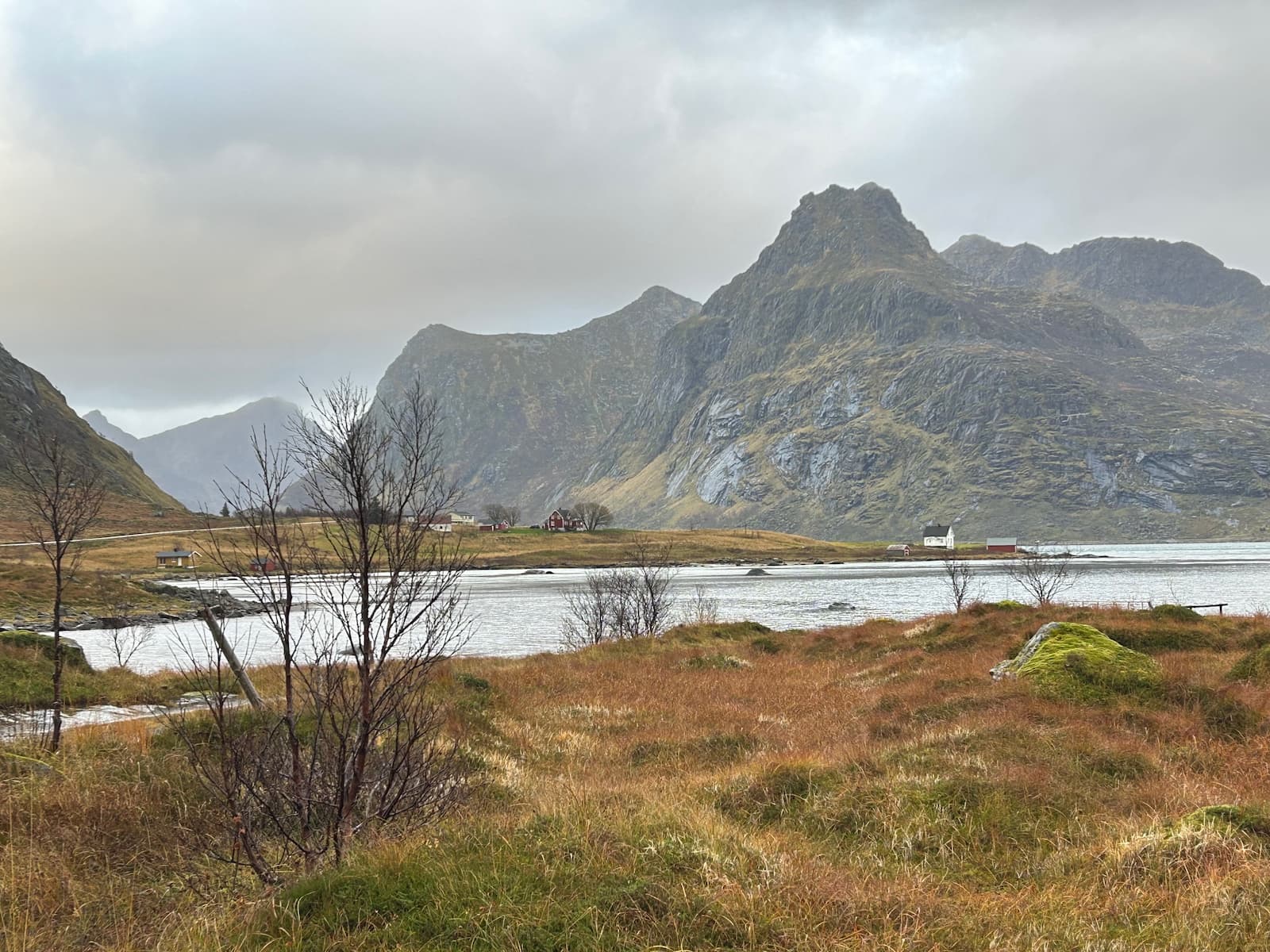
Boosen Fjord, Flakstad
Just before Ramberg we pass by beautiful Shagsanden Beach. In Ramberg we found the flagship store of The Lofoten Store-NO WAY! – selling quality hand-crafted items.
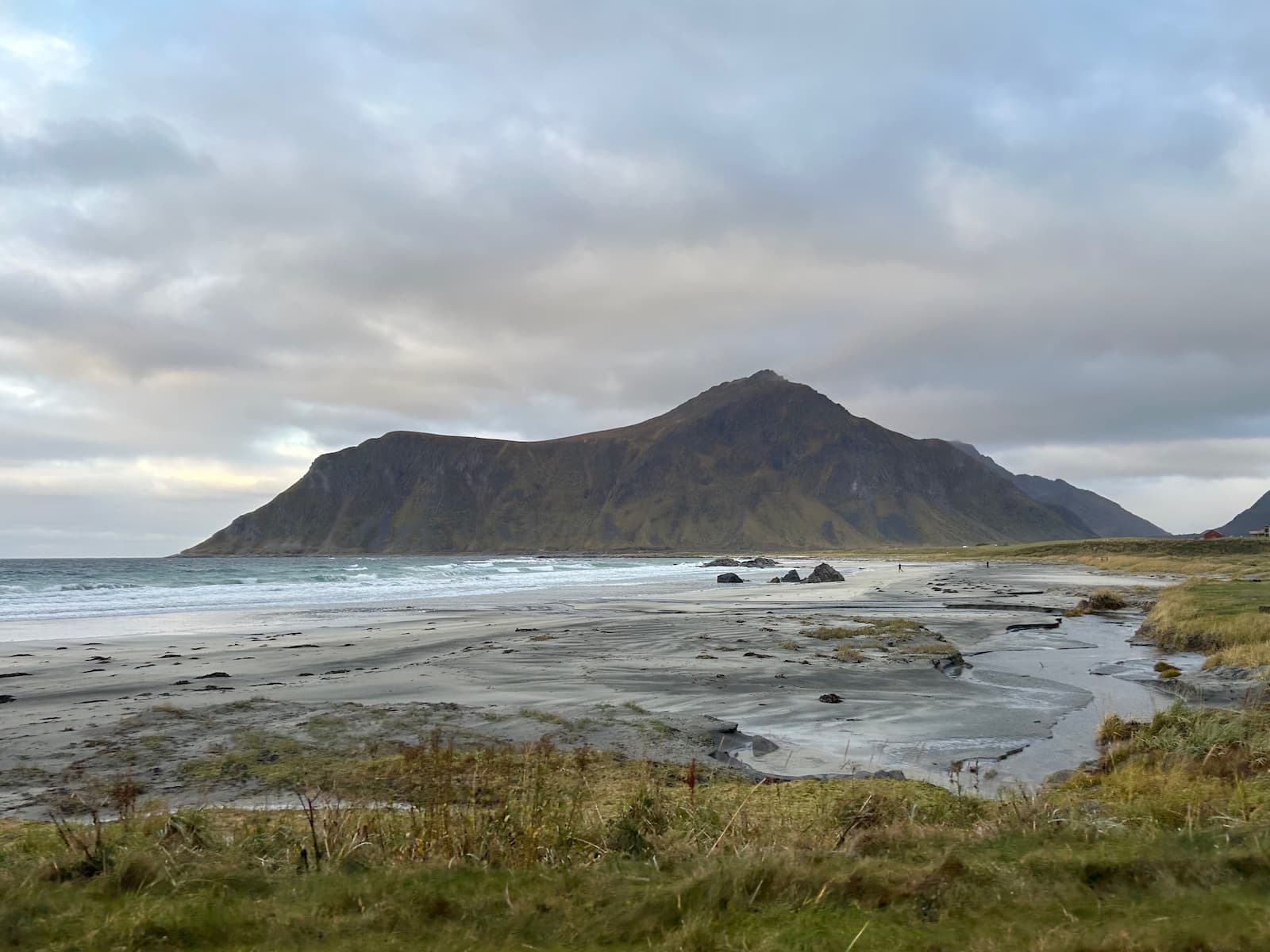
Shagsanden Beach, near Ramberg, Flakstadoya
Just beyond Ramberg, we saw the amazing Fredvang bridges – reminiscent of the Atlantic Road.

Scenery near the Fredvang Bridges, beyond Ramberg, Flakstadoya
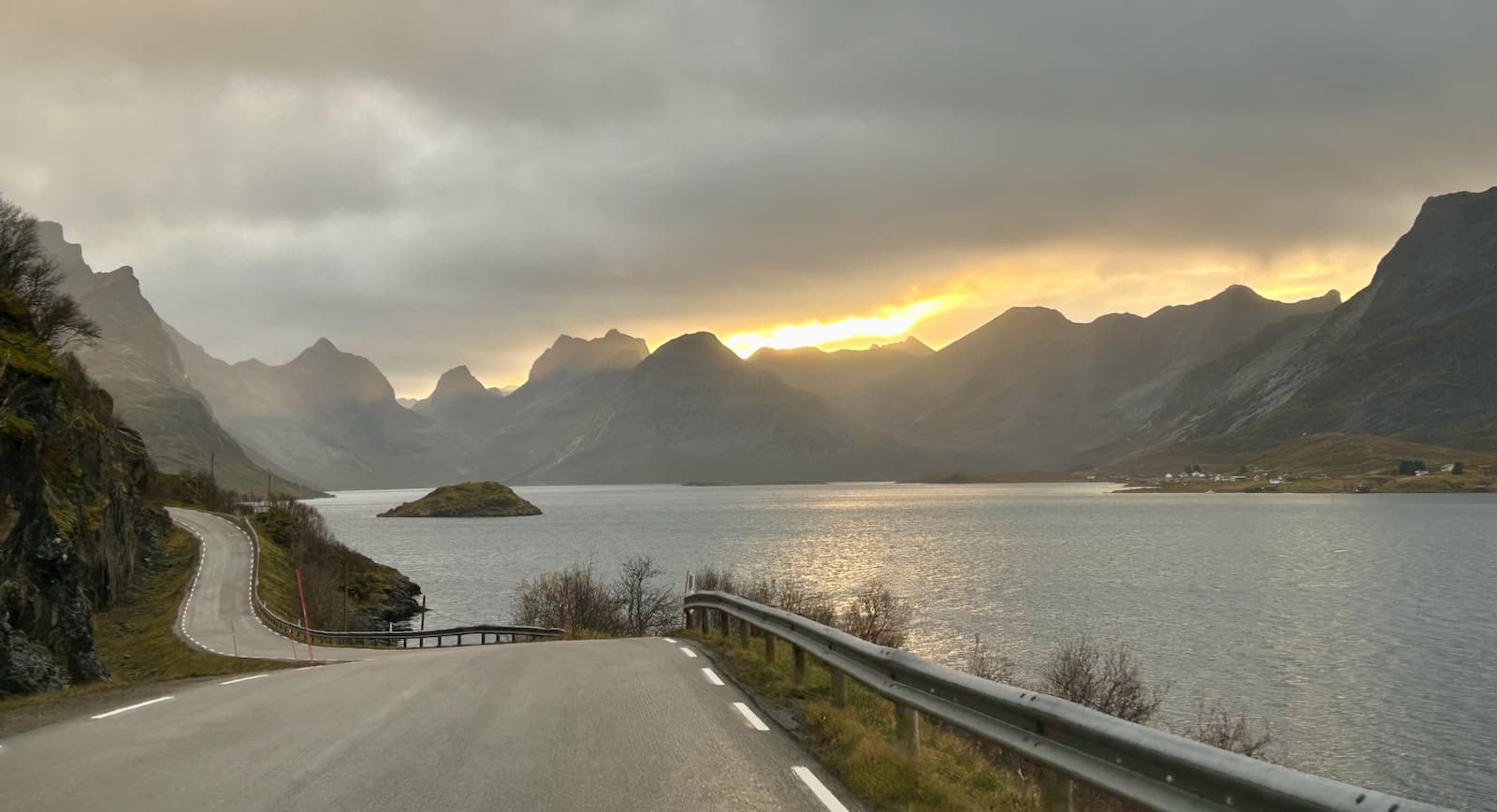
Amazing scenery along the E10, Flakstadoya
We crossed the Kåkern Bridge (Kakernbrua) from Flakstadøya to Moskenesøya and passed through Hamnoya, Olenilsøya and Sakrisoy before arriving in beautiful Reine.
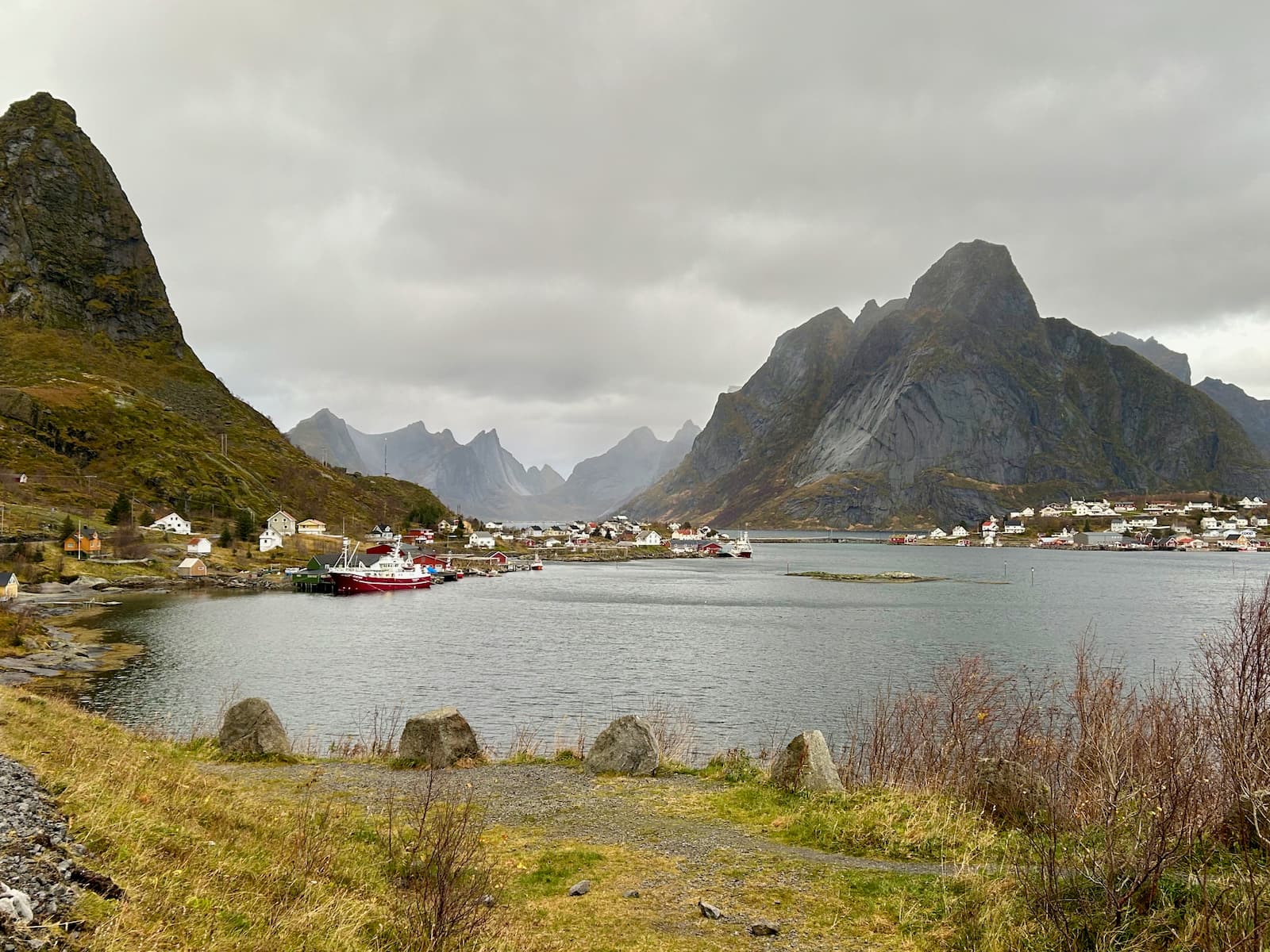
Reine
Reine was a highlight of our visit to the Lofoten Islands. It has a stunning location and is one of the most photographed villages in the Lofoten Islands.
From Reine it was about a 15-minute drive to the beautiful village of A via Sorvagen and Tind.
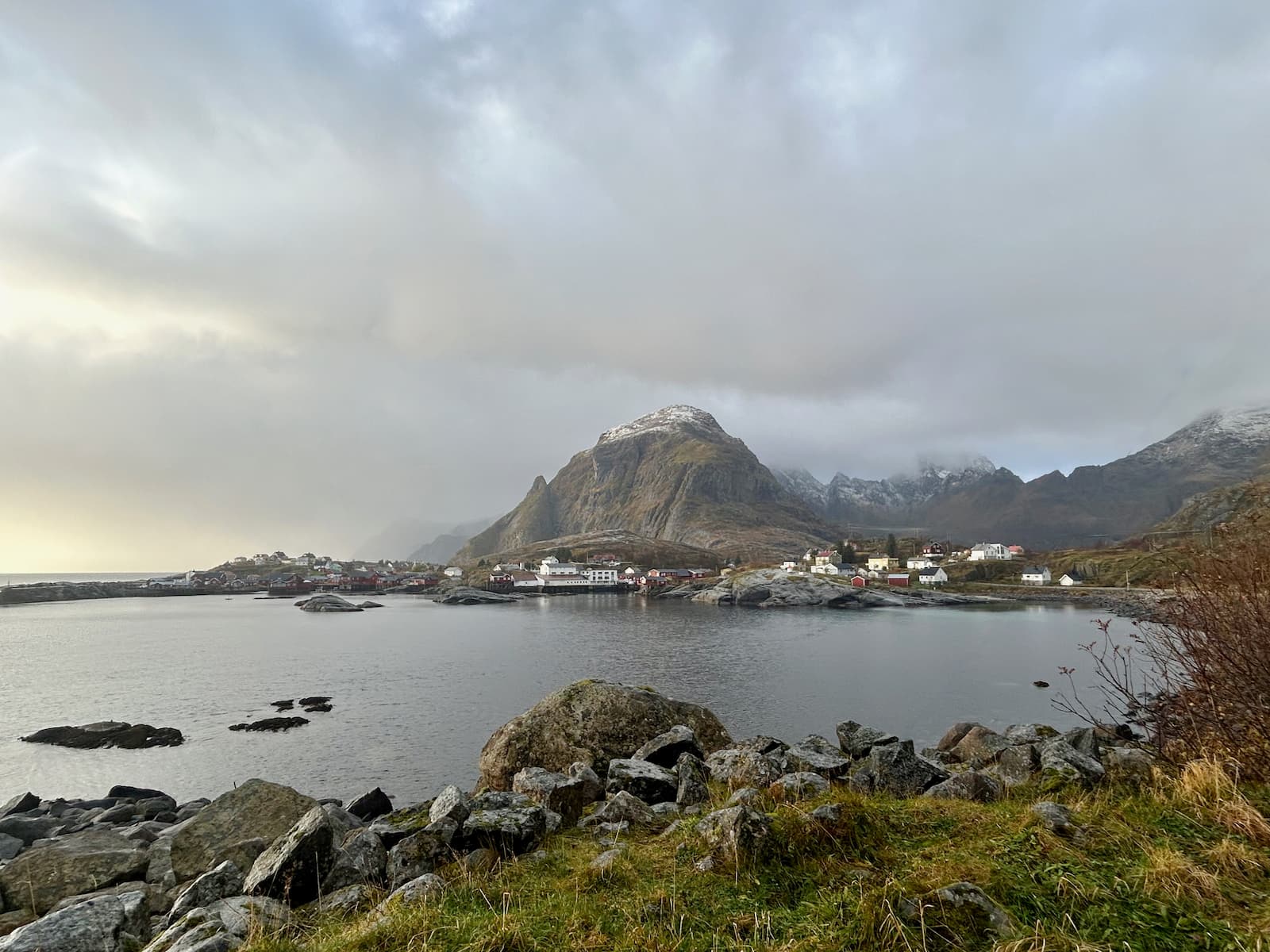
Village of A
The village of A is one of the best preserved fishing villages in northern Norway and is known for the Norwegian Fishing Village Museum and the Lofoten Stockfish Museum.
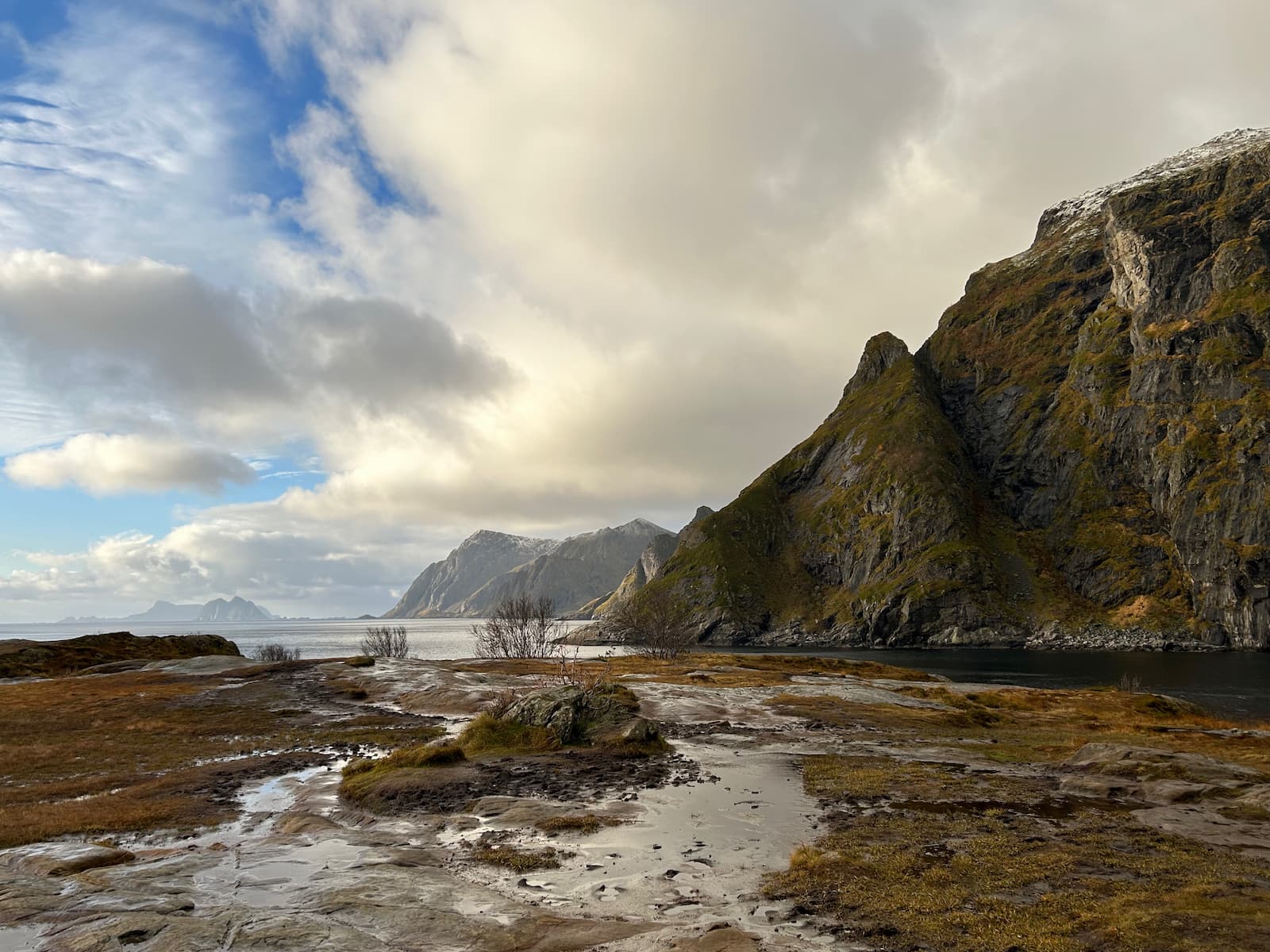
Scenery around the village of A
We would recommend a couple of nights in Reine especially if you want to visit the Norwegian Fishing Village Museum in A.
Our accommodation in Reine was a beautiful house at Andoy Vest Rorbuer Reine – highly recommended.
Reine – Svolvaer – 18 October
After spending the night in Reine, we headed back along the E10. We would spend the night in Svolvaer before driving back to Bodo to return our hire car.
Lofotr Viking Museum, Borg
This is a stop we regret not making (due to time constraints). The Lofotr Viking Museum is built on the site where the largest Viking longhouse ever discovered was found. The museum features:
- reconstructed Viking longhouse
- archaeological exhibition halls
- reconstructed Viking ships
- harbour, boathouses, a blacksmith’s forge, archery and axe throwing
- The Dream of Borg – a short film about life at Borg during Viking times.
The museum is just over an hour’s drive from Reine.
Eggum Nature Reserve
Shortly after Borg, we took a detour off the E10 to Eggum Nature Reserve, just beyond the village of Eggum (it’s one road in and the same road back out to the E10). It is worth the trip. Eggum faces the open Atlantic Ocean and it is a wild part of the coast. There is a memorial plaque to the many fishermen who have lost their lives here. At the carpark is Borga Eggum – the remains of a WWII German radar station. Further along the walking track, around Heimredalsvatnet Lake is an intriguing sculpture of a head (“Hode”) by Marcu Raetz.
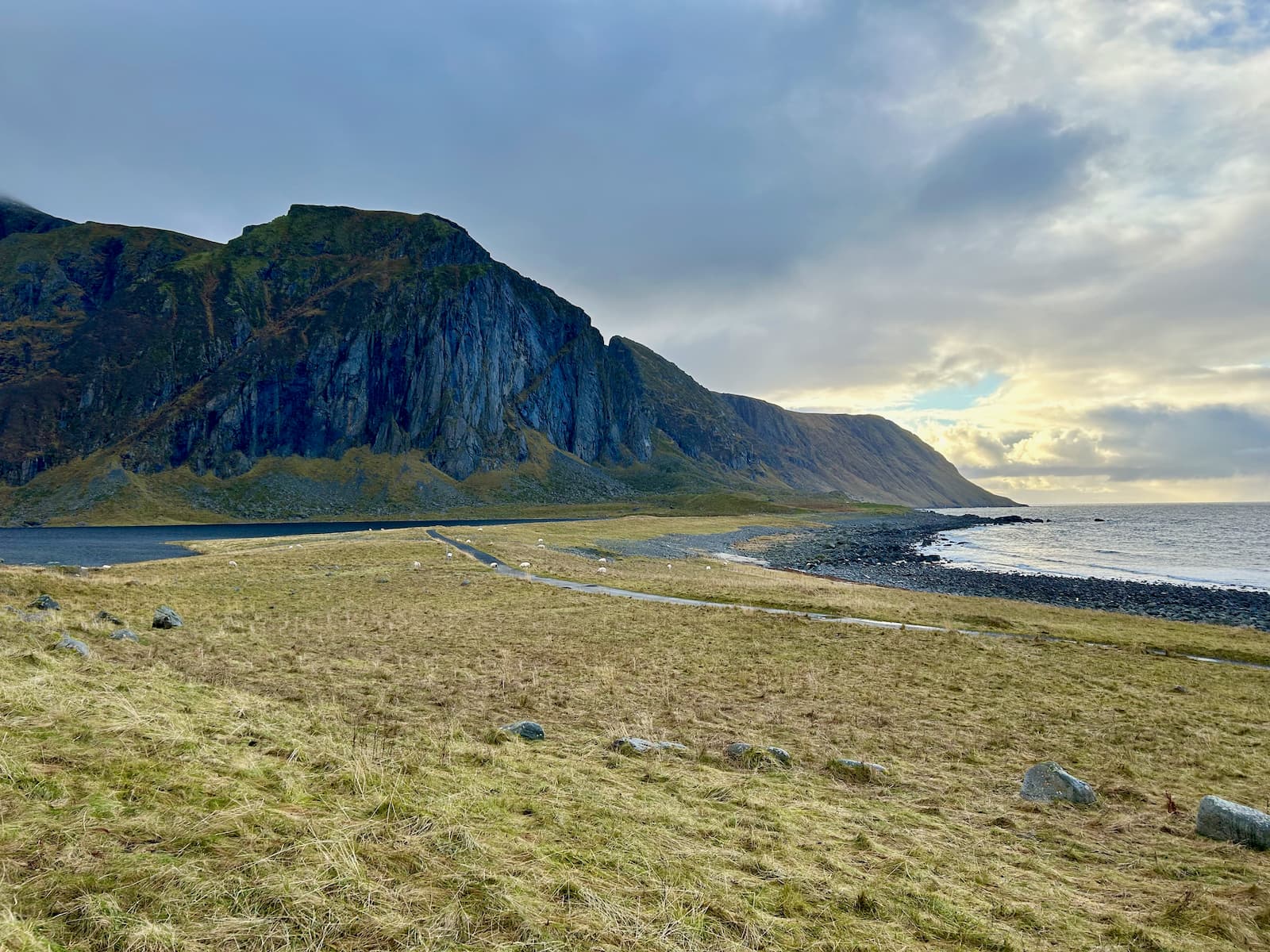
Eggum Nature Reserve
Kabelvaag
Another stop on the way back to Svolvaer was in the pretty town of Kabelvaag – one of the oldest villages in the Lotofen Islands dating back to Viking times. The main part of the town is centred around the harbour – we loved the colourful timber buildings. Of interest there is the Lofoten Museum, Lofoten Aquarium and Espolin Art Gallery. Just outside of town is the Vagan Church (also known as Lofoten Cathedral).
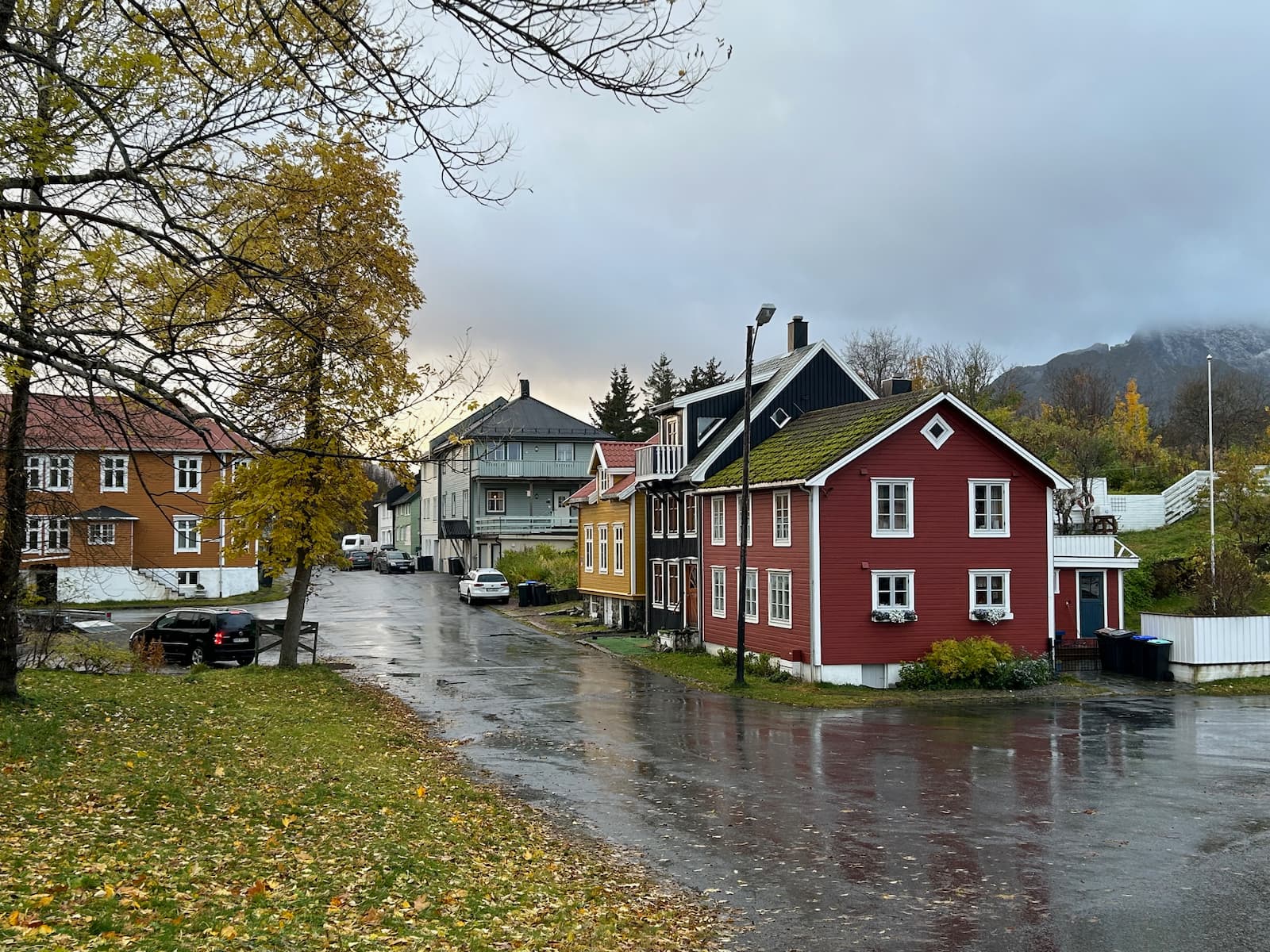
Kabelvaag
From Kabelvaag it was just 5kms to Svolvaer where we stayed the night at Modern Apartment Svolvaer – a comfortable, self-contained apartment.
Svolvaer to Bodo, Fly Bodo to Oslo – 19 October
It was a 5.5 hour drive from Svolvaer to Bodo Airport where we took a Wideroe flight to Oslo. We spent two nights in beautiful Oslo.
Oslo
With just a full day in Oslo we took a two-hour free walking tour with Nordic Freedom Tours – highly recommended.
There is much to see and do in Oslo:
- National Museum
- Opera House
- Akershus Fortress
- Radhusplassen (The City Hall Square) and City Hall building
- Karl Johans Gate – Oslo’s main street running from the Royal Palace to Oslo Central Station
- Royal Palace
- National Theatre building
- Eidsvolls plass (Eidsvoll Square) and the Parliament buildings
- Oslo’s Harbour Promenade
- Munch Museum
- Nobel Prize Museum
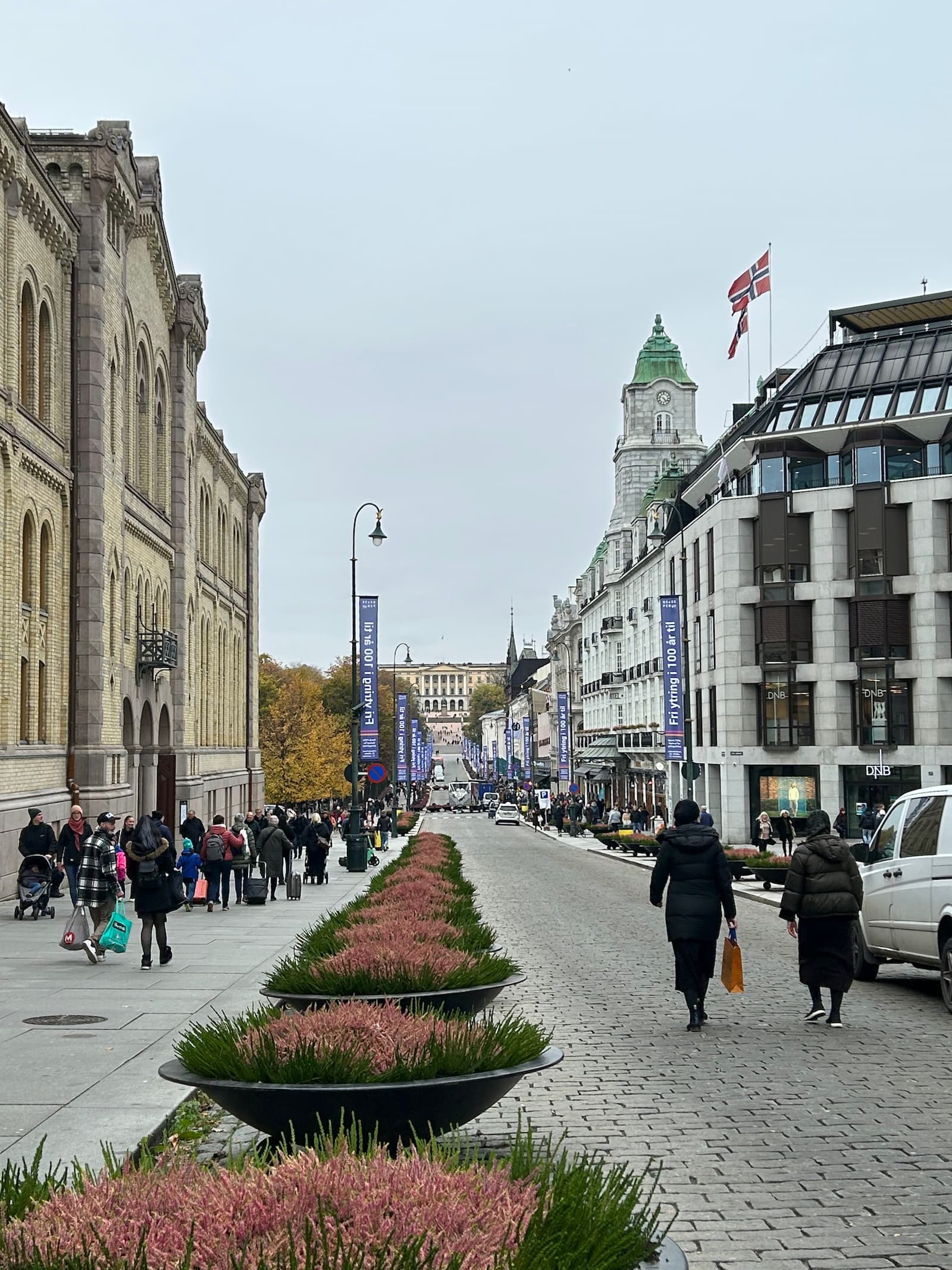
Karl Johans Gate, Oslo
Oslo to Sydney – 21 October
From Oslo we flew Thai Airlines back to Sydney via Copenhagen.
Useful Resources for Planning a Road Trip to Norway:
Visit Norway: Official Travel Guide to Norway Norwegian Scenic Routes
Visit Lofoten: Ferry & Express Boat Timetables to Lofoten
Best Month of Your Life
October 2022

